
The Bounty mutiny
Australian pirates in Japan
Colonial convicts a long way from home
Wildlife Photographer of the Year
Winning images now on show


The Bounty mutiny
Australian pirates in Japan
Colonial convicts a long way from home
Wildlife Photographer of the Year
Winning images now on show
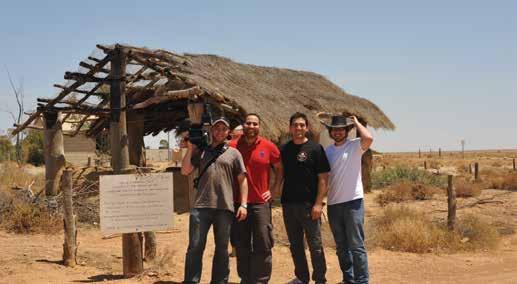
MOST PEOPLE ARE SURPRISED TO LEARN that the museum’s remit includes migration to and from Australia. In fact, we are the only museum focused on the national migration story and the only national cultural institution with a permanent gallery dedicated to migration.
In April this year we published From across the sea – Australia’s national migration story. This e-booklet, on our website, provides an overview of the museum’s impressive achievements in sharing the national migration story.
There are more than 14,450 objects in the national migration collection and our Passengers Gallery is permanently dedicated to the stories of Australia’s migrants. Our Welcome Wall has almost 30,000 names of people who have travelled across the sea to make Australia home, and more than 260,000 people have viewed our migration-themed digital artworks projected onto the museum’s rooftop. We have hosted 29 temporary exhibitions exploring migration issues and history, and how these communities have helped build our nation. We also have a migration education portal for teachers and curriculum-aligned education programs and public programs.
The Australian National Maritime Museum is enormously proud of its role in researching and exhibiting these stories – but all these wonderful accomplishments have been overshadowed by the shocking attacks on Muslims praying in Christchurch on 15 March 2019. All the museum’s staff take incredibly seriously their remit to educate and enlighten Australians on our country’s rich migrant history; so, justified or not, many of us felt a sense of collective failure. This is why I convened a meeting in April of Australia’s migration and major community museums, to discuss the ways in which museums can build greater understanding of diversity to help address discrimination against migrants, refugees and their families.
In May, we began screening Boundless Plains , a documentary created by the Islamic Museum of Australia. It depicts the search by four Muslim men – Jehad Debab, Moustafa Fahour, Ash Naim and Peter Gould – to understand Australia’s Muslim history. They are shown at the replica of Australia’s first mosque in Marree, South Australia. Image courtesy Islamic Museum of Australia
Events in Christchurch and many disturbing attacks on mosques across Australia demonstrate that Islamophobia can lead to the most horrendous acts of terrorism. Muslims have lived in Australia for generations, as our exhibitions show. The first showcase that visitors see in our Navigators Gallery highlights the encounters between Muslim traders from Sulawesi and Aboriginal people in the far north of Australia. These trading relationships were established hundreds of years before European colonisation.
Our new museum alliance has agreed to pursue a major national collaborative exhibition to build greater empathy, as well as conduct a joint research project and collectively develop our educational resources.
As someone who was born overseas of Welsh ancestry with strong cultural ties to South Africa, the Netherlands and Cyprus, I am privileged to lead an organisation that is committed to sharing the stories of Australia’s migrants. And it is my sincere desire that by working together, museums can find new ways to tell the stories of how millions of migrants have contributed to the success of modern Australia.
Kevin Sumption psm Director and CEOAcknowledgment of country
The Australian National Maritime Museum acknowledges the Gadigal people of the Eora nation as the traditional custodians of the bamal (earth) and badu (waters) on which we work.
We also acknowledge all traditional custodians of the land and waters throughout Australia and pay our respects to them and their cultures, and to elders past and present.
The words bamal and badu are spoken in the Sydney region’s Eora language. Supplied courtesy of the Metropolitan Local Aboriginal Land Council.
Cultural warning
People of Aboriginal and Torres Strait Islander descent should be aware that Signals may contain names, images, video, voices, objects and works of people who are deceased. Signals may also contain links to sites that may use content of Aboriginal and Torres Strait Island people now deceased.
Cover Ice-Cave Blues , Georg Kantioler, Italy. Glacier caves are often carved out by water running through or under a glacier’s ice. Georg used natural light to capture the interior of this cave, in Stelvio National Park, Italy, including the distant larch trees and alpine scenery. © Georg Kantioler/Wildlife Photographer of the Year
2 A mutiny and a mystery
Fletcher Christian, the Bounty mutineers and their secret settlement
10 Elysium Arctic
Artists and scientists act for environmental awareness
14 International Project of the Year
Gapu-Mon_uk Saltwater honoured with major award
16 Celebrating heritage and tradition
The MyState Bank Australian Wooden Boat Festival 2019
22 The repulse of the Cyprus Colonial convict pirates in 1830s Japan
30 Bringing science back aboard Endeavour Museum and CSIRO collaborate on a pilot learning program
32 Treasures see the light of day
Changes to the Copyright Act open more collection items to the public
36 A Californian conflict
Gold rush clashes: the Sydney Ducks and the San Francisco 49ers
42 Honours for Wiradjuri heroes Yarri and Jacky Posthumous bravery awards for 1852 flood rescuers
44 Mutiny on the Montserrat
The 60th anniversary of a troubled migrant voyage
48 Message to Members and museum events for winter Your calendar of activities, talks, tours and excursions afloat
54 Winter exhibitions
Bligh: Hero or Villain?, Massim Kenu, Elysium Arctic and more
58 Collections
Classic Aussie ingenuity: inventing the self-propelled shark-proof cage
62 Foundation
Introducing the Captain’s Circle, our new supporters’ group
64 Australian Register of Historic Vessels
A sleek ski-boat and a functional flood boat: a study in contrasts
68 Tales from the Welcome Wall Workers in tulle: The English lacemakers of Calais
72 Readings
Empire of the Winds by Philip Bowring
74 Currents
Vale John Hooke CBE; model ships on show at Expo 2019
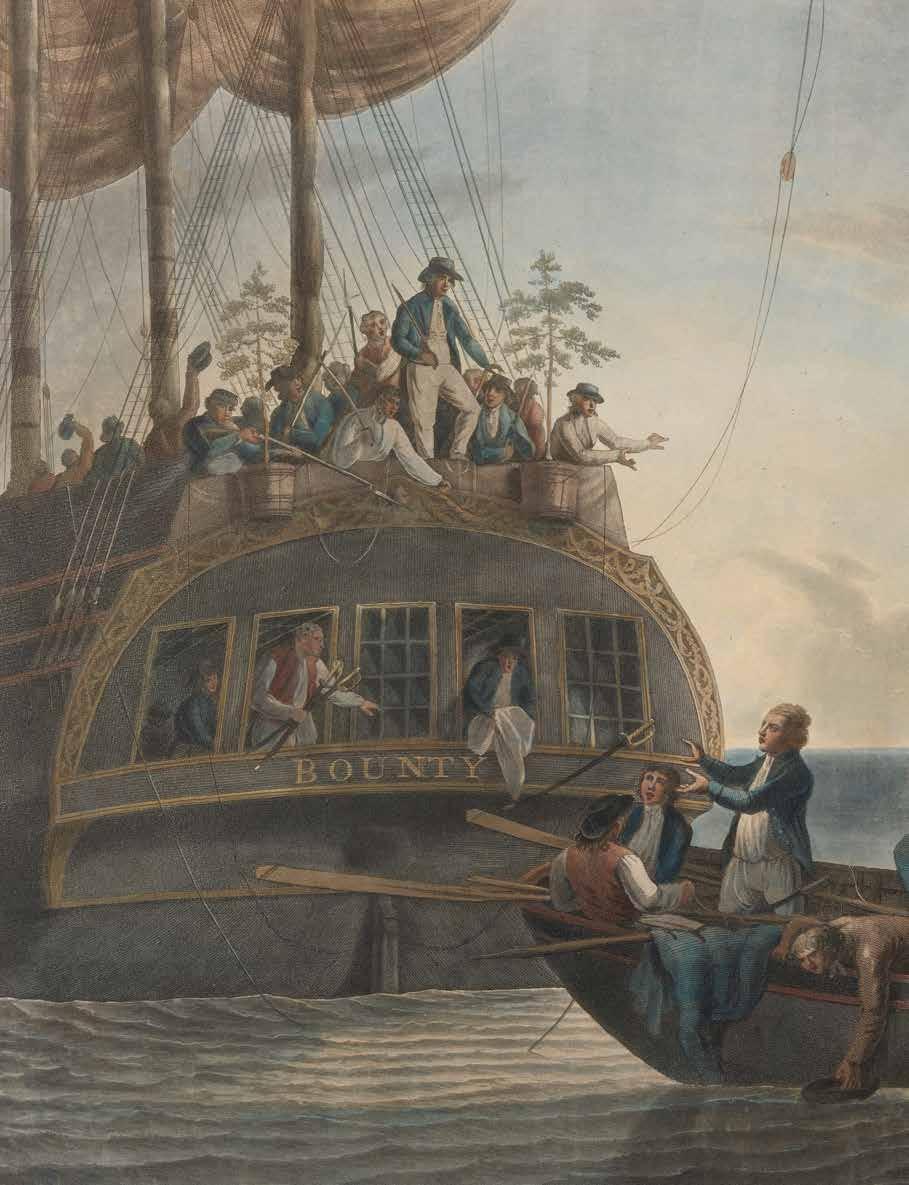
In a remarkable feat of seamanship, Bligh and the men in the open boat survived a six-week voyage to finally arrive at Timor
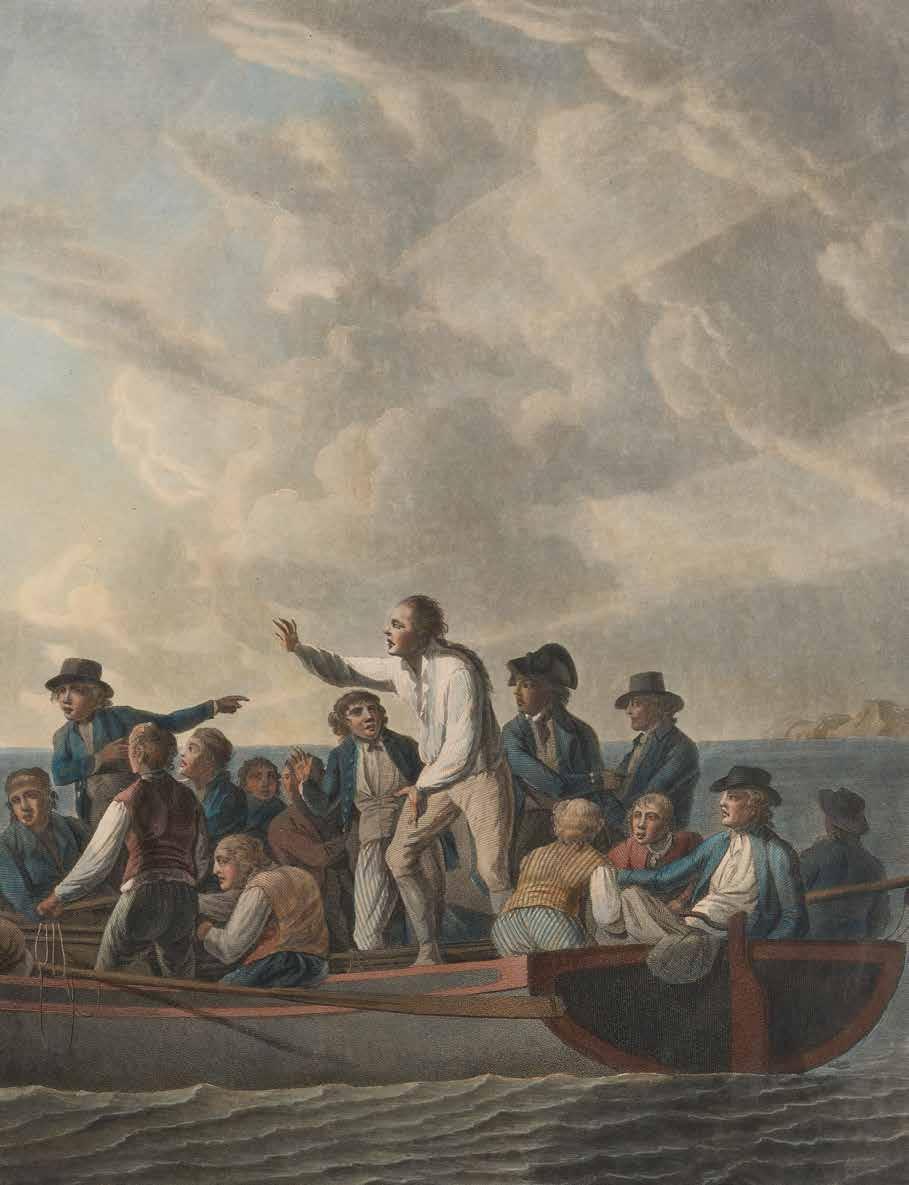
In July the museum will open its new exhibition Bligh – Hero or Villain?, which looks at the extraordinary life of William Bligh, a British naval officer whose career would have been largely unremarkable but for a mutiny aboard his ship the Bounty in 1789. This made his name a household word, and his actions the subject of fierce public debate for the rest of his life. By Head of Research, Dr Nigel Erskine .
Bounty ’s mission was to transport breadfruit plants from Tahiti to British sugar plantations in the Caribbean to provide food for slaves
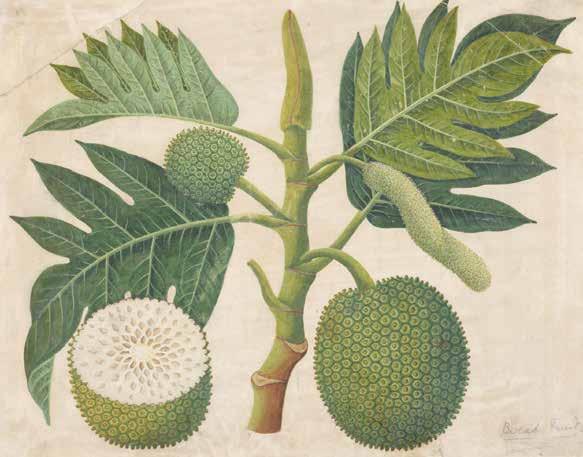
THE BOUNTY ’S MISSION WAS TO SAIL from England to Tahiti, where the expedition’s gardeners would collect young breadfruit plants to take to Britain’s colonies in the West Indies, where it was hoped they would become a staple food for the slaves working on the sugar plantations. The ship had been delayed in its voyage out and arrived at Tahiti at a time when the breadfruit plants were not ready to cultivate. As a result, Bligh was forced to wait five months before the plants were collected and the ship ready to leave – long months during which discipline on board lapsed. Three weeks after leaving Tahiti, some of the crew mutinied and took over the ship.
The mutiny occurred in the early hours of 28 April 1789, when Fletcher Christian (acting lieutenant and officer of the watch on duty) and other crew members armed themselves and, breaking into the captain’s cabin, woke and arrested Bligh. In the hours that followed, Bligh and 18 loyal followers were forced into Bounty ’s seven-metre launch and set adrift, while Christian and the other 24 mutineers remained aboard the ship.
The mutiny happened very quickly and apparently without warning, and although there was a hard core of mutineers centred about Christian, others had simply found themselves unwittingly swept up in events.
In a remarkable feat of seamanship, Bligh and the men in the open boat survived a six-week voyage to finally arrive at the Dutch settlement of Coupang on the island of Timor. After recuperating and making their way to Batavia (now Jakarta), Bligh and the surviving men ultimately made their way back to England. But what happened to Fletcher Christian and the Bounty mutineers?
At the time of the mutiny, Bounty was in sight of the volcanic island of Tofua, about 2,700 kilometres west of Tahiti, where many of the mutineers had established relationships with Polynesian women. The mutineers knew, however, that sooner or later the Royal Navy would come searching for them, and Tahiti would be the first place they looked.
Our knowledge of this part of the story is based on the account written by mutineer James Morrison, bosun’s mate aboard Bounty, and an observant and capable writer. Looking through Bligh’s books left on board, Fletcher Christian found a reference to Captain Cook’s discovery of the island of Tubuai, some 640 kilometres south of Tahiti, and it was there that he took the ship, arriving a month after the mutiny.
At Tubuai, the mutineers found the indigenous inhabitants unwelcoming. Despite this, Christian thought it was a suitable place to establish a permanent settlement. He determined that after a brief stay, they would sail to Tahiti to get animals and supplies, and to bring their Polynesian former partners and friends back to the island.
Ultimately the attempt to settle on Tubuai lasted just two and a half months, and in the face of escalating armed opposition to their presence and deteriorating mutineer morale, Christian agreed to return to Tahiti, where he allowed those who wished to leave the ship to do so. Sixteen mutineers chose to go ashore; nine (including Fletcher Christian) remained with the Bounty The ship remained at Matavai Bay for a day while the men’s sea chests, hammocks and a proportion of the arms, ammunition and other supplies were shared out and taken ashore in the only remaining serviceable boat.
Breadfruit ( Artocarpus incisa). Rex Nan Kivell Collection, National LIbrary of Australia, nla.obj-135498865
02
A highly sanitised view of life on a British sugar plantation, from Ten views in the island of Antigua, William Clark, London, 1823. © 2010 The British Library Board
With the departure of the Bounty from Tahiti, all trace of Fletcher Christian and his followers disappeared

01
Rear-Admiral William Bligh, Alexander Huey, 1814. National Library of Australia nla.obj-136207002
02
Transplanting of the bread-fruit trees from Otaheite [Tahiti], painted and engraved by Thomas Gosse, 1796. National Library of Australia nla.obj-135292190
Three weeks after leaving Tahiti, part of the crew mutinied and took over the ship

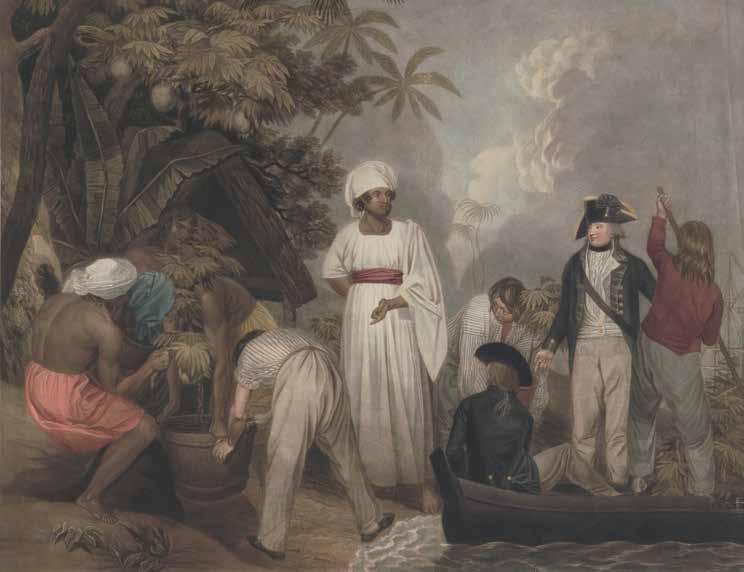
In the early hours of the morning, when the Bounty left Tahiti for the last time, there were some 26 Polynesians aboard in addition to the nine mutineers, but this number was reduced when one woman chose to jump overboard and swim ashore, and when some of the older women were transferred to a passing canoe. With the departure of the ship, all trace of Fletcher Christian and his followers disappeared. Not until 1808 – 19 years later – was the mystery of what happened to them finally solved.
The mutineers who stayed at Tahiti, were, as anticipated, hunted by the Royal Navy. In March 1791, the frigate HMS Pandora dropped anchor in Matavai Bay and soon sent armed parties ashore to find the Bounty men. Of the 16 who had landed from the Bounty, two had since been murdered. Having completed part of his orders by capturing the mutineers living at Tahiti, Pandora ’s commander, Captain Edwards, next aimed to find Fletcher Christian and the Bounty, and so he headed west across the Pacific, searching the islands for any sign or word of the mutineers.
But he was searching in the wrong direction, steadily putting more and more miles between his ship and the mutineers, and drawing ever closer to the great and hazardous barrier reefs that protect the north-east coast of Australia.
Hearing that the navy had sent Pandora to the Pacific, Bligh had predicted that Captain Edwards would never find his way through Endeavour Strait. His words proved prophetic when, after months of unsuccessful searching, HMS Pandora was wrecked on a reef off the Australian coast, in August 1791.
Four mutineers and 31 of Pandora ’s crew were drowned in the wreck. Like Bligh more than two years earlier, Captain Edwards and his people were forced to take to open boats and make their way to Coupang.
The ten surviving Bounty prisoners eventually returned to England where, at a court martial in April 1792, four were acquitted and six were found guilty and sentenced to death. Only three were actually executed; two received the king’s pardon; and another was discharged due to a procedural error.
Of the two men who received the king’s pardon, midshipman Peter Heywood benefited greatly from his influential family connections. Fletcher Christian’s family was also influential. Although unable to deny his role as the instigator of the mutiny aboard the Bounty, they worked hard to suggest that Bligh’s constant abuse of the officers and crew had ultimately driven Fletcher Christian to mutiny. Edward Christian, Fletcher’s elder brother and a barrister, did this by publishing the minutes of the court martial’s proceedings with an appendix containing ‘A full account of the real causes and circumstances of that unhappy Transaction, the most material of which have been hitherto withheld from the Public’.
At the time of the court martial, Bligh was at sea in command of a second expedition to bring breadfruit to the West Indies and was therefore unable to defend himself against Edward Christian’s publication and the damage it did to his reputation. He must have received reports, but not until he returned to England did Bligh fully appreciate how much public sentiment had shifted against him.
Edward Christian had interviewed several of the mutineers for his damning publication, and after returning to England, William Bligh set about a similar process, gathering supportive affidavits from men who had remained loyal during the mutiny. Some, such as the sailmaker Lawrence Lebogue – who had sailed with Bligh in the West Indian trade and on both the Bounty and Providence breadfruit expeditions – gave their information willingly, but there is also evidence of Bligh’s attempts to manipulate statements.
In a letter to his nephew Francis Godolphin Bond, who had been his first lieutenant aboard the Providence for the second breadfruit voyage, Bligh asked Bond to get Michael Byrne (the almost-blind fiddler aboard the Bounty, who was then serving under Bond) to answer a set of carefully contrived questions calculated to show Bligh in a favourable light.
If he disavows having said anything disrespectful of me to Christian, and affirms, which every man must, that I did all that a good Commander could do, and as you know, I have done; I will be obliged to you to write it down.
When you have arranged what Byrne says, I think it would be well to make him write it himself if he can see well enough.
Throughout the second half of 1794, Bligh gathered material and in December published his rebuttal of Edward Christian’s accusations in ‘Answer to certain Assertions’. In the end he didn’t use Byrne’s statement, but the evidence still surviving in the archives shows the extreme lengths to which he was prepared to go to protect his reputation.
By this time, Fletcher Christian and several other mutineers were dead. When the Bounty had departed from Tahiti for the last time in September 1789, it had sailed south-east, away from the main Society Islands group. The attempt to settle at Tubuai had proved a disaster due to the opposition of the Polynesian inhabitants and now, with far fewer mutineers in his party, Fletcher Christian had resolved to find a remote and uninhabited island to establish a settlement.
After a period of unsuccessful searching – during which they sailed as far west as the Tongan archipelago – once again Bligh’s books left on board provided a possible place to look. In an account of Philip Carteret’s 1767 voyage around the world in HMS Swallow, Christian found a reference to an island that: … appeared like a great rock rising out of the sea: it was not more than five miles in circumference, and seemed to be uninhabited; It was however, covered with trees, and we saw a small stream of fresh water running down one side of it. I would have landed upon it, but the surf, which at this season broke upon it with great violence, rendered it impossible.

Adding to this promising description, the location of the island – which Carteret had named Pitcairn – seems to have been incorrectly identified through a navigational error, and Captain Cook had failed to find it on either his second or third voyage.
Reasoning that Carteret had made an error in calculating his longitude, but that the latitude he recorded for Pitcairn was probably correct, Fletcher Christian took the ship to that latitude and sailed east until finally sighting the island in January 1790. A search of the island showed that it was indeed uninhabited and had fresh water, good soil and lush vegetation. Very soon the mutineers started to take ashore everything from the ship that they thought they might need.
Apart from the nine mutineers (Fletcher Christian, Edward Young, John Mills, Isaac Martin, William Brown, William McCoy, John Adams and John Williams), there were five Polynesian men, one boy, 12 women and a baby girl aboard when the Bounty arrived at Pitcairn. However unlikely, these 28 were to form a settlement that continues to the present day.
As Carteret had thought, there was no secure anchorage at Pitcairn, and after removing all they wanted from the ship, the mutineers set fire to it, in what is now known as Bounty Bay, to hide all evidence of their existence on the island. In the same manner, when building their houses, they located them behind a screen of vegetation to make them invisible to any ship that might approach the island, and then relied on the rugged coastline to dissuade closer investigation.
Although long uninhabited, there were ample signs of earlier Polynesians living on the island, and the new settlers soon discovered rock carvings, a morai and a site where stone for tools had been quarried, as well as many food plants typically cultivated by Polynesians.
In establishing the settlement, the mutineers divided the island among themselves and each European had a Polynesian woman to live with. This arrangement left only three Polynesian women as partners for the six Polynesian men, leading to violent jealousies that were soon exacerbated by the death of mutineer John Williams’ partner, Faahotu.
When Williams took another woman from those living with the Polynesian men, the men decided to kill the Europeans and throw off their servitude. Unfortunately for them, the women warned the mutineers and two of the men were killed, thus establishing a brooding end to the violence.
In 1793, however – just three years after settling on the island – five of the mutineers, including leader Fletcher Christian, were killed when the remaining Polynesian men rose up again. But their victory was short-lived and they in turn were killed.
After these killings, life on the island remained relatively stable until 1799, when mutineer William McCoy suicided by jumping off a cliff into the sea. Later that same year, Edward Young and John Adams killed Matthew Quintal after he threatened them and their families. When Edward Young succumbed to an asthma attack in 1800, the mutineer John Adams was left the last man standing, to become the unlikely patriarch of a settlement of women and children.
John Adams was listed on the Bounty muster as Alexander Smith (a common ruse of seamen who had deserted).
After the violence of the first decade of settlement, and now finding himself responsible for the community, he turned to religion. Among the books that had been brought to the island he found a prayer book, which he used to instil at least the basic tenets of Christianity into the Pitcairn community.
Eighteen years after the arrival of the Bounty at Pitcairn, the community’s isolation was at last broken
Pitcairn Island from the east. To the left of the image is Bounty Bay, where the ship was deliberately destroyed. © Claude Huot/ Shutterstock
Eighteen years after the arrival of the Bounty at Pitcairn, the community’s isolation was at last broken when the American whaleship Topaz happened to stop at the island. Mindful of his mutineer status, Adams remained ashore, but the Topaz ’s crew was surprised when a canoe paddled out from the shore carrying several young men, and amazed when they hailed the ship in English! Very soon Topaz ’s captain, Mayhew Folger, realised that he had discovered the home of the Bounty mutineers and finally solved the mystery of what happened to Fletcher Christian and the Bounty
The 19th century and beyond
Located in the middle of the Pacific, Pitcairn gradually became a regular port of call for whalers and other ships during the 19th century. Six years after the Topaz visited, John Adams seemed destined to hang when the British warships Briton and Tagus stopped at the island. Instead, the ships’ commanders allowed him to remain on the island, so impressed were they by the religious influence he held over the community of just over 40, comprising seven of the original women settlers and very young men and women. Adams died on the island in 1829. A few sailors had chosen to join the Pitcairn community before his death and one of these, George Hunn Nobbs, became the island’s leader.
British warships became regular visitors, and over time the Pitcairners looked to the visiting commanders to rule in local disputes, ultimately leading to Pitcairn becoming a Protectorate of Great Britain in 1838. Today Pitcairn is a British Overseas Territory.
By the middle of the 19th century, with the population close to 200 and after a series of droughts had ruined crops, the island’s leaders began looking for a larger place to resettle the community. After discussions with the British authorities, in 1856 the entire population was removed to Norfolk Island.
From its earliest days, Norfolk Island had been a convict settlement, and although the convicts had all been removed before the Pitcairners arrived, the prison infrastructure and other buildings remained fully intact and some of these were soon occupied by Pitcairner families. Today a large percentage of Norfolk Island’s population still traces its history back to Pitcairn.
And what of Pitcairn Island? A few years after the move to Norfolk Island several families chose to return to Pitcairn, establishing the basis of the population that continues to live there. Whereas overpopulation confronted their forefathers, today’s Pitcairn community faces the issues of a dwindling and ageing population, with an ever-decreasing number of islanders available to undertake the routine heavy work of living on a remote island in the Pacific. Only time will tell if they are able to turn things around, but the future is certainly full of challenges.
Bligh – hero or villain?
As the title of the exhibition suggests, Bligh – Hero or Villain? asks visitors to judge Bligh based on his actions throughout his long career. It features ‘treasure’ objects – such as the notebook Bligh used during his epic open-boat voyage, the Bounty ’s log with Bligh’s description of the mutineers, the record book from the Royal Botanic Gardens at Kew, and Bligh’s signet ring. It also looks at his interactions with family, fellow officers and patrons through immersive and interactive experiences, including a wall of animated (and very vocal) portraits and a simulated boat experience. We are pleased to say that this is not your traditional Bligh exhibition, so expect the unexpected!
1 Bligh to Francis Godolphin Bond, 26 July 1794, reproduced as letter 35 in Mackaness, G, Fresh Light on Bligh – being unpublished correspondence of Captain William Bligh and Lieutenant Francis Godolphin Bond, RN; original manuscript BND/1 in Caird Library, National Maritime Museum, London.
2 Hawkesworth, J 1773, An Account of the Voyages by Commodore Byron, Captain Wallis, Captain Carteret and Captain Cook, Strahan and Cadell, London, 3 vols.
Dr Nigel Erskine became aware of the Bounty story in 1987 when he and his wife stopped at Pitcairn Island for a few days while sailing across the Pacific. Meeting the descendants of the Bounty mutineers sparked a lifetime interest, and later as an archaeologist, he returned to Pitcairn to investigate the remains of the Bounty, eventually leading the team that raised the last Bounty cannon from beneath the surf of Bounty Bay. During that period he also worked on the Queensland Museum’s excavation of HMS Pandora, the ship sent by the Admiralty to search for the mutineers in the Pacific.
In 2000 he was appointed Director of the government museum at Norfolk Island, home of the Pitcairn Islanders after 1856. In 2004 he came to the Australian National Maritime Museum, where he has pursued the Bounty story nationally and abroad.
Bligh – Hero or Villain? opens at the museum on 26 July. An exhibition catalogue is in production and will be available from the Store.
We are now seeking donations to support the development of Bligh: Hero or Villain?. Donations can be made online at sea.museum/donate or call the Membership office on 02 9298 3646.

A team of explorers, photographers and scientists banded together to inspire social change in Elysium Arctic, the museum’s newest outdoor exhibition. Sailing through Svalbard, Greenland and Iceland, the Elysium team braved subzero temperatures and uncertain seas to capture the Arctic on film. Their goal was to document the effects of climate change on the unique Arctic ecosystem through art and science. What did they find in the world’s northernmost regions?
Darrienne Wyndham explores the incredible stories behind Elysium Arctic.

Michael Aw has spent his career documenting the diverse flora and fauna that populate the marine environment
MICHAEL AW BELIEVES IN MAGIC. The internationally acclaimed wildlife photographer, explorer and conservationist has spent more than two decades shooting across the globe, and is certain that if magic exists, it can be found in the ocean. From the lush tropics of the Coral Triangle to the teeming waters of South Africa’s Sardine Run, Aw has spent his career documenting the diverse flora and fauna that populate the marine environment. It was this passion that drove him to found Elysium Epic, a conservation group with a difference. As well as being an activist, everyone engaged in Elysium Epic is an artist, a photographer or involved with marine science. Every few years, Aw handpicks a team to embark on an expedition to one of the world’s at-risk marine environments. In 2015, the Elysium team travelled as far north as they could go and arrived in the wilds of the High Arctic, a region populated by polar bears and devastated by climate change.
Elysium, assemble!
Aw called on old friends and new during the preparation for Elysium Arctic, securing the polar-certified vessel Polar Pioneer through Aurora Expeditions. Aw wanted to produce a body of work that documented the effects of a changing climate on the delicate Arctic ecosystem. Each photograph would showcase the region, inspiring others to fall in love with the Arctic and join the crusade to save it. These photographs would become the base of the Elysium Arctic exhibition. 01
Michael Aw doesn’t ask just anybody to join him on an Elysium expedition. His carefully chosen team totalled 66 people, including crew and Aw’s two young children. His first recruits were fellow photographers David Doubilet and Jennifer Hayes, who had joined him on a previous expedition to the Antarctic. Hayes and partner Doubilet are prominent members of National Geographic ’s Explorers Club, with Doubilet winning the prestigious Lowell Thomas Award for outstanding photographic exploration in 2000. After hearing of Aw’s new venture, they jumped aboard immediately. Doubilet describes the expedition as ‘one of the most rewarding experiences of my ocean life, capturing the sights, sounds and soul of this world to create a body of work that inspires change’.
Another colleague whom Aw was thrilled to include was Dr Sylvia Earle, who acted as chief scientist for the expedition. One of the world’s foremost ocean activists, she is the founder of Mission Blue, SEAlliance and Deep Ocean Exploration and Research, and the first female Chief of the US National Oceanic and Atmospheric Administration. Known in the marine science community as Her Deepness, Dr Earle has logged more than 7,000 hours underwater and led 100 expeditions. Celebrating her 80th birthday on board Polar Pioneer, she snorkelled through icebergs at 81°N and enjoyed a cocktail on the sea ice.
On 28 August 2015, the team left Longyearbyen Fjord in Svalbard under a heavy Arctic sky. As they travelled in a northward loop, the temperature plunged to -3°C at the expedition’s northernmost point, 81°26.876'N and 17°13.737'E.
The Arctic Circle is an imaginary line drawn across the top of the globe, traversing the upper regions of Canada, Russia, Alaska, Greenland, Norway and Iceland. Known by children worldwide as the home of Santa Claus, the Arctic is riotous, colourful and freezing cold. The landscape is diverse and dramatic, encompassing sea ice, tundras, mountains and 14 million square kilometres of ocean. Beloved wildlife such as reindeer, polar bears, seals and puffins inhabit the cliffs and valleys. Glaciers calve in the great bays of the Arctic, producing enormous icebergs that cruise silently through the ocean. The reflective cap of Arctic ice also plays an important role in regulating the climate. ‘Sea ice reflects the light and heat of the sun back into space and helps keep our planet cool,’ explains Aw. ‘As sea ice melts, dark ocean water is revealed and it absorbs heat. More heat means more melt and more exposed ocean, and the poles are warming faster than anywhere else on our planet.’
Arctic puffins, Svalbard. Image Michael Aw 02 Polar Pioneer enters pack ice, Svalbard. Image James Stone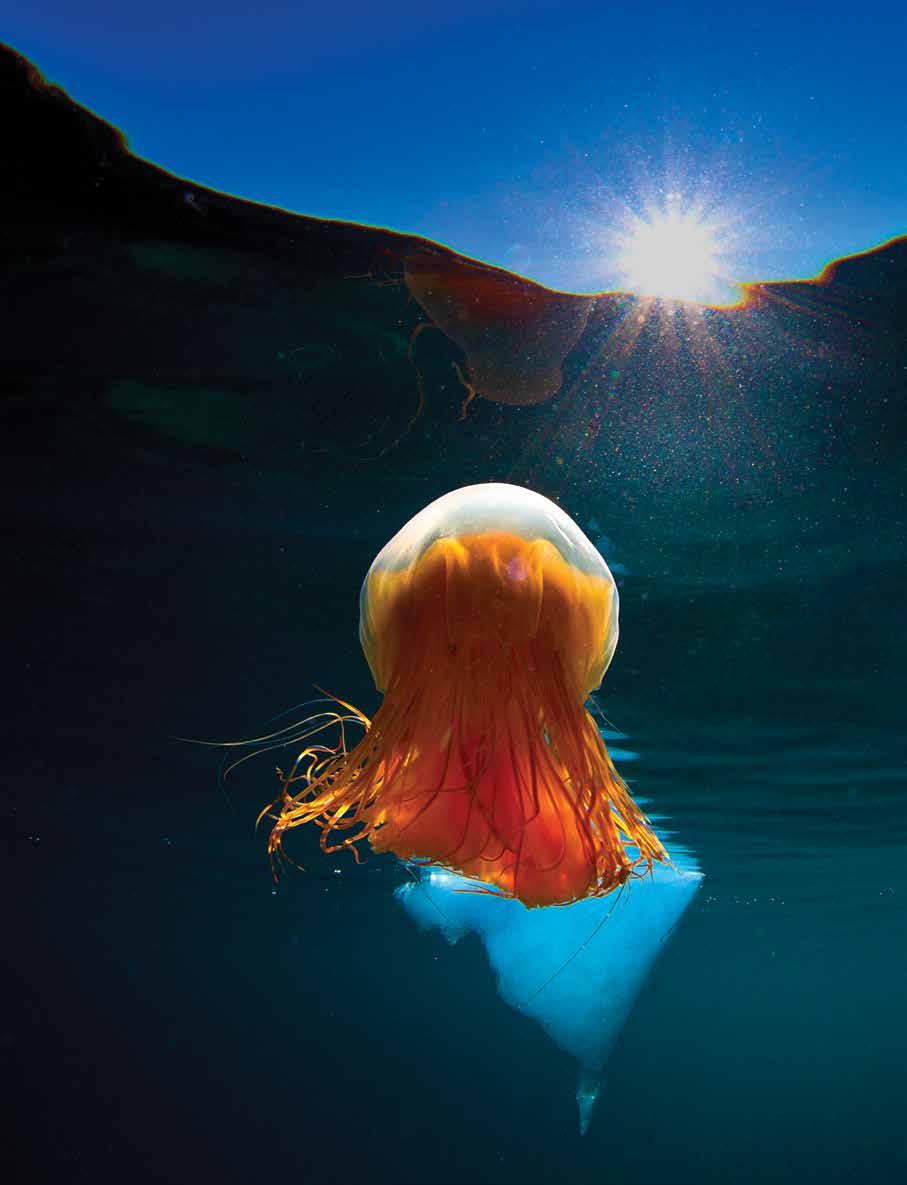
It’s not too late to save the Arctic’s delicate ecosystem. ‘No-one can do everything, but everyone can do something’, says Michael Aw
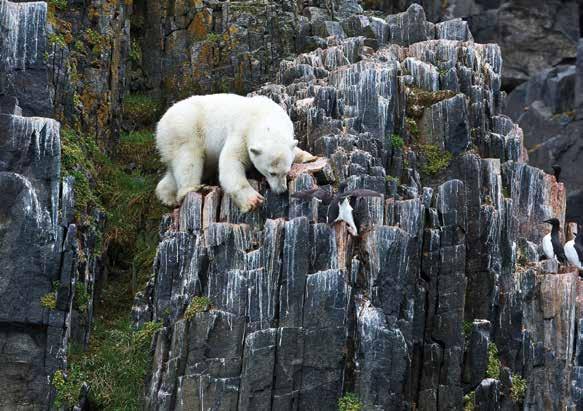
The high Arctic made an unforgettable impression on the Elysium team. From long dives with harbour seals and walruses to snorkelling with giant icebergs, every day was different. After a week with no sightings of any polar bears, artist Wyland decided to make one for himself. Using a shovel, Wyland traced a huge polar bear in the fresh snow, with coffee grounds marking out a nose, mouth and two dark eyes. The 35-metre sketch was the largest piece of art ever created in the Arctic, and might have evoked some of Aw’s ‘ocean magic’ – the team saw their first polar bear the following evening.
Science writer Cheryl Lyn Dybas described the Arctic as ‘beginning and ending with ice’. Since 1992, more than 80% of the Arctic ice platform has been lost. This is a greater melting pace than at any other time in human history, posing a huge threat to wildlife habitats and hunting methods. Polar bears use sea ice to trap prey, sniffing out a seal’s breathing hole and waiting for the seal to surface. As sea ice melts, the bears are forced to roam for their food, even eating human garbage. The Elysium team witnessed a young polar bear arduously climbing bird cliffs at Alkefjellet in search of guillemot chicks to eat. ‘It was akin to someone climbing a mountain in Yosemite for a bag of chips,’ says Aw.
Reminders of the region’s environmental threats were never far away. ‘Sometimes we would sit in near silence just taking in the ethereal scenery,’ says project manager Alex Rose:
We could hear an extremely faint but constant popping sound [that] was coming from tiny air bubbles in the ice bursting as they melted in the unseasonably warm water. Imagine walking across a sheet of bubble wrap – that’s what it was like.
The Polar Pioneer ’s captain helped artist Toby Wright to understand the long-term effects that climate change has had on the Arctic ecosystem:
I saw the captain’s 40-year-old map for the fjord we were entering in Greenland. This map had a new line pencilled in every year for the safety boundary from the glacier’s edge. I could see the ghost lines from previous decades, and it was a one-way scenario. Each new line clearly indicated a retreating glacier, and it was accelerating.
Alongside their scientific documentation, the photographers and artists created thousands of pieces featuring the polar icons of the north. Michael Aw believes that the combination of art and science can motivate people to take meaningful action about climate change. Though the current melt rate is dire, it’s not too late to save the Arctic’s delicate ecosystem. ‘No-one can do everything, but everyone can do something’, he says.
The arresting photographs taken by the Elysium team are the centrepiece for the Elysium Arctic outdoor exhibition, opening on 1 August outside the museum’s Wharf 7 building. Inspired by Michael Aw, and sponsored by Aurora Expeditions, the museum has ensured that the exhibition’s materials are recyclable for minimal impact on the environment. Walk through a stunning collection of works showcasing a unique environment that is rapidly disappearing, and experience magic for yourself. 01
A lion’s mane jellyfish drifts near an iceberg in Greenland waters. Image Foo Pu Wen 02 High on a nesting cliff, a young polar bear hunts birds, Svalbard.The Australian National Maritime Museum’s exhibition Gapu-Mon_uk – Journey to Sea Country won ‘International Project of the Year with a budget of less than £1 million’ at the Museums + Heritage Awards in London in May – one of the world’s most prestigious international museum awards. By Stefania Kubowicz .
01
Indigenous Programs Manager Beau James (right) is shown receiving the award from the host of the event, Reverend Richard Coles. Image courtesy Callaghan Photography
02
The exhibition on display at the museum, 2018. Image Andrew Frolows/ANMM
THIS ACCLAIMED EXHIBITION documents the fight of the Yolŋu people of north-east Arnhem Land for recognition of Indigenous sea rights and their success in the Blue Mud Bay legal case. It was designed, curated, executed and even marketed by Indigenous people in an example of holistic community engagement.
It is a display of some 40 Yirrkala Bark Paintings of Sea Country (also known as the Saltwater Bark Collection) by 47 Yolŋu artists from 15 clans and 18 homeland communities in east Arnhem Land. The works were created in a response initiated by Madarrpa clan leader Djambawa Marawili AM in 1997 to document ownership of Sea Country, following the discovery of illegal fishing on a sacred site in his clan estate. As Djambawa says, the paintings are more than just beautiful artworks; they are spiritual and legal documents.
Some of the paintings in the exhibition were used in evidence in a legal case in the High Court of Australia which confirmed, in July 2008, that traditional owners of the Blue Mud Bay region in north-east Arnhem Land, together with traditional owners of almost the entire Northern Territory coastline, have exclusive access rights to tidal waters overlying Aboriginal land. In 2008 a landmark decision was made by the High Court giving the traditional owners the rights to manage their oceans and waterways.
The museum is very proud that the exhibition was completely led by Indigenous community throughout – the curation, design, the marketing agency and video producers were all Indigenous. The museum is putting Aboriginal and Torres Strait Islander voices first and foremost when curating First Peoples stories.
Kevin Sumption PSM , Director of the Australian National Maritime Museum, considers this to be one of the most important exhibitions in the museum’s history: ‘The essence of the show is that we are working with and for community, not just throughout every element of this exhibition, but throughout the museum as a whole.’
Diane Lees CBE, Director General of the Imperial War Museums and Chair of the 2019 judging panel, said of Gapu-Mon_uk : ‘This impressive exhibition is brave, original, meaningful and political, it successfully reframes the way we value art and has helped generate better public understanding of the subject matter.’
The awards celebrate innovative and ground-breaking initiatives from museums, galleries and heritage visitor attractions across the UK and overseas.
Anna Preedy, Director of the annual Museums + Heritage Awards, commented: ‘These awards recognise the amazing achievements, creativity, innovation, hard work and utter commitment evident throughout the museums and heritage sector. The awards have become the benchmark for excellence and the shortlistees and winners represent the very best of the best.’
While the exhibition has finished showing at the Australian National Maritime Museum, we are exploring options to tour it around Australia and internationally.
The museum would like to acknowledge and thank the Yolŋu people of North East Arnhem Land for allowing us to host their stories, inspired by the leadership of traditional Yolngu custodian Djambawa Marawili AM
‘This impressive exhibition is brave, original, meaningful and political, it successfully reframes the way we value art and has helped generate better public understanding of the subject matter.’
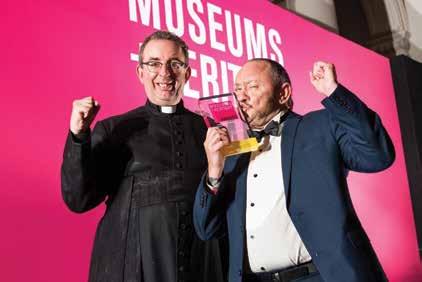
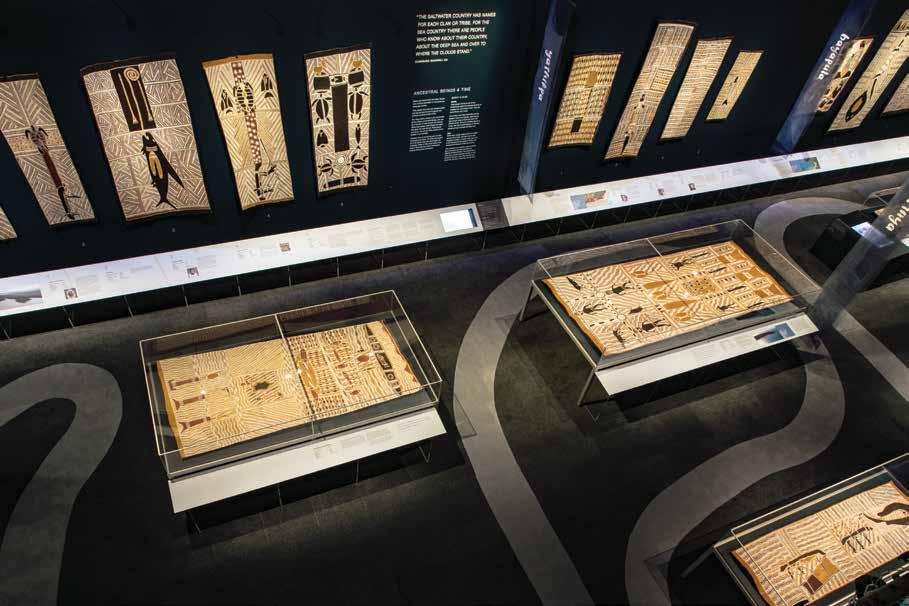

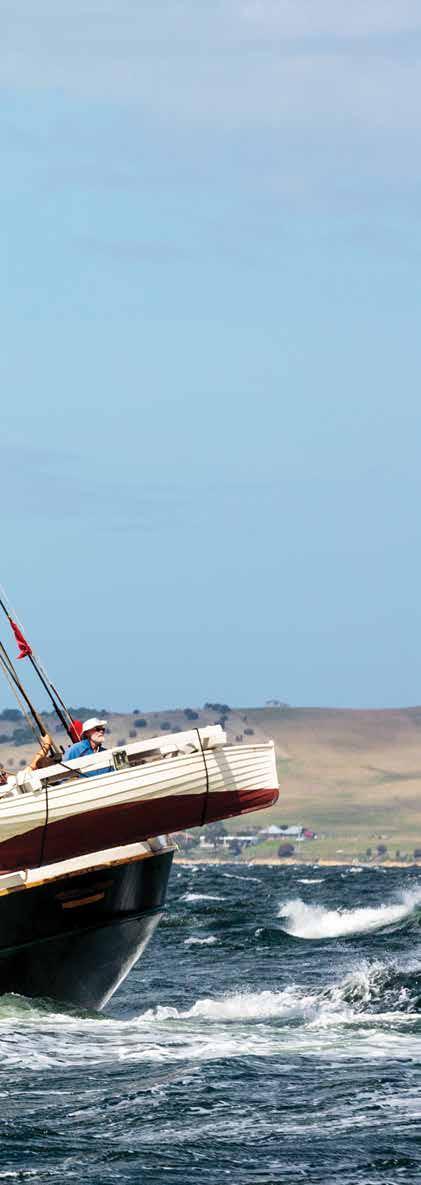
The MyState Bank Australian Wooden Boat Festival 2019
Large crowds thronged the vibrant Hobart waterfront for four days of wooden boat excitement in February. The Australian National Maritime Museum played a big part in the festivities, sponsoring the International Wooden Boat Symposium and sending the HM Bark Endeavour replica to be part of the event. The symposium presented a fantastic line-up of international and Australian presenters, including the museum’s director, Kevin Sumption, and staff members Emily Jateff, John Dikkenberg and David Payne. Our photo essay gives a flavour of this globally renowned event.
A new competition for wooden boat photography resulted in some beautiful images on display, including this prize-winning shot Ketch race (detail) by veteran AWBF photographer
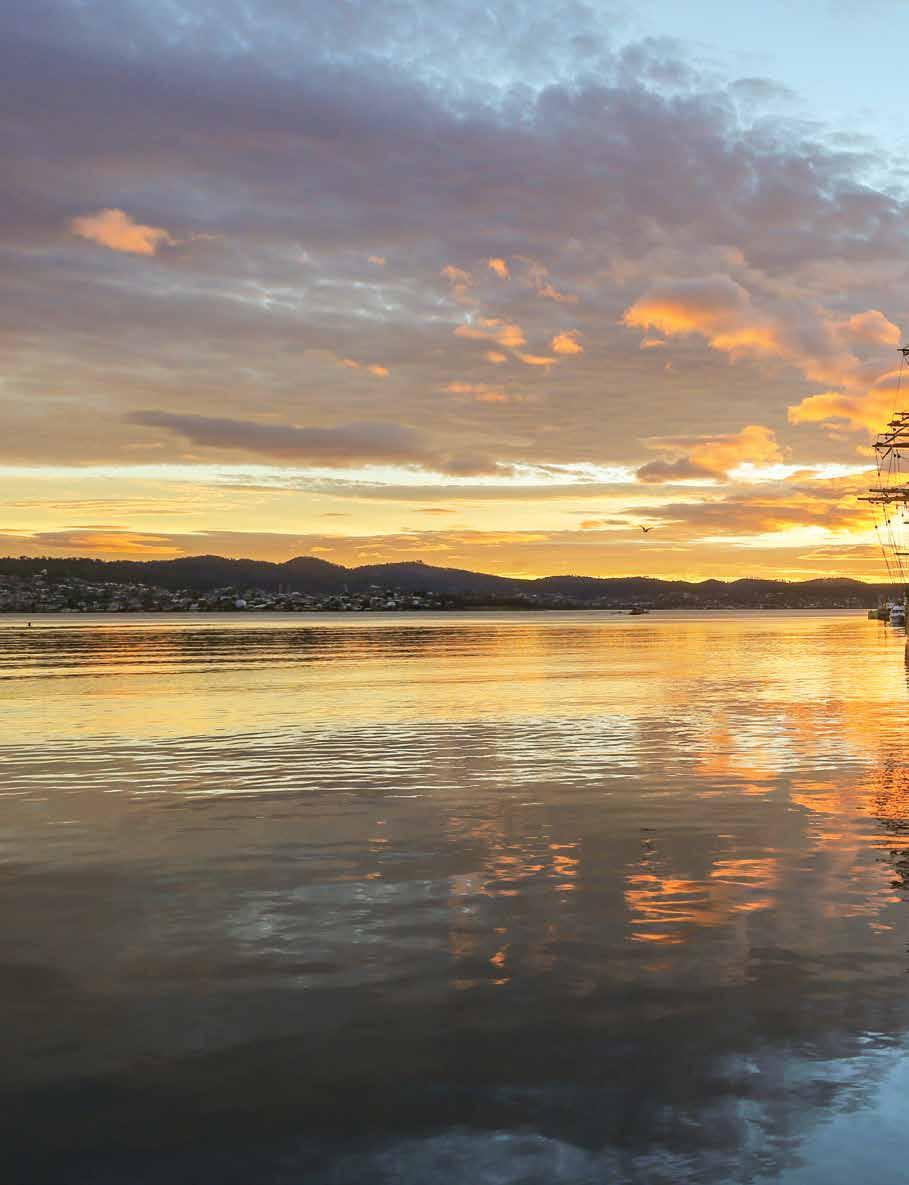
The MyState Bank
Australian Wooden Boat Festival is the largest wooden boat festival in the Southern Hemisphere, and is presented entirely free to the public

In the small boat-mad town of Franklin, almost-finished boats by the visiting American team were threatened by devastating bushfires, but a daring earlymorning rescue mission got them to safety
01
American craftsmanship was on show as the festival welcomed a team from the Northwest School of Wooden Boatbuilding in Washington State. Image © Graeme Hunt/AWBF
02
Preserving and passing on boatbuilding knowledge in the Shipwright’s Village: traditional skills are an important part of the festival’s theme. Image © Ashlie Hill/Ballantyne Photography
03
A new feature at the festival was a display of ships-in-bottles, setting a new Australian record, with 256 individual items. Image © Mary Lincoln/Ballantyne Photography
04
Junior boatbuilders can get a head start at the MyState Australian Wooden Boat Festival. Image © Syd Reinhardt/ Ballantyne Photography
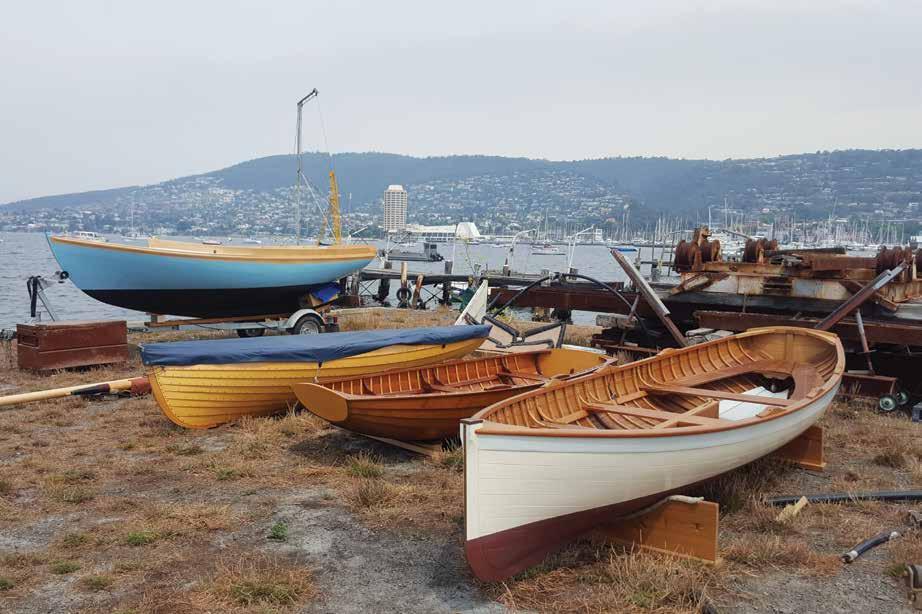

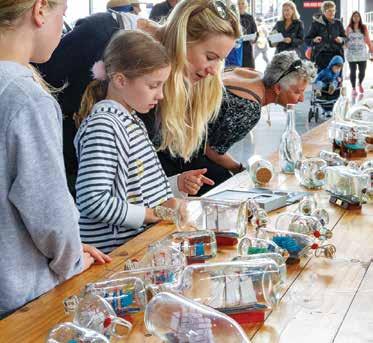

Hamaguchi wrote: ‘The skipper, who looked about 50 (the others all looked more like 25 or 26), was wearing a black fur hat with tightly woven wool fabric hanging down at the back … he was holding a small knife and a length of ropelike dark red tobacco …’. Of the dog, he noted, ‘It did not look like food. It looked like a pet.’
Unless otherwise credited, all images from An Illustrated Account of the Arrival of a Foreign Ship, by Hamaguchi Makita, 1830. Courtesy of Tokushima Prefectural Archive. ©Tokushima Prefectural Archive 2006. Photographs © Nicholas Russell 2019
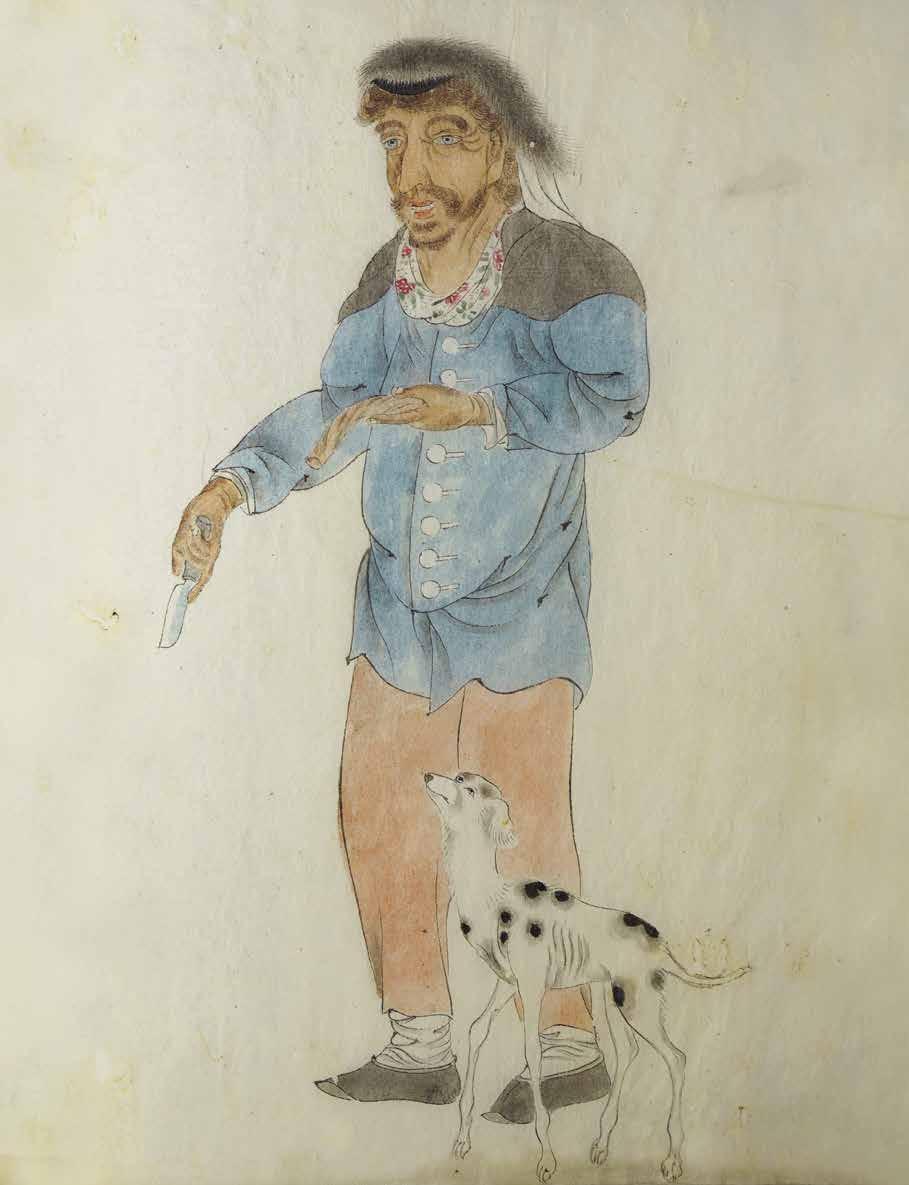
An unlikely encounter between colonial convict pirates and Japanese samurai has come to light in a series of manuscripts in a Japanese archive. Nick Russell traces the story of William Swallow and his fellow pirates through the eyewitness account of chronicler and artist Hamaguchi Makita.
When Swallow and his fellow convicts seized the Cyprus, it was bound for the worst prison in the British Empire: Macquarie Harbour Penal Station, on the inhospitable and isolated west coast of Van Diemen’s Land. Some of the convicts on board had been there before and were said to favour death over returning to that ‘place of tyranny’, as it was described in ‘The Ballad of the Cyprus Brig’. 3
ON 5 JANUARY 1830, THE CYPRUS and its crew of 10 convict pirates appeared off the coast of Tosa Province (now Kochi Prefecture), Edo Japan.1 After seizing the colonial brig in Recherche Bay, Van Diemen’s Land (now Tasmania) on 14 August 1829, they had entertained another ship’s company at Cloudy Bay, New Zealand; pillaged a sealer camp at the Chatham Islands; been driven away from Tahiti by contrary winds; and stayed for six weeks on Niuatoputapu, Tonga. They had also left men in their wake, figuratively and in one case literally: William Brown, a pressed2 convict shipwright, was reported as lost overboard in a storm between New Zealand and the Chatham Islands, and seven others decided to stay on Niuatoputapu, while the rest continued to Japan.
Their captain, William Swallow, also claimed to have been pressed, but this may well have been a contingency laid by this master escape artist, unlucky thief and loving family man. Of his five known escapes, four initially ended in freedom and reunion with his wife and children in England. All arrests but his last were theft related, and he dodged being labelled a re-offender by using aliases, of which Swallow was just one. Born in Sunderland, England, in 1792, he was apprenticed on a collier in the North Sea (as was James Cook), was pressed by the Royal Navy during the Napoleonic wars, worked as a master of a coastal trader as well as first mate in the Mediterranean, and even sailed to the Baltic. However, the need to support his family during the postwar depression appears to have led to stealing.
The Cyprus was from a shipyard in Swallow’s hometown of Sunderland, so would have been of a type immediately familiar to him. However, this escape from Recherche Bay was undoubtedly his most audacious. His crew included only two other men described as seamen or mariners, and possibly one other with experience, as opposed to the usual complement of 12. He knew he was sailing into the Tasman Sea in winter and would face at least one Roaring Forties storm on a downwind run to the unfamiliar lee shore of New Zealand. This baptism by fire for his new crew would have consolidated his command, as they relied utterly on his seamanship and experience.
While still disembarking the guards, crew, passengers and nonparticipating convicts at Recherche Bay, the Cyprus ’s new crew are reported to have drawn up ‘piratical articles’, the contents of which can only be guessed at. The hugely popular A General History of Pyrates (1724) cites examples that include clauses covering conflict resolution, punishments, democratic process (including selection of a captain), division of spoils, the treatment of women, and even days off for musicians. The drawing up of articles was very probably prompted by Swallow as a means of maintaining order.
But off the coast of Japan, the now hungry and thirsty Cyprus crew ran into trouble. While moored off Murotsu Village, eastern Tosa Domain, in January 1830, they made three attempts to land. Each time, the longboat’s crew was driven back by warning musketoon fire from the seafront. Finally, after one of the pirates broke down and cried out, begging for succour, a local merchant sent out a boat with more than 100 kilograms of rice and water. The merchant had intended to give them ten times this amount, equivalent in value to a small house. This level of largesse was atypical, but is confirmed in an earlier Tosa Domain source that reported Murotsu merchants sharing food during times of famine.
Disguised as fishermen, the samurai agents rowed out to the brig, under orders to make detailed pictures of anything that looked like a weapon.
‘We saw not a single weapon’, Hamaguchi wrote, but he recorded considerable detail of the ship and its rig and the interactions between the brig’s crew and the samurai.
‘The barbarian ship was now surrounded by our small boats, including both of our commanders. Our guns were at the ready to blow them to bits’
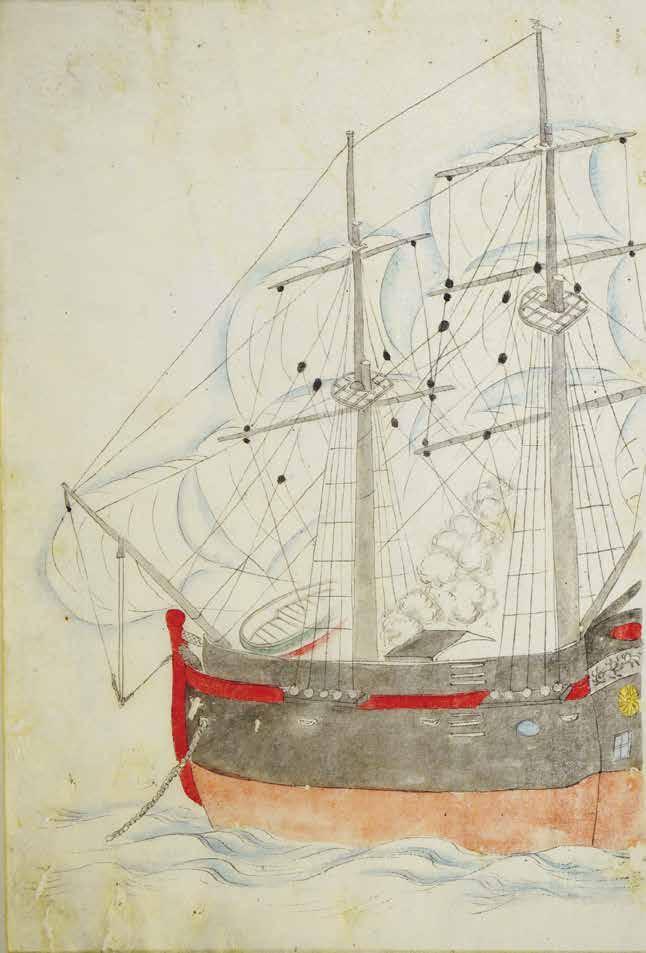
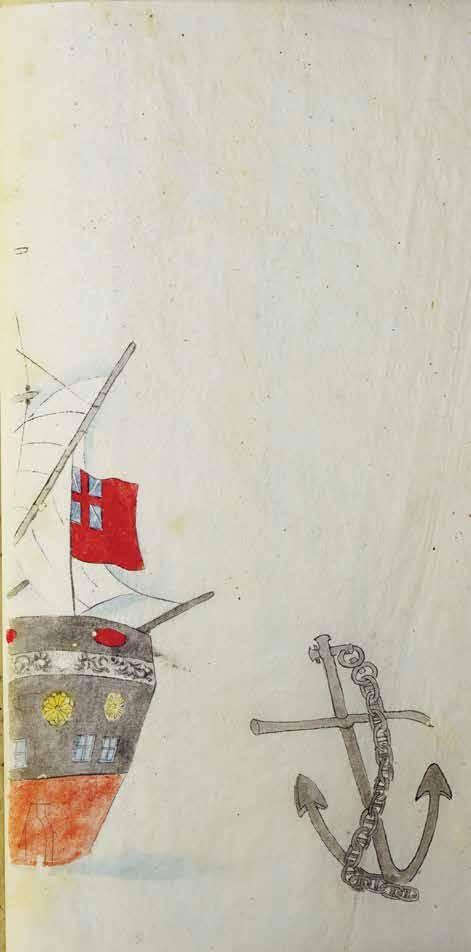
Early on the morning of 6 January, the Cyprus weighed anchor and sailed away as a storm blew up, pushing the brig further out to sea. Five days later, on 11 January, it reappeared off Hiwasa, Awa Domain (now Tokushima Prefecture), 100 kilometres to the north-east up the coast of Shikoku. After drifting back down the coast for 20 kilometres, it dropped anchor in 15 metres of water, about 600 metres from the north-eastern end of Teba Jima Island and three kilometres off Mugi Ura Cove.
The pirates’ behaviour and reception off Tosa Domain and Awa Domain were different: this time they did not try to land, but requested water, firewood and a week or so for repairs. Their longer presence gave the Awa Domain samurai time for an organised response in line with the Shogunate’s isolationist policy of maritime restrictions, which not only limited trading countries and the ports to which they were welcome, but also domestic maritime technological development and overseas visits. Because of its recent history of incursions, Britain had the status of least-welcome nation. Fortunately for the Cyprus, the samurai’s flag reference book listed the brig’s ensign as that of Angleterre (the French word for England), and the Japanese did not initially recognise it as a British vessel.
Due largely to these British incursions, the Shogunate’s strictest shoot-first edict had been in effect since 1825, mandating samurai to use warning shots to deter any ship that approached the coast and immediately kill or imprison any foreigner who set foot on Japanese soil. Historically, such edicts were not unique to Japan: the Ming Dynasty in China had had a similar policy in place at the beginning of the Edo period. The rationale was that if the nation were self-sufficient with internal peace, why allow in potentially disruptive or colonial foreign influences?
Each domain’s assessment of their response and repulse also differed: Tosa’s had not been resolute enough, and there is a Domain manuscript documenting their reassessment of their defences and preparedness. However, Awa Domain’s appears to have been textbook perfect, as samurai manuscripts list the honours bestowed on the participants. Led by the Shogunate’s feudal overseer to the Domain, Hayami Zenzaemon, the threat was assessed, an ultimatum made, the vessel engaged and the repulse successful, with no loss of life on either side. However, despite sporadic interest in academic circles, the incident was wiped from the folklore of the local fishing communities of Mugi Ura and Teba Jima. This social amnesia might have been because the holing and repulse of a vessel requesting respite for repairs did not sit well with the communities’ seafaring tradition, which dictated assistance in such situations.
Of the eight Cyprus-related manuscripts that have so far come to light, two accounts have been partially translated into English. The first is that of Hamaguchi Makita. A direct subordinate of the top samurai field commander Yamauchi – who was second only to the Shogunate’s feudal overseer, Hayami Zenzaemon –Hamaguchi was literate, artistic and trusted. Hamaguchi’s father was a samurai whose unwitting involvement in a scandal led to his suicide and the loss of the family’s hereditary title.

His primary role seems to have been similar to that of a secretary, but he was tasked with the important and potentially dangerous reconnaissance of the Cyprus, its crew, their capabilities and level of threat. Despite the essential role that he filled, however, he is not mentioned by name in other samurai sources due to his lowly rank. His perspective and detail are unique, providing a fly-on-the-wall account of the feudal overseer’s and two field commanders’ intelligence reports, discussions, decisions and orders, as well as his illustrated description and threat assessment.
The second translated manuscript is by Hirota Kanzaemon, a lower-ranked local samurai from Mugi Ura, who details initial interaction between the pirates and other curious local samurai and fisherfolk who row out to get a closer look.
When the first reports arrived of a ship being sighted off the neighbouring domain of Tosa, the Awa Domain samurai dispatched an agent to gather information about the brig from the locals there. This appears to have been normal procedure: if the vessel then arrived off Awa, a repulse might be required; if it was disabled, it might have to be towed along the coast of Awa en route to Nagasaki, the nearest port open to foreign vessels.
As soon as the brig was sighted off Hiwasa, Awa Domain, on 11 January, word was sent to Tokushima Castle, 50 kilometres to the north. After late-night discussions, a force was mustered, and its vanguard – including Field Commander Yamauchi and his secretary-cum-spy Hamaguchi – departed early the next morning. They rode as far as Yuki, a village six kilometres north of Hiwasa, and proceeded by boat to Mugi Ura, passing within one kilometre of the brig in the murky light of the half moon. From there, Hamaguchi was dispatched to Teba Jima Island with a gunnery team, musketoons and a twopound cannon, the largest of those deployed by the samurai.
01
Hirota Kanzaemon’s manuscript contains a small pictogram of an object that he notes was offered to the headman of a neighbouring village who had rowed out. It looks very much like a returning boomerang. Whether this was a mainland Aboriginal artefact, and whether, as G A Robinson reported,4 a Tasmanian Aboriginal woman was on board the Cyprus , still remain unanswered questions.
From A Foreign Ship Drifts in Off Mugi Cove, by Hirota Kanzaemon, 1830. Courtesy of Hirota Family Archive. ©Hirota Family 2018. Photograph © Nicholas Russell 2018
02
Japan, with the island of Shikoku highlighted; right: schematic map of the passage of the Cyprus along the coast of Kochi and Tokushima Prefectures, Shikoku, and that of the samurai who intercepted them. Images Jo Kaupe from data supplied by the author
This was a relative pea-shooter compared to the 12-, 24-, 32- and 42-pounders of Royal Navy ships of the line at Trafalgar. However, it was easy to move and quick to set up.
After delivering the cannon in the early hours of 16 January, Hamaguchi was sent out to reconnoitre the Cyprus. He does not report boarding the brig, but the perspectives and detail in the drawings by him and another artist who was present seem inconsistent with their standing in a fishing skiff and peering through the brig’s scuppers. At this time, Hamaguchi was busy with his written description as well as his sketches, some of which appear to have been finished from memory back on shore. He was there later when the pirates were fired on and were waiting for an offshore wind to flee the samurai, and details in a reworking of the manuscript by him that has recently come to light are closer to what we would expect. For example, in the original the cuffs of what is thought to be the lieutenant’s jacket seem excessively ornate for his rank, while in the reworking the simpler leaf design is closer to known examples in collections. On his first visit, Hamaguchi records Swallow’s first words of greeting as sounding like ‘Pace! Pace!’ – presumably ‘Peace! Peace!’. Ironically, for the Japanese this was the most diplomatic of encounters with Australian colonial or British captains, who were usually imperious and bellicose.
Swallow and his crew failed to recognise their artistic visitors’ humble fisherfolk disguise; instead, they offered them a shared circling glass of rum and tapped their heads, which was possibly an early form of Napoleonic salute. The ‘fishermen’ declined the rum and took the salute to be a gesture indicating its intoxicating effect.
Hamaguchi gave his report back in Mugi Ura and the samurai discussed what should be done. Mima, the other field commander, was more openly hostile than Hamaguchi’s superior Yamauchi, and characterised the beguiling effect of Swallow and his crew on visitors as ‘Christian sorcery’. Intriguingly, this quote is crossed out in Hamaguchi’s first manuscript but not his later reworking – almost as if Mima had leaned over his shoulder and told him to delete it. Mima thought they were pirates and should be crushed. Two local sword-carrying landowners were then sent with a ‘large cannonball’ and by ‘motions and signs’ informed Swallow that he and his crew should leave immediately. If they complied, they would be provided with water and firewood; if not, they would be fired upon.
Shuttle-boat diplomacy commenced. Swallow asked for five days’ grace to carry out repairs to the brig. This was refused, so he asked for three. That also was refused, and when one of his crew started to get angry and shout, Swallow defused the situation by encouraging the envoys to leave quickly, but not before he handed them a sealed envelope. Yamauchi was furious with his messengers for accepting the letter, as any formal communication would be in breach of the Shogunate’s edict. They rowed out one last time to toss the unopened letter back over the brig’s gunwale, then pulled hurriedly away.
A signal fire was lit on the mainland, and the first report rang out from the two-pounder on Teba Jima. The cannonball was pitted to make it scream as it flew between the brig’s masts. The crew’s response was to leisurely spread a sail, which further infuriated the samurai commanders. From their attempted landings in Tosa, the pirates by now probably thought that they understood the samurai’s rules of engagement.
Four Japanese patrol boats with gunnery teams were despatched and again fired around the brig. The finer details of European maritime technology, however, had been lost in transmission. The samurai knew that European ships possessed the technology to sail upwind, but the samurai commanders overestimated the brig’s ability. Consequently, when the brig failed to sail away upwind and instead sailed downwind towards the samurai fire, the samurai’s reaction became more vigorous. Hamaguchi wrote, ‘At about this time the feudal overseer realised it was a British ship and became extremely angry’. A previous incursion had led to the suicide of the Shogunate’s representative at Nagasaki Port. ‘They ordered fire to be directed at the waterline in the red copper-sheathed area. Two cannonballs hit and shook the ship badly. The barbarians were standing and yelling.’ Hamaguchui continues:
Commander Yamauchi from his boat orders his patrol boat gunners to concentrate their fire on the rudder area at the stern on the starboard side of the ship. One of Nishizawa’s three-quarter-pound cannonballs reduced a two-foot square area of the sturdy hull to splinters and ricocheted off to port. One or two of brig’s crew appeared to have been killed or injured as they were lying on the deck. The others turned towards Commander Yamauchi’s boat, all removed their hats and appeared to be praying. Out on the water the samurai heard random cries of ‘Roubin! Roubin! Rou!’ [Pronounced like ‘rue’ and ‘bin’; possibly they heard ‘Row men! Row men! Row!’]. The barbarians all showed themselves blowing into cupped hands. They were gesturing that the wind was no good. Commander Yamauchi asked when the wind might change. His boatmen responded that after sundown a wind would blow up from Asakawa but it would not reach them there. Later, however, just off Mugi Cove there would be an offshore breeze.
01
‘All of the men were wearing hats: most of leather, but one of wound red cotton cloth and another like a thatched farmer’s hat’, Hamaguchi reported.
02
What is thought to be Lieutenant Carew’s dress uniform, of which Hamaguchi wrote: ‘Next the skipper brought out a tightly-woven scarlet woollen coat to show us … This was a thing of great beauty but excessively fancy ... The cuffs were stitched with gold thread and the buttons were silver plated’.
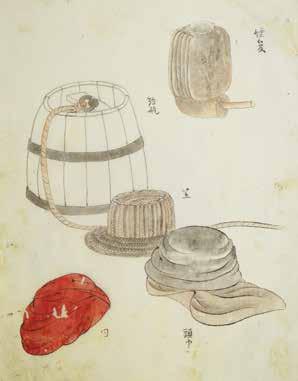
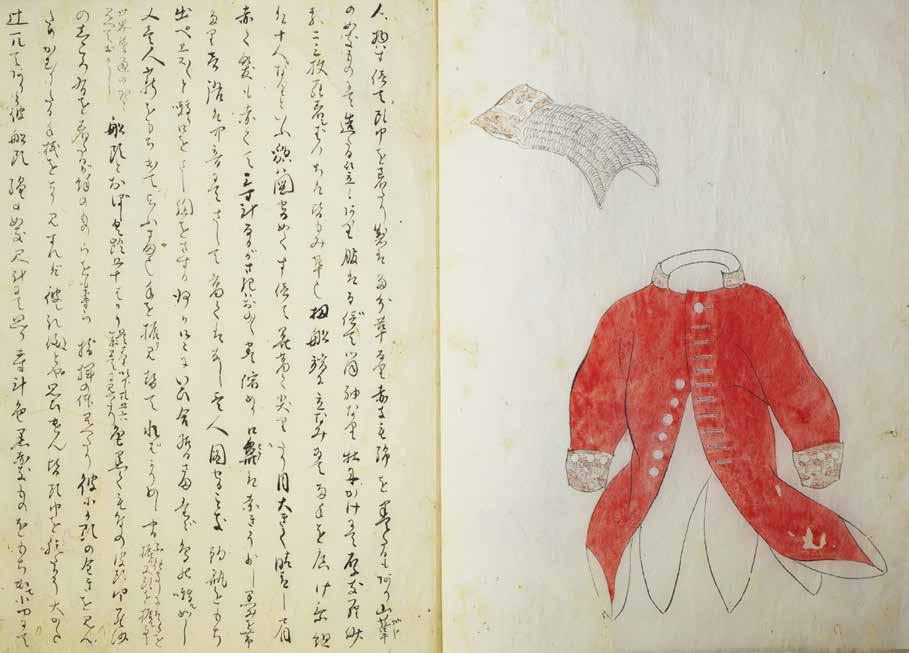
Commander Yamauchi was good enough to share this knowledge with the barbarians through gestures and they swiftly turned the brig across the wind. Unlike our large ships, the barbarian ship turned tightly but it could not, in fact, sail directly into the wind as we had thought; it could only sail across the wind. The barbarian ship was now surrounded by our small boats, including both of our commanders. Our guns were at the ready to blow them to bits. If they grabbed the ropes to go over the side or put up a fight, we were ready to shoot. A foul stench was coming from the ship. The musketeer, Nishizawa, threatened them by shouldering his big gun. The barbarians looked worried, cried out and trembled with fear. Some of them even pointed to their sides and fell down praying. We took this to mean that one of Nishizawa’s musketoon balls had reached its mark and taken a life.
It was later reported in The Times that one shot had knocked Swallow’s spy-glass from his hand, but none of the pirates reported any fatalities or even injuries from this encounter. Hamaguchi wrote that ‘as dusk fell a strange beguiling pipe and singing could be heard. The sound was like that of a child’s pennywhistle; nothing like a real flute. It was eerie.’ A single defiant musket report was heard from the brig as it sailed out of sight, to which the samurai replied with a single cannon shot into the darkness from Teba Jima. The repulse had been successful: no barbarian foot had touched Japanese soil and the foreign ship had been driven away, in line with the Shogunate’s 1825 edict.
Early in 1830, at the far west end of the Tosa Domain, local people reported seeing a ship and hearing a musket shot off Kashiwa Jima. It may have been the Cyprus.
About a month after leaving Japan the brig arrived off the Pearl River Estuary in China. There were disagreements between the crew, and ‘to avoid apprehension as pirates’ four of them hacked a hole one metre below the waterline and sank the brig. Having left the ship in three groups, all 10 eventually ended up in Canton, where the East India Company’s Supercargo took statements, and detained some of them when they gave different names for their captain. From there, three escaped to Mexico and the rest ended up in the dock back in London. Two of them became the last men hanged for piracy in England. Swallow talked his way out of two death sentences and was sent back to Van Diemen’s Land, where he died of consumption a few years later. The brig Cyprus probably still lies on the seabed, somewhere off the Pearl River Estuary, a wrecked testimony to the first cross-cultural engagement between Australia and Japan. The irony that the pirates and the Japanese came into conflict when they were both avoiding British imperialism might have disappeared along with the Cyprus, but for the discovery of the Japanese manuscripts detailing the encounter.
Of the eight Cyprus-related manuscripts that have so far come to light, two accounts have been partially translated into English
1 The Edo Period (1603–1868) was a time of peace and isolationism achieved by the feudal military government of the Tokugawa Shogunate through strict control of the feudal lords and populace. It came after the anarchy of the Warring States Period and before the coup d’état of the Meiji Restoration. It saw growths in economy, education, logistics, production, popular culture and mass media.
2 Impressment (‘pressing’) – the forcible enlistment of ships’ crew – was used by the Royal Navy in times of war. On pirate ships it was often feigned in front of witnesses in the case of specialist crew members, such as carpenters and doctors, to give them the excuse of duress if they were ever captured by the authorities. Swallow, on the seizure of the Cyprus , convinced the doctor on board that he was a pressed man. Later this worked to his advantage when the doctor gave evidence in his defence.
3 ‘The Ballad of the Cyprus Brig’ is attributed to ‘Frank the Poet’ in an 1891 transcription by Thomas Whitley held at the State Library of NSW. It contains the lines: ‘For navigating smartly Bill Swallow was the man, / Who laid a course out neatly to take us to Japan’.
4 A Mr G A Robinson on Bruny Island, Van Diemens Land (Tasmania), reported a local Aboriginal man, Mangana, as saying that his wife had been taken on board by soldiers and then gone to England. Robinson later reports someone saying she was found dead in the water. He and his young secretary, Charles Sterling, are the only known sources on the Australian side of this story.
Sources and further reading
Durham County Advertiser, 14 April 1821.
Van Diemen’s Land newspapers, 1829.
Carew’s court martial transcript: The Tasmanian, 30 October 1829. The Times , 1830.
Hue and Cry, The Police Gazette, March 1830.
Swallow’s Petition to Peel, December 1830.
Deveron: The History of Tasmania, John West, Vol 2, 1852.
Chatham Islands: Whaling and Sealing at the Chatham Islands , Rhys Richards, 1982.
The Man Who Stole The Cyprus , Warwick Hirst, 2008.
Contrary Winds , John Williams, 2012.
Tosa Domain samurai account of Murotsu merchants, in presentation by Dr Luke Roberts, Kochi Castle Museum, 3 April 2018.
Nick Russell is a resident of Japan who came across illustrations of the brig online while investigating the local history of Teba Jima, where he had just bought a holiday cottage. As a Brit he felt destiny bound to solve the mystery of what a ship bearing the red ensign was doing moored just 600 metres off his new back garden in 1830. Two years later, on the verge of giving up, he Googled ‘mutiny 1829’ and when the Cyprus story appeared, he immediately made the connection. Nick and some of his students translated the manuscript into English and then back into modern Japanese. After the initial media attention, a samurai descendant showed Nick a 35-year-old private letter in which a Japanese amateur historian suggested, but never published, a Tasmanian convict link.

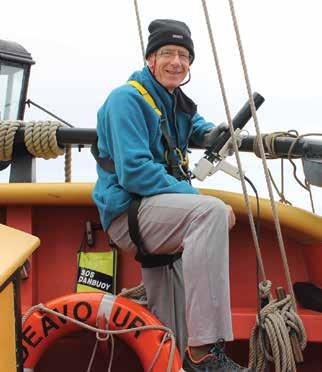
Science was a large part of life on HMB Endeavour in the 18th century. From tracking the transit of Venus in Tahiti to collecting and classifying thousands of plant specimens, the Endeavour voyages contributed a vast swathe of knowledge to European science. In February 2019, a new pilot project called Observations at Sea sought to bring science back aboard the Endeavour replica and, in the process, inspire the next generation of scientists, engineers and thinkers. By Graeme Buckie, Bill Flynn and Elle Shepherd from CSIRO.
An 18th-century tall ship presents a number of very different, and sometimes unexpected, challenges while undertaking seemingly simple tasks
OBSERVATIONS AT SEA is a partnership between CSIRO Education and Outreach and the Australian National Maritime Museum. Conceived after conversations between the two institutions about opportunities to highlight the scientific history attached to voyages of exploration, it was designed to test the viability of conducting a science education program aboard Endeavour
The pilot is based on CSIRO’s existing Educator on Board program, where teachers spend time at sea aboard research vessel RV Investigator, supporting scientists with their research. After the voyage, the teachers develop classroom resources to share with other teachers across the country; promote real-world applications of science, technology, engineering and mathematics (STEM); and showcase the research being undertaken in the marine sciences.
To test the new idea with museum vessels, four CSIRO staff members joined separate legs of HMB Endeavour ’s journey to and from Hobart in February this year. Collectively sailing more than 1,400 nautical miles (2,600 kilometres) along the picturesque Australian east coast, CSIRO staff served as voyage crew, balancing their sailing responsibilities with undertaking trials of five different scientific activities. These were carefully selected to reflect the work of CSIRO researchers and to provide important classroom links to the Australian National Curriculum, while still being suitable for a replica 18th-century vessel with limited space and equipment.
After learning the ship’s ropes and settling into its disciplined watch routine, the CSIRO staffers were able to regularly deploy expendable bathythermographs (XBTs) – probes used to provide real-time measurements of ocean temperature down to a depth of 800 metres. With support from the ship’s engineer, who rigged a conveniently placed earth line to allow the probes to transmit back to the ship, the XBTs were launched successfully from Endeavour ’s stern. They brought instant data back to the deck, displaying a graph comparing the expected temperatures based on existing temperature models and the temperatures measured by the probe. The temperature profiles collected on Endeavour will be used to develop and update these scientific models, giving researchers greater insight into major ocean currents and temperatures.
While on board, the CSIRO team tested the use of a portable net used to undertake surface trawls and collect data for the CSIRO Global Plastic Pollution Project. These nets have been successfully deployed from different ships around the world to collect plastic and microplastic floating on the sea’s surface. The plastics gathered by these nets are then separated and catalogued by size and type. Details of how much plastic was found, and where, are recorded along with the ship’s heading, location and weather conditions. These readings are then added to a global dataset that is used to help researchers better understand the sources and distribution of marine debris.
When attempting to deploy this net, one thing became clear very quickly – Endeavour is a very different vessel to those regularly used by CSIRO researchers, and an 18th-century tall ship presents a number of very different, and sometimes unexpected, challenges while undertaking seemingly simple tasks. The CSIRO crew worked with the ship’s boatswain to enable these to be overcome so the net could be deployed.
Finally, the CSIRO crew members focused on making oceanic observations at sea. These included the use of citizen science apps to collect data on water quality, recording the estimated turbidity and levels of light reflected from the water at a number of points along both legs of the voyage. They also undertook designated observations for Trichodesmium – little-understood rafts of algae known to the crew and scientists aboard the original Endeavour as ‘sea sawdust’ –and bioluminescence. No Trichodesmium was seen on these voyages, but bioluminesence was regularly spotted glowing in the ship’s wake.
With the pilot activities now complete and the crew back on land, CSIRO Education and Outreach and the Australian National Maritime Museum are reviewing the pilot to analyse what was learned from the trial voyage activities, contemplate the feasibility of developing this trial into an extended program and examine the potential for future activities. It is hoped that observations and data from the Maritime Museum’s vessels can be given to teachers and students around Australia to promote real-world applications of STEM and highlight the importance and history of the marine sciences aboard Endeavour.
01 Elle Shepherd retrieves a trawl from the marine plastics net. 02 Bill Flynn prepares to launch an XBT (expendable bathythermograph) from Endeavour ’s stern. Images courtesy Mary Alice Campbell‘we got our muskets and arms ready –this coast is much infested by pirates’
Recent changes to the Copyright Act have made it easier for cultural institutions to publish more of their collections. ‘Orphan works’ – those whose creator is unknown – and manuscript works can now be publicly shared, meaning that many fascinating and significant journals and other documents can finally emerge from their vaults. By Library Coordinator Karen Pymble .
AMONG THE MUSEUM’S HOLDINGS is a rare original account of life on board a convict transport ship. It is particularly unusual in having been written by a female passenger, Mrs Pexton, who accompanied her husband, Captain William Pexton, on the ship Pilot from London to the penal colony of Port Jackson (Sydney) in New South Wales.¹
Departing on 18 December 1816, they first sailed to Cork, Ireland, where they embarked 120 male convicts and a military guard of a sergeant and 30 privates. About half of the journal describes the seven-month voyage out – including a stopover in Rio de Janeiro and an attempted mutiny by the convicts – and her time in New South Wales and Van Diemen’s Land (Tasmania). Arriving in Sydney in July 1817, Mrs Pexton writes interestingly of the town and vicinity, the social life and the convicts, along with descriptions of the inhabitants, Aboriginal people and wildlife (including a tame kangaroo).
Mrs Pexton then accompanied the Pilot as it transported 280 convicts – ‘The very worst which they can make nothing of at Sydney’ – to Van Diemen’s Land. She describes the Hobart area, where she stayed: ‘there are very few settlers but the land cultivated is in very good order. I believe it will grow anything, fruit of every kind will grow particularly English’.
On her return to Sydney, Mrs Pexton talks about the natives, and their being naked and liking spirits. She says she is tired of Sydney, and Australia will spoil anyone who stays.
The transport ship then took on a cargo of horses, and departed for Batavia (now Jakarta), Indonesia. Storms, illness and a leaking ship forced the Pextons to take up residence there for several months, before leaving on 7 May 1818.
The ship returned to England via Isle de France (Mauritius), India (‘we got our muskets and arms ready – this coast is much infested by pirates’) and St Helena. They sighted England on 26 November 1818: ‘I have only been [away] two years and I am not able to express half the pleasure I feel at the sight of it’.
These very personal reflections, like many other fascinating historical records, are among the diverse collection of material housed at the Vaughan Evans Library, the research hub of the Australian National Maritime Museum. This story, like many others, has not always been accessible online – but recent changes to the Australian Copyright Act will open up access to a wealth of historical maritime stories.
Specifically, in 2017, the Australian Government introduced major changes to the copyright term provisions of the Australian Copyright Act. This was done as part of the Copyright Amendment (Disability Access and Other Measures) Act 2017 (CADM). These changes replace Australia’s existing copyright term provisions and came into effect on 1 January 2019.
The change to the legislation came about due to the Marrakesh Treaty, which is the first international copyright treaty to facilitate access to published works for persons who are blind, visually impaired or otherwise print disabled.
The title page of Mrs Pexton’s lively account of her voyage from London to Australia and back, on a convict transport ship captained by her husband. ANMM Collection 00045200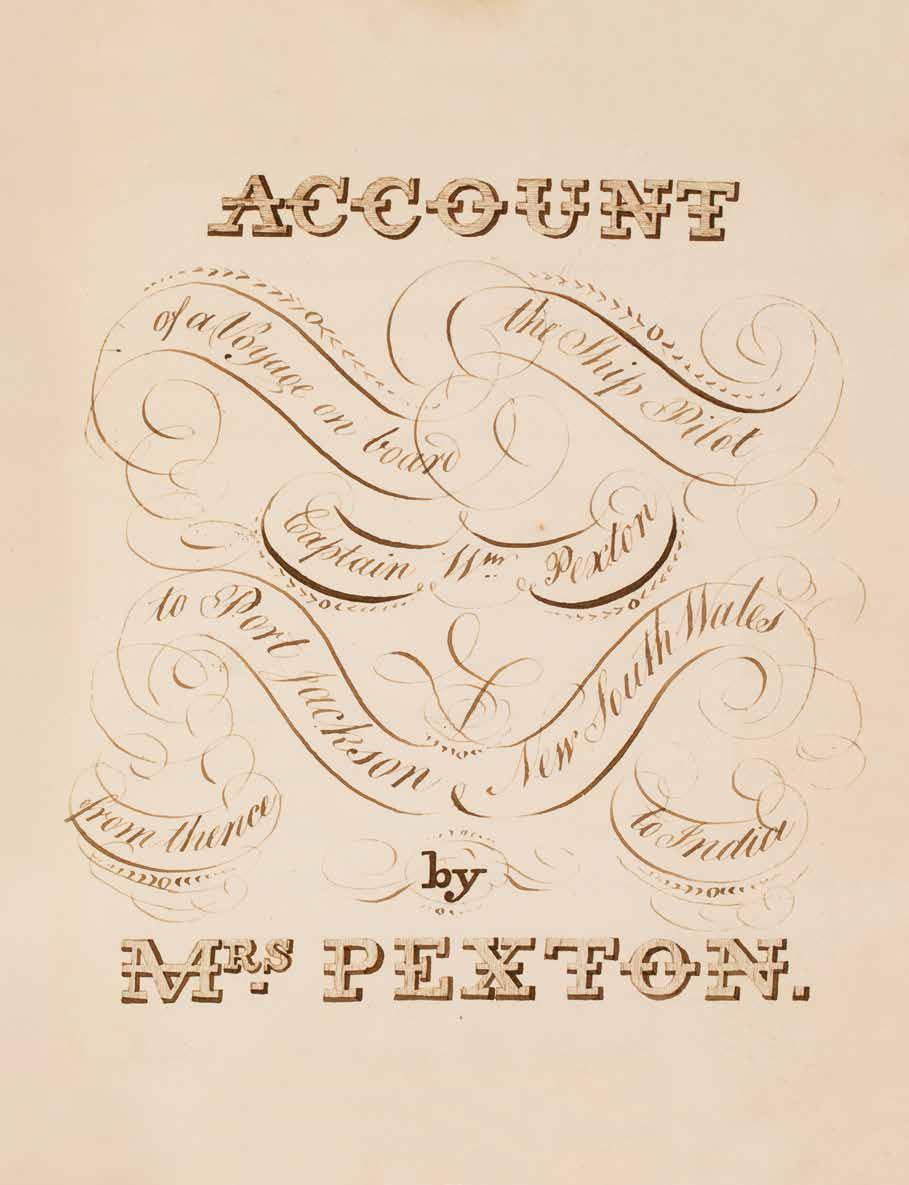
As of 1 January 2019, the museum’s collection of diaries, letters and other unpublished works is now in the public domain, for anyone to access and use
Robert Rose’s World War II journal, kept when he was a prisoner of war, includes photos sent to him by his wife, as well as descriptions of everyday life, details of sporting competitions and addresses of comrades. ANMM Collection 00044998 Reproduced courtesy Robert Leslie Rose
02
One of the finest shipmaster logs in the museum’s collection was written and illustrated by Captain William Henry Downes during a whaling venture aboard the barque Terror in 1846–47. ANMM Collection 00038301
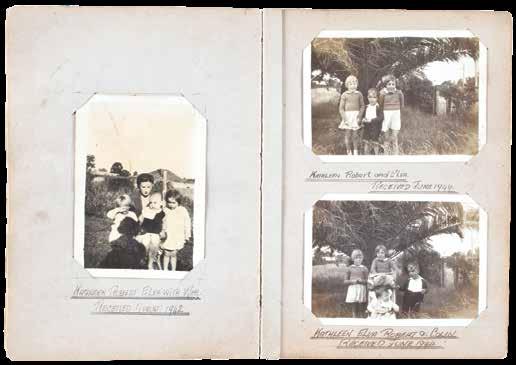

The four main changes are:
1. Disability These new amendments replace two current provisions (statutory licence and s200AB) with two new provisions:
• Exception for institutions providing access to those with a disability
• Fair dealing for providing access for those with a disability.
2. Preservation Libraries and archives are no longer required to wait until material has been damaged or suffered deterioration before making preservation copies. They are permitted to make multiple preservation copies, and to make available electronic preservation copies to the public, without infringing copyright.
3. Education This simplifies the statutory licence.
4. Copyright term Previously, there were different rules for published and unpublished material, and unpublished materials could remain in copyright in perpetuity. CADM ends perpetual copyright and replaces with life of the author + 70 years, or 70 years from the creation of an orphan work, regardless of whether it is a published or unpublished work. Where the creator of the material cannot be identified, the term of protection is 70 years after the date of making. The standard term will be effective for works created before 1 January 2019 that are unpublished by that date.
Matthew Rimmer, QUT Professor of Intellectual Property and Innovation Law, explains why this was long overdue:2
Australia’s laws were an anomaly. Unpublished copyright works received perpetual protection – as long as they were not published. This led librarians to protest with the Cooking for Copyright day of action when they baked goods from unpublished recipes to illustrate the problem of this default copyright position. Setting finite terms for copyright in unpublished works is a sensible move by the Australian Government and keeps Australia in line with other comparable jurisdictions like Canada, the United States, and England. Libraries, galleries, museums, and archives have certainly welcomed the proposed law reform.
The amendment to the copyright term will have the greatest impact for us at the museum. Changing the term to 70 years from the creation of an orphan work is simple and fairer and makes it much easier to access a large number of old materials. These new terms were introduced to help get around the concept of perpetual copyright for unpublished works. This rule of legacy meant that all national institutions holding letters and diaries could never introduce them to the public domain; even material that was hundreds of years old was still protected by copyright in Australia. As of 1 January 2019, however, the museum’s collection of diaries, letters and other unpublished works is now in the public domain, for anyone to access and use.
New copyright protection terms from 1 January 2019
• Works (literary, dramatic or musical) – 70 years after author’s death
• Works with unknown author –70 years after making or 70 years after first made public (if within 50 years of making)
• Sound and film recording –70 years after making or 70 years after first made public (if within 50 years of making)
• Crown (Commonwealth, State or Territory) – 50 years after making
The museum’s Registration department has been working hard on digitising the original diaries and logs. These items include whaling logs and personal diaries written by travellers, immigrants, crew members, sea captains, ship’s surgeons and matrons. Digitised items can be publicly accessed via ‘Collections’ on our website.
The Vaughan Evans Library holds many diaries and letters. All of the library’s manuscript diaries are unpublished copies or transcripts. These manuscripts are often requested by the public in the course of their research. Diaries are one of the richest primary resources for information of the time, giving us insight into what it was like to be a passenger or crew member. Many of the diaries and letters were written to help pass the time; others are brief and factual, mainly noting the weather and the latitude and longitude.
This welcome amendment to the Australian Copyright Act will vastly expand the range and variety of Australian maritime stories that anyone across the globe can access. Digitising this part of the collection will take time, but this valuable resource will serve many generations to come.
Footnotes
1 Diary of Mrs Pexton aboard the Pilot . ANMM Collection 00045200 2 qut.edu.au/law/about/news-events/news?news-id=116058, 4 April 2017, accessed 16 May 2019.
Information in this article has been adapted from Australian Libraries Copyright Committee libcopyright.org.au
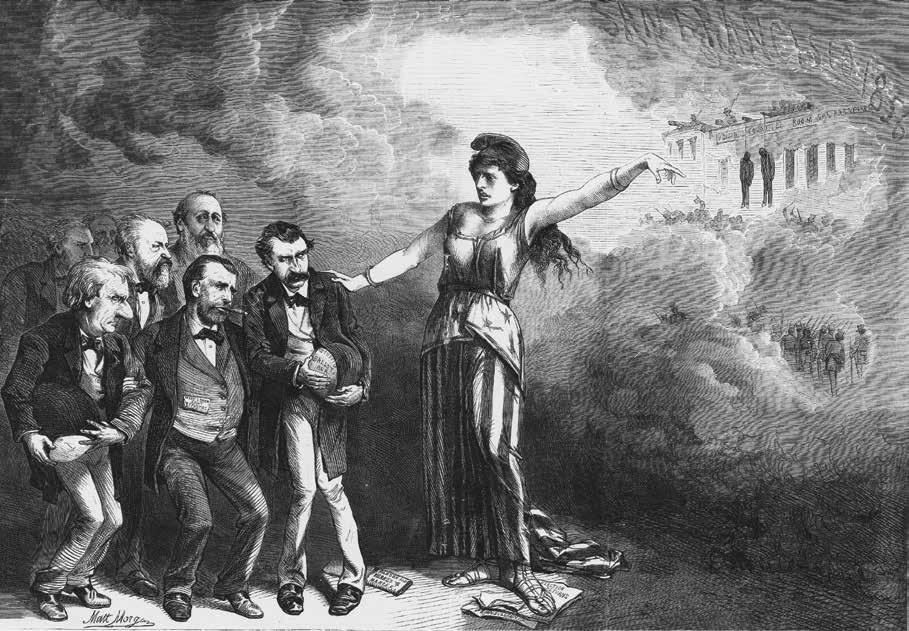
As museum staff digitise our collection, they often come across intriguing objects. In a box containing 263 engravings on various topics, Nicole Dahlberg found one from 1872 whose subject immediately grabbed her attention: a public lynching. She traces the story back to San Francisco during the lawless days of the Californian gold rush.
01 Beware! Engraving by Matt Morgan, 1872, published in Frank Leslie’s Illustrated Newspaper. ANMM Collection 00019630
02 A lynching in San Francisco, published in the Illustrated London News on 15 November 1851. ‘Sydney Ducks’ Samuel Whittaker and Robert McKenzie were killed before a crowd of 15,000 on 24 August 1851. ANMM Collection 00005965
The engraving by Matt Morgan demonstrates how one humble object can carry many layers of history and meaning

IN 1848, GOLD WAS DISCOVERED in Sutter Creek, near Coloma in California. When the news spread abroad, the resulting frenzy bought a dramatic influx of migrants from all corners of the globe, including Latin America, Hawaii, China and Australia. More than half arrived by sea. While this movement of people started late in 1848, the main impact was felt in 1849, and these migrants became known as the ‘San Francisco 49ers’.
Before 1849, California’s population was estimated at about 15,000. By 1851, it had reached 250,000. San Francisco, with a population of just 1,000, had neither the government nor the infrastructure to accommodate the 36,000 migrants whose unexpected arrival had drastically swollen its population by 1852. As the settlement grew, smaller scattered towns began to be established. As they often comprised distinct cultural groups, few knew the law of the land, and the legal systems that had been in place before the gold rush now failed to meet the needs of a rapidly growing society.
The Californian census of 1852 quite often listed the last place of residence, which was not the usual practice across America. Between April 1849 and May 1850, some 11,000 Australians arrived in California, an estimated 7,500 of them from Sydney. A balance of men and women, the former Sydneysiders found the three-to-four month voyage from Sydney neither too tedious nor too expensive for their chance at the goldfields.
Some Australians prospered in the California goldfields, sending for their wives and children; others did not, and elected to return to Australia for a chance at the new goldfields of Victoria. Records confirm that this pattern continued for some time, with people travelling back and forth. More than 200 vessels sailed from Australia to California between 1849 and 1851, carrying not only passengers, but also prospecting and food supplies. The transport of these goods and the prolific movement of people facilitated high levels of trade during the gold rush years. These waves of migration would not have been possible without various shipping companies, such as Pacific Mail Steamship Company, the Black Ball Line and the Empire City Line of San Francisco.
The Australian migrants were often documented as thugs, scoundrels, thieves, aggressors, queue jumpers, and ‘the most abandoned men and women.’ They dominated an area of San Francisco located near the base of Telegraph Hill, near the harbour in the area of Pacific and Broadway streets, which became known as ‘Sydney Town’. Its residents, known as the ‘Sydney Ducks’, are alleged to have set up shady hotels and other establishments by the dozen, which drew in wealthy patrons who were then robbed.
The Australian migrants were often documented as thugs, scoundrels, thieves, aggressors, queue jumpers, and ‘the most abandoned men and women’
San Francisco, 1851. Lithograph by M & N Hanhart after a watercolour by S F Marryat. Chromolithograph portraying a view looking east towards the bay and depicting people of various nationalities, including Spanish and Chinese in the foreground. ANMM Collection 00015148
The association between the Australians in California and the name ‘Ducks’ remains unclear, but it is used consistently, along with ‘Sydney Coves’. ‘Ducks’ and ‘Coves’ may have been used to indicate a specific closed community whose residents had migratory patterns. According to the authors of The Annals of San Francisco, published in 1855, Sydney Town reflected the worst traits of society: drinking, gambling, constant lewdness, lawlessness, assault and strife. The Ducks’ actions were deemed brazen, however, due to the general lax understanding of the law, along with corruption and bribery. Courts and juries had very low conviction rates and were often seen to aid and abet the crime. The Ducks were therefore relatively safe and often went unpunished for their blatant crimes.
Criminal activity was not confined to the Sydney Ducks. In the late 1840s a group known as the ‘Hounds’ or ‘San Francisco Society of Regulators’ ran riot through prospecting communities. They were American veterans of the Mexican–American War, who in early 1848 drove mainly Mexican, Chinese and Spanish immigrants from the goldfields using physical assault and property damage. Only by the action of some 230 community members were some of the Hounds captured, including their leader, Sam Roberts. Although captured by the community, the Hounds were tried and sentenced under the impartiality of a court of law.
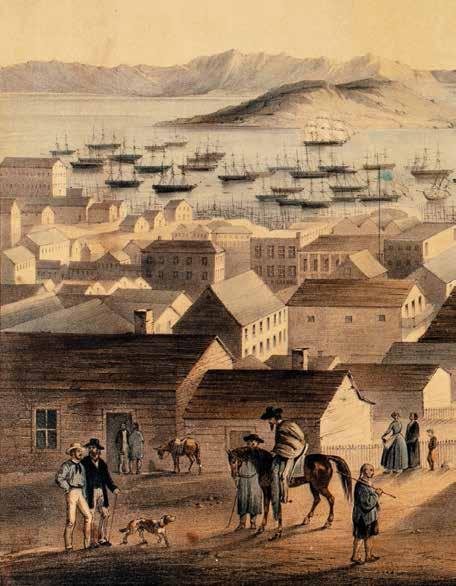
‘Poachers in the Garden of Eden’
As part of a minority, the Australians experienced a degree of persecution and were easy targets for blame. The Australians, with their distinctive accents and daring nature, were easily identifiable and were regarded as ‘poachers in the Garden of Eden’.1
Most Australians who arrived at the goldfields were well intentioned. They gained honest employment and worked hard to establish a new and better life. But six fires broke out in the city in 18 months, and with the authorities seeming to take no action, the rest of San Francisco looked for people to blame. Due to their less-than-stellar reputation, the natural suspects were the ex-British convicts, the Australians of Sydney Town, specifically those from New South Wales and Van Diemen’s Land (Tasmania).
A pattern had emerged: arson attacks never put San Francisco’s Sydney Town at risk. It was suspected that fires were being deliberately lit solely for the opportunity to plunder the homes and businesses of those absent fighting the fire. A protection racket also emerged, which shopkeepers would enter to ensure their stores wouldn’t burn or be plundered. While these actions were probably committed by only a few, they tainted the entire community. The Australians may well have been the rogue element committing these crimes, but corruption and a lack of government and law enforcement had allowed things to escalate to such levels.

1851: Vigilant citizens and a ‘terrific lynching’
The situation in San Francisco had become intolerable, and resulted in many respectable citizens leaving the city. It was felt that community action, similar to that taken against ‘The Hounds’ in 1848, was needed to deal with the arson and theft that were dominating the city.
As a result, the ‘Committee of Vigilance’ was formed by the city’s most respectable men on 9 June 1851. It originally counted some 700 members. Concerned with civil crimes, the Committee saw as their responsibility both the civic and moral betterment of the city, as well as restoring law and order and holding criminals accountable. The Committee intended to capture criminals before they could be apprehended by corrupt law officials. Their aim was simply to rectify a wrong – they were not a political movement, nor did they aspire to replace the judiciary in the long term.
One law in California, left over from the state’s previous Mexican administration, helped regulate the type of people allowed into its boundaries and ‘forbade the immigration into California of such persons as had been convicted of crimes in other countries’. However, this law was either forgotten or difficult to enforce during the rapid population growth of the gold rush.
It was partially reinstated by the Committee of Vigilance and extended to cover even those harbouring people with criminal records. All received the same treatment: forcible expulsion irrespective of their investment in the state. This uncertainty led many Australians to flee San Francisco.
But more drastic action was still needed to discourage crime, so the Committee needed to set a precedent: the mob became ‘Judge Lynch’. Those accused of a crime were tried before a jury of the Vigilance Committee and if found unanimously guilty, were dealt their punishment. Four Sydney Ducks were lynched (publicly hanged), 14 were deported to Australia, another 14 were informally ordered to leave California, 15 were handed over to public authorities, one was whipped and 41 were discharged. Two of the men lynched were ‘exceedingly bad characters’ and were ex-convicts from Sydney. The accused were not always found guilty – arrests could be appealed to the Committee on the basis of mistaken identity, or simply by proving to be a ‘good citizen’. To keep trials fair, the accused were always permitted to defend themselves, with evidence and witnesses needed for conviction.
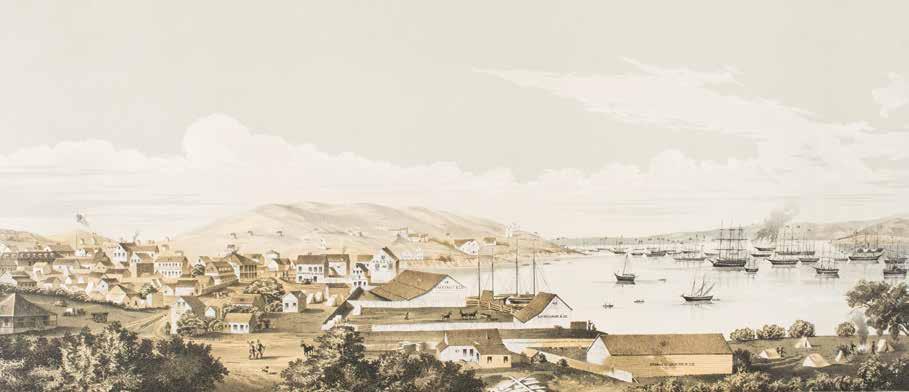
More than 200 vessels sailed from Australia to California between 1849 and 1851
One of the condemned, John Jenkins – often considered the leader of the Ducks – was caught red-handed stealing a safe. He was found guilty by a fair trial and publicly hanged on a street corner. Following Jenkins, James Stuart was apprehended for the murder of Mr Moore, the Sheriff of Auburn, Placer County, California, and the theft of Moore’s property. Initially, the wrong James Stuart was tried, found unanimously guilty and hanged –a case of mistaken identity. The real James Stuart was eventually captured and confessed his guilt. The error with the first James Stuart proves that the Committee was not infallible.
Samuel Whittaker and Robert McKenzie were also arrested for an unparallelled amount of crime, primarily robbery and endangering person and property. Both men were associates of Stuart and were implicated by him. They in turn implicated others. For several days the police acted to protect these men from ‘their majesties the mob’. Californian Governor John McDougall attempted to evade any actions of the Committee by moving the prisoners to the county jail so that proper legal proceedings could ensue; however, this further angered the Committee, who broke the prisoners out and continued their own judicial proceedings. Whittaker and McKenzie were found guilty and also lynched. Arguably, the actions of the mob did not diverge from what would have been meted out by the courts, as grand larceny (the unlawful apprehension of another’s property) was punishable by death.
As crime diminished in the city, power was handed back to city officials. The Committee had proved their point: crime had no place in San Francisco. Criminals had been sent a warning from the wider community. News of the Vigilance Committee reached a global audience and met with public approval, especially in Australia, where it was also feared lawlessness would arise due to the mass convergence on Australian goldfields. Adelaide newspaper the South Australian Register stated on Saturday 13 September 1856:
The moral effect of the action taken by the Committee of Vigilance in the city, has already been felt through the entire State. Were the Committee to disband to-day, with their work but half completed, the effect of what they have already done would be felt for the good of California in all future time.
By 1854, five years after the first Committee, San Francisco was again in a state of socio-political unrest. Fuelled by a lack of confidence in the capacity of the law and city officials, citizens reformed the Committee of Vigilance. It now numbered some 15,000 members and had many of the same leaders as the 1851 Committee. This time, however, the Committee was up in arms against political corruption rather than civil crime.
While the actions of the Ducks paved the way for the formation of the first Committee, nothing connects the Australian group to the reformed Committee of Vigilance in 1856. This helps explain why the engraving explicitly identifies San Francisco in 1856 rather than the precedent set by the events of 1851.
Further examples of the prevailing lawless state in 1856 included the killing of US Marshall William H Richardson, hung trials, bribery allegations and the exposure of criminal records and corruption among city officials. Some of these incidents led to the execution of four men under the second Committee of Vigilance – none of them Australian.

The engraving by Matt Morgan (page 34) demonstrates how one humble object can carry many layers of history and meaning. Engravings in this era were used as reportorial devices, sometimes with a dramatic flair. The engraving dates to 1872, a year of political elections in the United States. The caricature on the left is easily identifiable as President Ulysses S Grant, and the other men are his fellow party members. Lady Justice stands at the centre, but unlike in most depictions, she is not blindfolded, which implies a lack of objectivity and so represents a biased governance and judicial system. Also missing are the symbols of balance and punishment in law, usually indicated by levelled scales and a downward-facing sword. The text at the bottom reads:
BEWARE! – Not only has the rule of this philocracy become odious to the people, but so great is the indignation felt at the disregard of private rights, and lawless usurpation of power, that among law-abiding portions of the community a vigilance committee has been seriously proposed and discussed.
As the 1856 Vigilance Committee was politically motivated, the allusion in this engraving is clear. It is a graphic reminder of the power of the people and serves as a warning to politicians against corruption and acting against the benefit of the people.
The connection may seem tenuous, but these events hold relevance to the museum as a tangible link to the migratory patterns of the American and Australian gold rushes during this period.
1 Sherman L Ricards and George M Blackburn, ‘The Sydney Ducks: A Demographic Analysis’, Pacific Historical Review, Vol 42, No 1, p 23; Robert Senkewicz, Vigilanties in Gold Rush San Francisco, Stanford 1985, p 80. Nicole Dahlberg is a registrar at the museum and the descendant of convicted pickpocket William Price Hall, who was transported to New South Wales in 1823. He and his family later travelled to California, where they lived from 1850–1852, the very era of the Sydney Ducks – leading her to wonder whether she might be a ‘Duckling’!
This is an edited version of a post that first appeared on our blog, where footnotes and a list of sources can be found: see sea.museum /2018/05/02/the-sydney-ducks-and-the-san-francisco-49ers
01 San Francisco 1849, Henry Firks, lithograph. This image, drawn on the spot, provides a view of San Francisco’s transition from a small trading post to a major port due to the Californian gold rush.
ANMM Collection 00005550
02
Post Office, San Francisco, California, H F Cox, c 1850.
The discovery of gold caused a massive increase in San Francisco’s population and maritime activity.
The post office was the link to home for many migrants and was located at the centre of town.
ANMM Collection 00006900
Between April 1849 and May 1850, some 11,000 Australians arrived in California, an estimated 7,500 of them from Sydney
The true story of Yarri and Jacky has never been well known or properly recognised
A devastating flood in the New South Wales town of Gundagai killed almost a third of the town’s citizens in 1852. Many more would have died but for the efforts of local Wiradjuri men Yarri and Jacky, who rescued scores of people in their canoes. Community efforts to have the two men honoured with bravery awards have finally paid off, writes curator Dr Stephen Gapps .
THE MUSEUM HAS FOLLOWED THE LONG STORY of the efforts of Gundagai community members and descendants to have a posthumous bravery award given to two Aboriginal men who saved the lives of 68 people during the great flood of 1852. On 10 April, Governor-General Sir Peter Cosgrove presented bravery medals to Aunty Sonia Piper, from the Brungle community, and Roslyn Boles, a descendant of Yarri, at the annual awards ceremony in Canberra.
Wiradjuri men Yarri and Jacky used bark canoes to save lives when the Murrumbidgee River flooded the New South Wales Riverina town of Gundagai in June 1852. As the floodwaters rose to record levels over three days, the men picked up stranded townspeople in their canoes and took them to safety. The river was a torrent, full of snags and logs, and no other boats proved as useful as their canoes. Another 89 locals died – almost a third of the town’s population – as the original Gundagai township was swamped by two metres of water. It had been built on the flood plain, against the advice of local Aboriginal people.
Compared to that of the famous but mythical dog sitting on a tuckerbox five miles from Gundagai, the true story of Yarri and Jacky has never been well known or properly recognised. At the time, for their efforts in saving nearly a third of the township, Yarri and Jacky were given engraved breastplates and a small reward. Over time, some descendants of non-Aboriginal people saved by the two heroes had assisted in erecting plaques in their honour, but the story of two of the greatest lifesavers in Australian history had not received widespread recognition – until now.
More than 160 years after their heroic feat, the history of its remembrance – or rather, the lack of it – has finally changed.
In June last year the Cootamundra–Gundagai Regional Council unveiled a sculpture of Yarri and Jacky in the main street of Gundagai. In August 2018, community efforts to have posthumous bravery awards finally came to fruition. In April this year, the awards ceremony took place and medals honouring these two Wiradjuri heroes were presented by the Governor-General.
So next time you’re travelling along the M5 freeway, be sure to stop in at Gundagai and check out the sculpture, contemplate the heroic efforts of Yarri and Jacky and imagine the sight of the Murrumbidgee River in full flood.
You can read more about the incredible rescue on the museum’s blog: sea.museum/2017/11/24/yarri-jacky-great-flood-1852
From left: Roslyn Boles, a descendant of Yarri, and Aunty Sonia Piper, from the Brungle community, receive medals honouring their ancestors from Governor-General Sir Peter Cosgrove at the annual awards ceremony in Canberra.
Image courtesy Irene Dowdy
02
Statue of Yarri and Jacky in the main street of Gundagai, made by Melbourne artist Darien Pullen from the Meridian Sculpture Foundry.
Image Stephen Gapps/ANMM
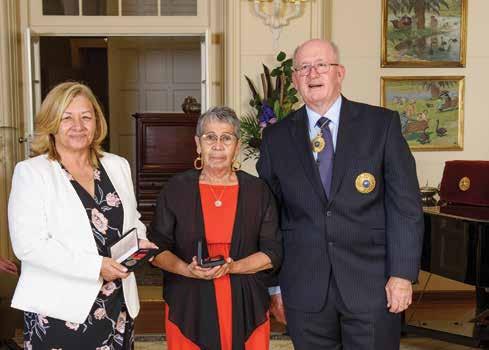

The voyage got off to an inauspicious start when just hours out of Bilbao, a Spanish passenger jumped overboard and had to be rescued
01
Article titled ‘Migrants rush ship bridge, shots fired’, Melbourne Sun, 30 June 1959. ANMM Collection Gift from Barbara Alysen ANMS0217[021]
02
Article titled ‘Migrants riot on liner, storm bridge’, Sydney Telegraph, 30 June 1959. ANMM Collection Gift from Barbara Alysen ANMS0217[022]
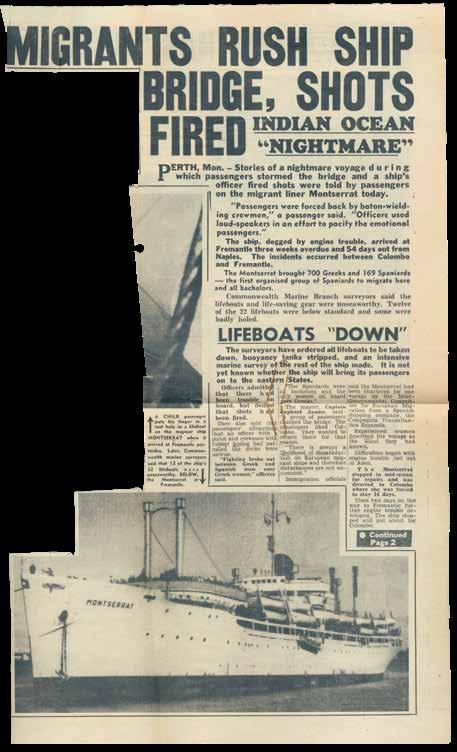
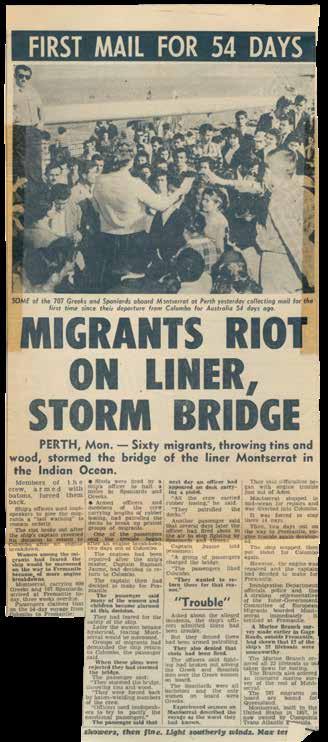
An archive of newspaper clippings in the museum’s collection documents a dramatic episode in assisted migration from Spain and Greece to Australia 60 years ago, writes curator Kim Tao. The nightmare 54-day voyage of the Montserrat was marred by engine trouble, fighting between passengers and crew, and even allegations of a mutiny by passengers in the middle of the Indian Ocean.
THE HEADLINES SAY IT ALL. ‘Irate migrants storm bridge.’ ‘Migrants fight crew at sea for fear ship might founder.’ ‘Migrants rush ship bridge, shots fired.’ ‘Officers accuse migrants of mutiny.’ And the triumphant, ‘We fought Spaniards’. These newspaper clippings were collected by Australian journalist Keith Woodward, who in the late 1950s was a Commonwealth representative for the Intergovernmental Committee for European Migration (ICEM), which helped to resettle the millions of Europeans displaced after World War II. Mr Woodward’s daughter, Barbara Alysen, donated his collection to the museum in 1994. Today it provides a fascinating insight into the drama that unfolded when ICEM chartered the Spanish liner Montserrat to carry more than 800 Spanish and Greek migrants to Australia in 1959.
Twenty-five-year-old Juan Zabalegui Ororbia was one of the 169 Spanish assisted migrants on board the Compañía Trasatlántica Española liner Montserrat (formerly Wooster Victory and Castel Verde). The Spanish contingent, all single young men, were travelling to Australia under the Spanish migration agreement’s Operation Eucalyptus. They had signed two-year contracts to work as cane-cutters in north Queensland, following the success of the first campaign, Operation Kangaroo, on Toscana, which brought 159 men to Brisbane in August 1958 (see Signals 124, pp 70–73).
Juan Zabalegui was born in 1934 in Artajona, a small town in the autonomous province of Navarra in northern Spain. He was the youngest of five siblings and his parents owned a small farm, on which they grew olives and grapes. In his late teens, Juan went to live with his sister, Gloria, and her husband, Braulio Zazpe, in Pamplona, the capital of Navarra and one of the largest cities in the greater Basque region. He worked for their butchery business and also joined the Spanish Army at the age of 21. It was in Pamplona that Juan saw an advertisement outside the city hall, promoting the recruitment of Navarrese and Basque men to cut sugarcane in Australia. After making initial enquiries, Juan passed the required medical tests and travelled to Madrid to obtain a permit from the army to excuse him from compulsory military service.
In May 1959, Juan bade farewell to his girlfriend, Goy Galdeano, and boarded the 9,000-ton Montserrat in the port of Bilbao. The voyage got off to an inauspicious start when just hours out of Bilbao, a Spanish passenger jumped overboard and had to be rescued. The ship continued to the Athenian port of Piraeus to embark some 700 Greek migrants, mostly families and single young women.
Montserrat passed through the Suez Canal and began to experience engine trouble after leaving the port city of Aden in Yemen. The vessel stopped mid-ocean for repairs and was then diverted to Colombo, Ceylon (now Sri Lanka), for further mechanical work. While in Colombo, Juan remembers visiting the markets with three friends from the ship, and seeing cows walking down the streets of the city. Due to the extended transit in Colombo, Juan decided to sell some of his winter clothes at the markets to have more spending money. This was supplemented by winnings from shipboard games of bingo.

After a two-week delay, Montserrat finally departed Colombo bound for Fremantle, Western Australia. However, just two days out of Colombo, more engine trouble developed. Once the engine was repaired, the ship’s master, Captain Raphael Jaume, resumed course for Fremantle. According to Juan, Captain Jaume had heard that the Greek migrants wanted the vessel to turn back to Colombo and were going to force the issue. He approached the Spanish migrants early one morning to request that they arm themselves with weapons, in order to help defend him and the crew. Juan laughingly recalls that their ‘weapons’ were chair and table legs that had been broken off the shipboard furniture.
The incidents that ensued were widely reported in the media.
The Sydney Telegraph wrote:
Sixty migrants, throwing tins and wood, stormed the bridge of the liner Montserrat in the Indian Ocean. Members of the crew, armed with batons, forced them back. Ship’s officers used loudspeakers to give the migrants a ‘last warning’ to remain orderly. The riot broke out after the ship’s captain reversed his decision to return to Colombo after an engine breakdown. Women among the migrants had feared the ship would be marooned on the way to Fremantle.1
The Daily Express cited the following passenger account:
The women became hysterical. They feared the ship would sink. They rushed the bridge and pelted the officers with tins and chunks of wood. Then they demanded that Captain Jaume head back to Ceylon. The passenger said that seamen beat the women off the bridge with batons and lengths of rubber hose. Another passenger said an officer fired shots in the air.2
According to the newspapers, the ship’s officers regarded the disturbance as mutiny, while experienced seamen described the Montserrat voyage as the worst they had ever known. Officers claimed that the fighting had broken out between the Greek and Spanish men (the latter were all bachelors) over the Greek women.
On 29 June 1959, Montserrat finally docked in Fremantle, three weeks overdue. The vessel was met by police and officials from the Department of Immigration, as well as Mr A W Clabon, Australia’s ICEM representative. Mr Valeriano Gonzales, a naval architect, attended on behalf of Montserrat ’s Spanish owners to investigate the causes of the ship’s delay. A survey by the Commonwealth Marine Branch later declared 12 of the ship’s 22 lifeboats to be unseaworthy. Some were badly holed and it was alleged that a shipwright’s foot went through the bottom of one lifeboat during the examination.
Captain Jaume was fined £500 for failing to maintain lifesaving appliances fit and ready for use at all times. He agreed to the termination of the Montserrat voyage in Fremantle and the Compañía Trasatlántica Española was forced to pay about £15,000 to cover the onward travel of its passengers.
The Greek migrants were transported to the eastern states by either chartered flight or transcontinental train, while the Spanish contingent were sent to Victoria on a separate train. Juan remembers that the Spanish men spent three weeks at the Bonegilla Migrant Reception and Training Centre near Wodonga, before being transferred by truck to board a train to Ingham in north Queensland.
Apart from a brief period living in Spain in the mid-1970s, Juan and Goy have called Melbourne home for the past 60 years
01
02 Twenty-five-year-old
All images reproduced courtesy Melissa Zabalegui unless otherwise stated
In Ingham, the Spanish migrants from Operation Eucalyptus were immediately put to work cutting sugarcane by hand. They started at 4 o’clock in the morning and were expected to cut 12,000 to 15,000 kilograms of cane per day. At night the cane-cutters slept in a shed, their white mosquito nets turning black from the swarm of mosquitoes. Juan, who had been a butcher in Spain, was not accustomed to such hard agricultural labour in the tropical heat. After three months, he contracted a finger infection and was taken to hospital.
Once he had recovered, Juan decided to head to Sydney with a friend, even though both men had not yet completed their twoyear labour contracts. Following a dispute with the owner of the cane farm, the two departed Ingham without their final pay and boarded a train to Sydney. After taking a look around, they resolved to try their luck in Melbourne instead, as Juan’s friend had relatives living there. The two men arrived in Melbourne at about 10 o’clock on a rainy Saturday night. Juan’s friend took a taxi to visit his family and Juan was left on his own, in the pouring rain, with just £6 in his pocket.
Juan walked around the deserted city and eventually found a café staffed by an Italian man, who directed him to a nearby Spanish club. Coincidentally, one of the men at the club came from the town of Larraga, about 10 kilometres from Juan’s hometown of Artajona, while others had arrived on the Toscana in 1958. Juan explained his situation and was offered a bed for the night.
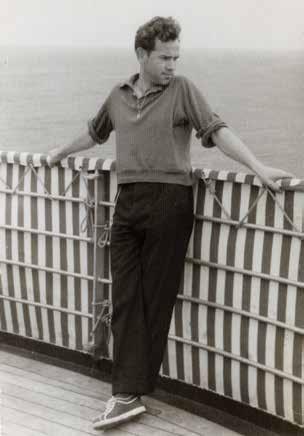
In time, Juan obtained a room in a boarding house in Victoria Parade, and took a job washing dishes in the kitchen of the Oxford Hotel on Swanston Street. Within six months, he was promoted to a cook after the hotel chef noticed his fine knife skills, developed during his time as a butcher in Pamplona. Juan went on to work in various wholesale butcheries and also started making jamón (ham) and chorizo (sausage), which he sold door to door around the inner-city suburb of Fitzroy, the traditional centre of Melbourne’s Spanish community.
In July 1960, Juan was reunited with his girlfriend Goy Galdeano, who arrived in Melbourne with the first planeload of female Spanish assisted migrants to Australia. Before leaving Spain, the women received a short course in religious education, cooking and sewing from the Spanish Catholic Commission of Emigration. Goy lived with family friends until she and Juan were married at St Patrick’s Cathedral in August 1961. Goy, who had trained as a seamstress in Pamplona, made her own wedding dress. She found work as a designer, dressmaker and occasional model at Arnel Fashions on Flinders Lane, the heart of Melbourne’s fashion industry. Juan and Goy had two children, Xavier and Melissa, and apart from a brief period living in Spain in the mid-1970s, they have called Melbourne home for the past 60 years.
1 ‘Migrants riot on liner, storm bridge’, Sydney Telegraph , 30 June 1959.
2 ‘Liner riot over women’, Daily Express , 30 June 1959.
Goy Galdeano (centre, in white striped top) with the first group of female Spanish assisted migrants to Australia, 1960. Juan Zabalegui on board the troubled Spanish liner Montserrat, 1959.There are plenty of reasons to visit the museum this winter, including our new exhibition, Bligh: Hero or Villain?, our annual favourite, Wildlife Photographer of the Year, a program of Aboriginal cultural cruises and a range of engaging Ocean Talks.
THE RELATIONSHIP between the Australian National Maritime Museum and its Members is very important to us. Your feedback is highly valued, as it enables us to adapt and change according to your suggestions and preferences.
From July you will start to see some of these changes. Our current membership program will morph into three options, designed to provide different experiences and cater for individual interests.
• Captains Circle Members of the Captains Circle will be invited to exclusive events and given behindthe-scenes access to our collection. Our curators add a wealth of knowledge to these unique experiences. Members commit to donating $3,000, or three annual instalments of $1,000. $900 of the membership each year is tax deductible.
• Museum Membership This is the current membership offering.
• Annual Pass This provides free access to the museum but removes the quarterly issue of Signals. This membership continues to provide entry to the children’s program, value-based experiences for families and reciprocal access to other museums.
When you receive your next renewal notice, you will be asked to decide which membership program best suits your needs.
As a member of the ANMM, you have access to some amazing benefits. Not only do you get to visit other great institutions such as Questacon and the National Museum of Australia, we have great offers such as discounts to the Australian Brandenburg Orchestra. For more details, look out for our emails or visit our website.
Over the coming months, you will hear more about our special funds that support upcoming and ongoing projects. These include the Migration Heritage Fund, the Steam Yacht Ena Conservation Fund, and Encounters 2020, which will mark the 250th anniversary of James Cook’s charting of the east coast of Australia. Your support of these programs would be greatly appreciated.
Finally, the next meeting of the museum’s Book Club, on 29 July, will discuss Annie Proulx’s acclaimed novel The Shipping News. The Book Club meets at 11 am on the last Monday of the month in the Vaughan Evans Library in our Wharf 7 building. If you are interested in joining (the more the merrier!), please call 02 9298 3646.
We look forward to seeing you at the museum. In the meantime, keep your feedback flowing. We welcome suggestions of further ways to enhance your membership experience.
Oliver Isaacs, Manager Members
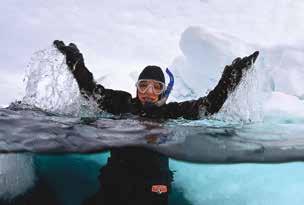
For carers with children 0–18 months
Seaside Strollers tours and play
10.30 am or 12.30 pm Monday 24 June
Tour: Wildlife Photographer of the Year ; play: Sensory Jungle theme;
Harbour Cruises
Tall Ship Whale and Sail
10.30 am–3 pm Saturday 29 June
Track migrating whales aboard the beautiful tall ship Søren Larsen
Ocean Talks
Aboriginal perspectives of Sydney Harbour
6–8 pm Thursday 4 July
Four leading Aboriginal art and cultural practitioners share stories of the harbour
One-day youth photography workshop
Cockatoo Island Photo Story
10 am–4.30 pm
Wednesday 10 or Wednesday 17 July
Kids aged 8–14 can build skills in using digital SLR cameras and manual modes
Access program
Sensory-friendly Sundays
8.30 am–11.30 am
Sundays 14 and 21 July
A comfortable environment for kids and adults with sensory differences
Two-day youth workshop
Underwater Explorers –TV presenting 10 am–4.30 pm
Wednesday 17 and Thursday 18 July
Kids aged 8–14 can capture footage on our underwater drones and use it to create their own imaginative TV segments
Family Torchlight tour
Bookings and enquiries
Booking form on reverse of mailing address sheet. Please note that booking is essential unless otherwise stated.
Book online at sea.museum/whats-on or phone 02 9298 3646 (unless otherwise indicated) or email members@sea.museum before sending form with payment. Minimum numbers may be required for an event to go ahead. All details are correct at time of publication but subject to change. Members are advised to check our website for updated and new event information.
Twilight on a tall ship
6–7.30 pm Thursday 18 July
A dramatic after-dark tour through HMB Endeavour with your character guide
For carers with children 0–18 months
Seaside Strollers tours and play
12.30 pm Tuesday 30 July
Tour: Bligh – Hero or Villain? ; play: Under the sea theme
Ocean Talks
Bligh – Hero or Villain?
6–8 pm Thursday 8 August
A lively debate exploring the many sides of the infamous William Bligh
Harbour Cruises
Aboriginal perspectives of Sydney Harbour cruise
1–3 pm Sunday 11 August or 10 am–12 pm Wednesday 14 or Thursday 15 August
Featuring stories of Sydney Harbour’s Aboriginal people and a visit to Clark Island
Harbour Cruises
Navigation by the stars
6–9 pm Saturday 17 August
Stargaze aboard Tribal Warrior’s Mari Nawi while the ship’s Aboriginal crew explain traditional techniques used in celestial navigation
For carers with children 0–18 months
Seaside Strollers tours and play
12.30 pm Monday 19 August
Tour: Elysium Arctic ; play: Winter Wonderland theme
Ocean Talks
Bligh and Extreme Modern Journeys
6–8 pm Thursday 5 September
Michelle Lee and Alex Luther discuss how they achieved incredible feats of endurance
Date for your diary
Saturday 23 November –Members Anniversary Lunch
Aboriginal Perspectives of Sydney Harbour
6–8 pm Thursday 4 July
How well do we really know the history of Sydney Harbour? Four leading Aboriginal art and cultural practitioners share stories of the harbour as you’ve never seen or heard them before. These fascinating speakers will discuss the various methods they use to interpret Sydney Harbour’s rich Aboriginal history and the cultural connections still thriving today.
A highlight of the evening will be a demonstration of incredible 3D virtual worldscapes that intricately map Sydney Harbour’s pre-colonisation landforms and its development from traditional Aboriginal owners to the Sydney we know today.
Join a vibrant panel discussion of insights into the first fully Aboriginal-operated circumnavigation of Australia, maintaining cultural legacies, Aboriginal digital mapping and sharing cultural voices through art.
Member $20, general $35, concession/student $20.
Includes light refreshments; cash bar available
3D representation of modern Sydney overlaid on traditional Aboriginal lands. Image courtesy Brett Leavy
6–8 pm Thursday 8 August
William Bligh is almost universally portrayed as a villain in films and books, but does this view withstand scrutiny today? This lively debate challenges the stereotypes, looking beyond the mutiny on HMS Bounty to explore the many sides of Bligh – a highly skilled seaman who became one of the maritime world’s most infamous figures.
What’s not in doubt is that Bligh’s life was extraordinary – he caused controversy on land and sea. He was an officer of the Royal Navy, a survivor of a brutal mutiny at sea, and a governor of New South Wales, whose actions caused a military coup that became known as the Rum Rebellion.
Come and judge for yourself as we hear from author Peter FitzSimons, who will argue that Bligh was a tyrant and villain, and Rear Admiral Peter Briggs, whose stance is that Bligh was a heroic figure and strong leader. The debate will be moderated by museum curator Stephen Gapps.
Member $20, general $35, concession/students $20.
Includes light refreshments and exclusive access to the exhibition Bligh – Hero or Villain? from 5–6 pm. Cash bar available Rear-Admiral William Bligh, Alexander Huey, 1814. National Library of Australia nla.obj-136207002
Ocean Talks
Bligh and Extreme Modern Journeys
6–8 pm Thursday 5 September
Do modern-day extreme journeys match the tenacity and skills demonstrated by William Bligh and his loyal men who, in 1789, navigated 6,500 kilometres of treacherous seas, eventually reaching safety in Timor?
That’s the question we will pose to two modern adventurers, Michelle Lee and Alex Luther, as they discuss how they achieved their own incredible feats of endurance.
Sydney-based adventurer Alex Luther water-skied 3,800 kilometres from Africa to Italy in less than 10 days – despite never having previously water-skied! He was driven by a desire to re-create the journey that his grandfather, marathon water-skier Harry Luther, completed in 1970. Michelle Lee has just returned from completing a two-month solo rowing odyssey across the Atlantic Ocean, covering a distance of more than 5,000 kilometres.
In this lively discussion hosted by Senior Curator Daina Fletcher, Bligh’s dramatic journey of real-life survival will be compared with the experiences of these modern-day ocean adventurers.
Member $20, general $35, concession/students $20.
Includes light refreshments and, from 5–6 pm, exclusive access to two exhibitions: Bligh – Hero or Villain? and an 80th anniversary display about Oskar Speck’s seven-year solo kayak journey from Germany to Australia.
Alex Luther during his marathon waterskiing challenge. Image courtesy Alex Luther


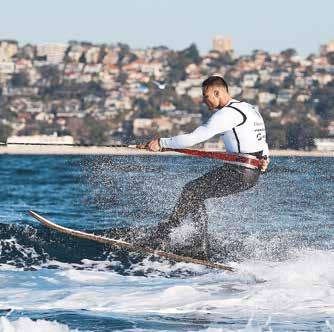
Refugee Week program
Finding Your Feet tapestry workshops
Monday 17–Friday 21 June
Join textile artists Sayd Abdali and Jane Théau to help us make a tapestry rug during Refugee Week. The design of the rug celebrates the new lives that refugees begin in Australia.
Sayd Abdali is a master Afghan tapestry artist. He has developed a unique needle to weave his designs through a technique known as punch needling (or tufting). Sayd is an expert in this technique, using it to support his family for 30 years while living as a refugee in Iran.
Presented in partnership with Settlement Services International.
Free. No bookings required, but please check our website for times. Suitable for ages 7 and above; all materials provided and no experience necessary
Harbour Cruises
Tall Ship Whale and Sail
10.30 am–3 pm Saturday 29 June
Calling all whale enthusiasts! You won’t want to miss this unique experience. Board the beautiful tall ship Søren Larsen for a whale-watching cruise to remember, sailing through Sydney Heads then along the whales’ migration path. The quiet running of this vessel ensures low impact on the animals, and its open deck provides unrestricted views.
Relax and enjoy a leisurely cruise, or take a more active part by hoisting the ship’s sails with the crew or climbing the ropes up to the crow’s nest for a real bird’s eye view!
Member $135, general $149, concession $135, family $485. Includes a delicious warm lunch plus morning and afternoon tea
Søren Larsen at sea. Image courtesy Søren Larsen
Harbour Cruises
Aboriginal Perspectives of Sydney Harbour cruise – Science Week
1–3 pm Sunday 11 August or 10 am–12 pm Wednesday 14 or Thursday 15 August
Enjoy an alternative view of Sydney Harbour with the Aboriginal crew of Tribal Warrior’s Mari Nawi (Big Canoe), including a visit to Clark Island National Park (Be-lang-le-wool).
Member $45, general $55, concession $45, student $20. Includes afternoon tea
Harbour Cruises
Navigation by the Stars – Science Week
6–9 pm Saturday 17 August
Stargaze on Sydney Harbour aboard Tribal Warrior’s Mari Nawi and listen to the ship’s Aboriginal crew explain traditional techniques used in celestial navigation.
Member $80, general $95, concession/student $80. Includes warm light refreshments
For more information on the content of these cruises, please visit our website.
Please note: stargazing is dependent on clear skies. If forecasts indicate that bad weather is expected, the cruise will be cancelled by 2 pm on the day of sailing, and passengers will be notified and refunded.
NGC 362, a globular cluster located in the constellation Tucana in the Southern Hemisphere, slightly north of the Small Magellanic Cloud. Courtesy NASA/JPL-Caltech
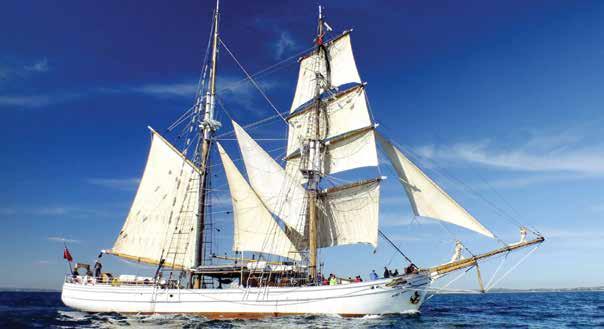
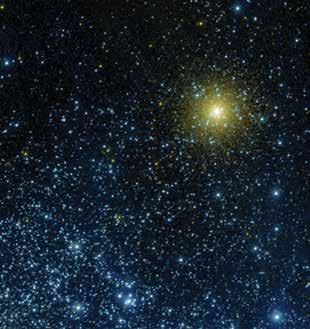
and holiday programs
Hands-on science
Underwater drone challenge
11 am–3 pm Saturdays and Sundays; daily during school holidays
Discover what’s under Sydney Harbour without getting wet! Learn to pilot an underwater drone. Show off your gaming console skills in the outdoors and challenge family and friends to see who’s the best u-drone pilot! Then at home, relive your explorations with video footage from your dives. For ages 9 and above. Suitable for wheelchair users.
Bookings essential. Session times and prices at sea.museum/drone
An underwater drone ready for deployment. ANMM image
NAIDOC Week celebration
Saltwater Sunday
10 am–4 pm Sunday 7 July
Join us as we celebrate NAIDOC Week at the museum with a day of creative cultural activities suitable for all ages. Enjoy lively performances, art-making activities, face painting, storytelling and more.
Included in any paid admission. No bookings required
Access program
Sensory-friendly Sundays
8.30 am–11.30 am Sundays 14 and 21 July
Enjoy a comfortable environment for kids and adults with a variety of sensory differences. On Sensory-friendly Sundays, our exhibitions and activity space will be open early for a quieter experience and modified to suit people on the autism spectrum and with a range of differing abilities. Our trained staff and volunteers will be on hand to facilitate creative activities.
Child or adult $12. Members free. Bookings essential at sea.museum/ schoolholidays
programs – term time
Kids craft and play
Kids on Deck Sundays
11 am–3 pm every Sunday during school term
Play, create and discover at Kids on Deck with art making, interactive games and dress-ups every Sunday!
Members free. Included in any paid admission. No bookings required ANMM image

Under 5s activities
Mini mariners program
10–10.45 am and 11–11.45 am every Tuesday during term time and one Saturday each month
Explore the galleries, sing and dance in interactive tours with costumed guides. Enjoy creative free play, craft, games, dress-ups and story time in our themed activity area.
June – Art Adventures
July – Pirates Ahoy August – Terrific Transport
For ages 2–5 + carers. Members free, child $8.50, first adult $3.50, extra adult $7 (includes galleries ticket). Booked playgroups welcome. Bookings essential at sea.museum/under5s
For carers with children 0–18 months
Seaside Strollers tours and play
10.30 am or 12.30 pm Monday 24 June –
tour: Wildlife Photographer of the Year ; play: Sensory Jungle theme
12.30 pm Tuesday 30 July –
tour: Bligh – Hero or Villain? ; play: Under the sea theme
12.30 pm Monday 19 August –
tour: Elysium Arctic ; play: Winter Wonderland theme
Member adult $15, general adult $20, babies free. Includes morning or afternoon tea and admission to the exhibition.
Bookings essential at sea.museum/stroller

Family programs – school holidays
Sunday 7–Sunday 21 July
Imagination meets the sea these holidays as you follow our trail of playful creative spaces through the galleries. There’s a full day of fun for the family, with vessels and exhibitions to explore, 3D cinema screenings, workshops and more.
Young photographer at Cockatoo Island. ANMM image
Creative workshops for 8–14 years
One-day youth photography workshop – Cockatoo Island Photo Story
10 am–4.30 pm
Wednesday 10 or Wednesday 17 July
Ferry out to Cockatoo Island for an adventurous photography workshop. Build skills in using digital SLR cameras and manual modes – aperture, shutter speed, macro and more – as you explore this fascinating maritime location. Then have your best images displayed in a special exhibition at the museum. Suitable for all levels of experience.
Member $85, general $95. Includes ferry transport, digital photo files and two large-format prints. Bookings essential at sea.museum/schoolholidays
Family torchlight tour
Twilight on a Tall Ship
6–7.30 pm Thursday 18 July
Join your character guide for a dramatic after-dark tour through HMB Endeavour Enjoy creative capers, light refreshments and exclusive after-hours access to the vessel. For ages 4–12 and adults. Minimum height 90 cm
Members: child $20, adult $14; general child $24, adult $18. Bookings essential at sea.museum/schoolholidays
ANMM image
Choose your own adventure Imaginarium Trail
10.30 am–4.30pm daily
Sunday 7–Sunday 21 July
Visit our four fun-filled creative activities and experiences across the museum. Create spectacular handmade creations to keep at Kids on Deck, our maker space. Chill out in the Plankton Disco sensory zone, and sketch stories and songs of the sea in our audio drawing cave. Make your own mini museum – collect, research and display artefacts and specimens with your own stories and designs. Or build, build, build in our construction zone.
Entry to all zones included in Big Ticket admission. Entry to Kids on Deck included in any paid admission. Members free. No bookings required
Two-day youth workshop
Underwater Explorers –TV presenting
10 am–4.30 pm
Wednesday 17 and Thursday 18 July
Explore the world beneath the surface as you capture footage on our underwater drones and use it to create your own imaginative TV segments inspired by ocean environments. Learn clever techniques in green-screen, scripting, directing, acting and film-making as you produce your own creative digital stories. Have your finished work displayed for family and friends in a special-event cinema screening.
Members or early bird (before 10 July) $140; general $160
Activity trails
Available every day in school holidays
Explore Wildlife Photographer of the Year with a fun and creative activity trail.
Included in museum entry
Stay up to date with the full program of family events and activities by subscribing to our monthly newsletter at sea.museum/kids

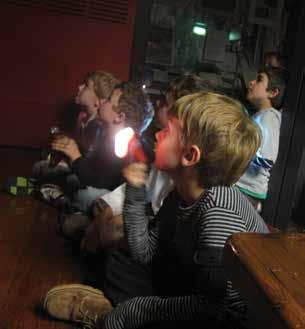
Canoes of the Massim islands, Papua New Guinea.
Drawings David Payne/ANMM
1 August–29 September
The Massim culture of Papua New Guinea is home to a unique collection of colourful outrigger canoes used for trade, and which are vital to the significant inter-island and community exchange of precious artefacts known as kula.
The remote islands in the Solomon Sea off Milne Bay in eastern Papua New Guinea depend on traditional and contemporary versions of their original single-outrigger sailing canoes for trade and communication. The museum’s Curator of Historic Vessels, David Payne, spent the whole of August 2017 on assignment with research colleagues, travelling by launch through the Massim islands, meeting the communities and documenting their amazing canoes.
Back in Australia, David developed his field notes and dimensions into accurate plans – the first time this has been done for many of the craft the team located. These beautiful large-scale drawings capture the canoes’ intriguing construction, their sail and rig layout, and the details of their wonderful carving. A dozen different canoe types are on show and the drawings reveal each canoe’s individual characteristics.

From
Elysium Arctic follows a team of worldrenowned explorers, photographers and scientists into the icy regions of the High Arctic. Led by acclaimed wildlife photographer Michael Aw, the Elysium team produced a series of artworks showcasing the extreme beauty of the polar north.
Elysium Arctic captures the uniqueness of the Arctic environment at a time when climate change is threatening its very existence. Michael Aw believes that art can inspire action on climate change – explore the magic of the High Arctic and see for yourself. Elysium Arctic is the museum’s newest outdoor exhibition, located outside Wharf 7.
Eskimo Bukta at Scoresby Sund, Greenland (detail). Image © David Doubilet/Elysium Arctic
Until 25 August
This world-renowned exhibition features 100 awe-inspiring images, from fascinating animal behaviour to breathtaking landscapes. Wildlife Photographer of the Year is the most prestigious photographic event of its kind, providing a global platform that has showcased the natural world’s most astonishing and challenging sights for more than 50 years. Wildlife Photographer of the Year is developed and produced by the Natural History Museum, London. Night Snack, Audun Rikardsen. © Audun Rikardsen/Wildlife Photographer of the Year
William Bligh is almost universally portrayed as a villain in movies and books, but does this view stand scrutiny today? Bligh – Hero or Villain? challenges this popular narrative, looking beyond the Bounty mutiny to explore the many sides of this infamous maritime figures. Come and judge for yourself – but be prepared for surprises!
Darling Harbour is called Gomora in the Sydney Aboriginal language and is part of the traditional lands (bamal, or earth) and waters (badu) of the Gadigal people. Bamal Badu is a digital art installation that acknowledges the long history of the place where the museum is located and honours and respects the Aboriginal people who lived and continue to live around Sydney Harbour. The installation will take visitors on a virtual journey through the lands and waters of the traditional owners of the Sydney Harbour area and emphasise the importance of acknowledging and respecting our First Peoples.
Bamal Badu is a collaboration with Aboriginal digital artist Brett Leavy of Virtual Songlines
11 am, 2 pm and 3 pm daily
Currently screening:
Oceans 3D: Our Blue Planet takes you on a global odyssey to discover the largest and least-explored habitat on earth.
Earthflight 3D follows a variety of bird species on their seasonal journeys. Embrace the thrilling feeling of being plunged into the centre of the flock! Narrated by Academy Award-winning actor Cate Blanchett.
Included in any paid entry. Please check availability at sea.museum/3dcinema as sessions may occasionally be cancelled due to event bookings

Developed by the Tasmanian Museum and Art Gallery (TMAG) and funded by Visions of Australia, this communitydriven project celebrates the survival and transfer of knowledge across generations via shell stringing. This exhibition is a tribute to the ancestral women who against all odds continued shell stringing as an act of resistance and cultural defiance. Most of all, it pays homage to the women of Cape Barren Island, who have preserved this tradition to the present day.

117 Tibbereena Street, Narrabri, NSW
Until 28 July
The museum’s first-ever outdoor exhibition is dedicated entirely to the history and impact of the humble shipping container. The exhibition goes beyond the corrugated steel to reveal the fascinating story of this revolutionary maritime invention. Housed entirely within specially modified 20-foot containers, the exhibition quite literally takes visitors ‘inside the box’ to explore the economic, geographic, technical, environmental, social and cultural history and impact of containerisation.
Clash of the carriers: Battle of the Coral Sea panel display
Various dates and venues in Australia and the USA
Fought between combined United States and Australian naval and air forces and the Imperial Japanese Navy, this was the world’s first sea battle between aircraft carriers. Literally ‘fought in the air’, it was also the first naval battle in which opposing ships neither saw nor fired on each other. This exhibition is part of the ‘War and Peace in the Pacific 75’ program.
Created by the Australian National Maritime Museum’s USA Programs supported by the USA Bicentennial Gift Fund
Australian Sailing Hall of Fame 2018 panel display
Various dates and venues
This graphic panel exhibition features the stories of the inaugural inductees into the Australian Sailing Hall of Fame. These greats of the sport have produced some of Australia’s most memorable sporting moments – in the America’s Cup, the Olympics, blue-water racing and world sailing.
The Australian Sailing Hall of Fame touring exhibition is developed by the Australian National Maritime Museum in partnership with Australian Sailing
Guardians of Sunda Strait panel display
Various dates and venues in Australia and the USA
On the night of 28 February–1 March 1942, HMAS Perth and USS Houston fought bravely and defiantly against overwhelming odds – outnumbered and outgunned by a large advancing Japanese naval force – as they approached Sunda Strait. Both ships sank that dreadful night in the Battle of Sunda Strait. This exhibition is part of the ‘War and Peace in the Pacific 75’ program.
Created by the Australian National Maritime Museum’s USA Programs supported by the USA Bicentennial Gift Fund
Submerged banner display
Various dates and venues
The Australian Maritime Museums Council (AMMC) and the Australian National Maritime Museum partnered to develop the graphic panel display Submerged: stories of Australia’s shipwrecks. Content was developed by AMMC members at maritime heritage organisations across the country, and merged into a nationally touring display by the museum. This display is supported by Visions of Australia
Homefront panel display
Various dates and venues in Australia
Banner display developed and written by students from schools in Australia, the USA and Japan. The exhibition will tour schools who have registered with our ‘War and Peace in the Pacific 75’ program, which is supported by the USA Bicentennial Gift Fund.
Shackleton: Escape from Antarctica panel display
Various dates and venues in Australia
Through dramatic photographs taken by Australian photographers Frank Hurley and Keith Jack, Shackleton: Escape from Antarctica walks in the footsteps of these intrepid expeditioners and their team mates. Discover what happened to these brave men and their ships in the frozen Antarctic wilderness.
Indigenous Watercraft panel display
Various dates and venues around Australia
Since the First Fleet, 10 million people have settled in this country and made Australia home. With them have come 270 languages to join the estimated 250 Australian Indigenous languages and more than 600 dialects. Discover the different words to represent unique Indigenous watercraft specific to particular areas all around the country.
Banner and panel displays
There is no cost to host the majority of travelling graphic panel displays. For bookings and enquiries, please contact touringexhibitions@sea.museum
An unknown species of deep-sea octopus, discovered on a deep dive during the Elysium Arctic expedition. Image Michael Aw
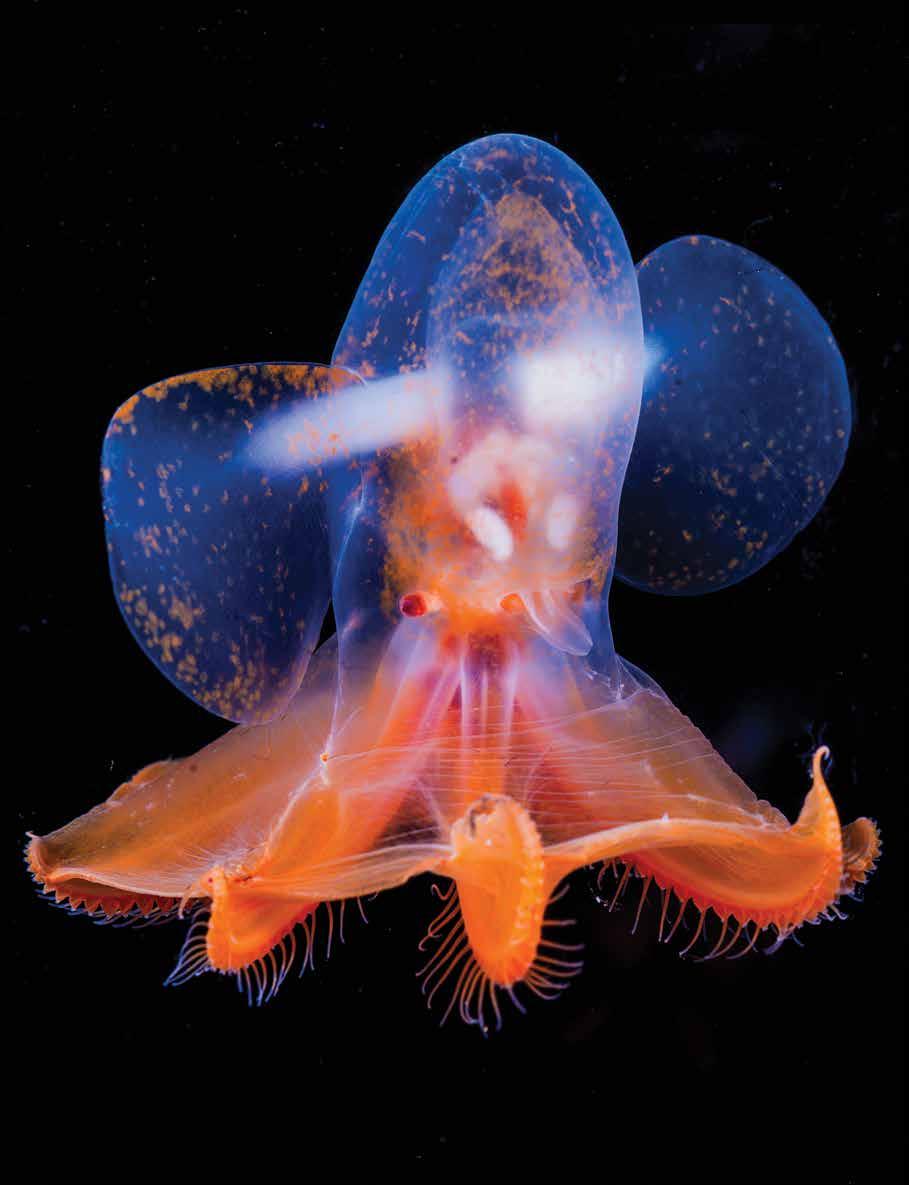
The cage enabled the driver to travel underwater effortlessly and at greater speeds without fear of predators
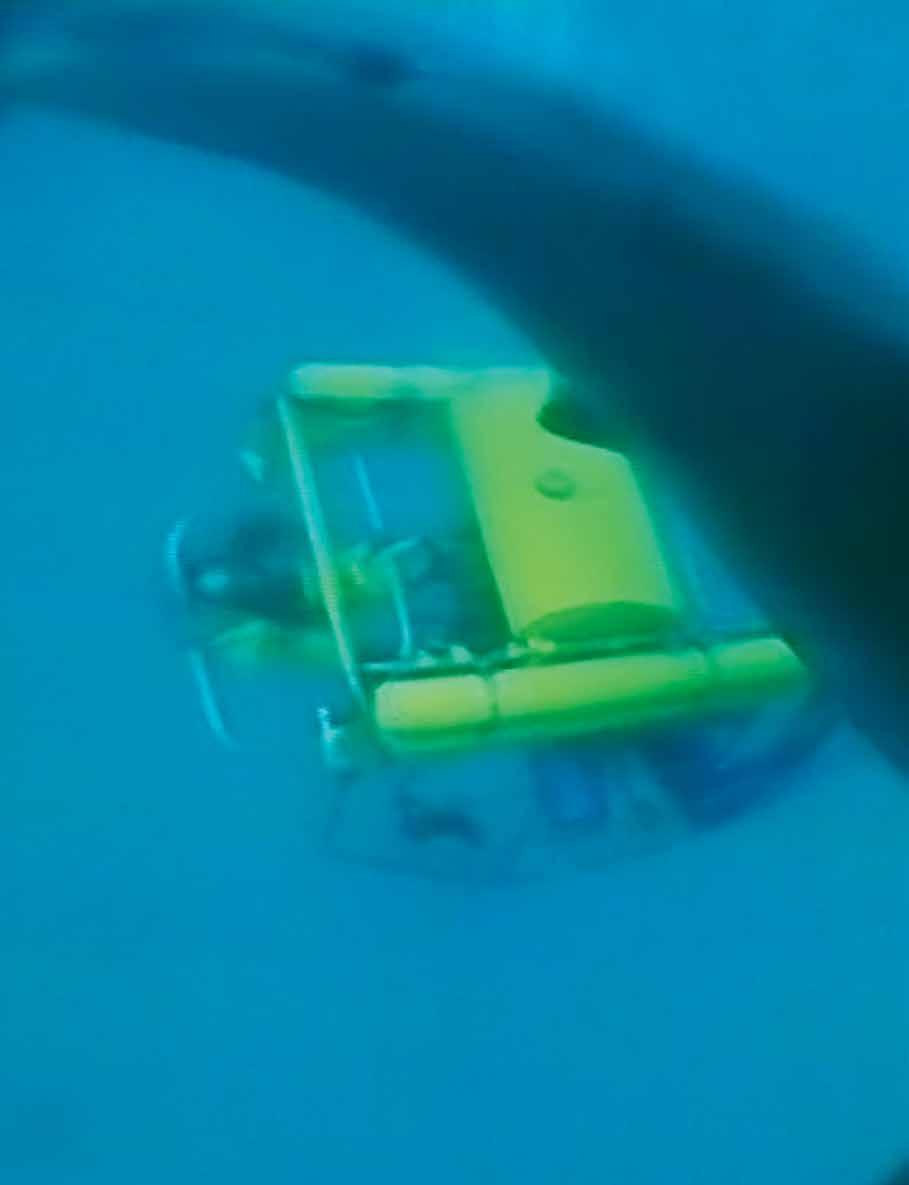

The self-propelled shark-proof cage was invented in the 1970s by abalone diver James Ellis of Port Lincoln, South Australia. Curator of Ocean Science and Technology Emily Jateff interviewed James Ellis, to dig deeper into the development of a significant late-20th-century technological innovation for the abalone diving industry.
A sealed compressedair motor was mounted on rotatable gimbals at the front of the cage, making the vehicle highly manoeuvrable
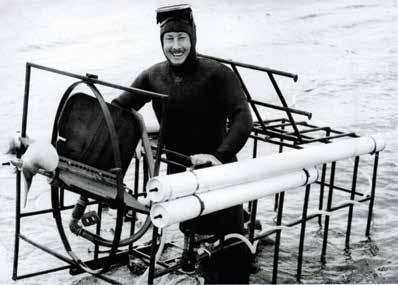
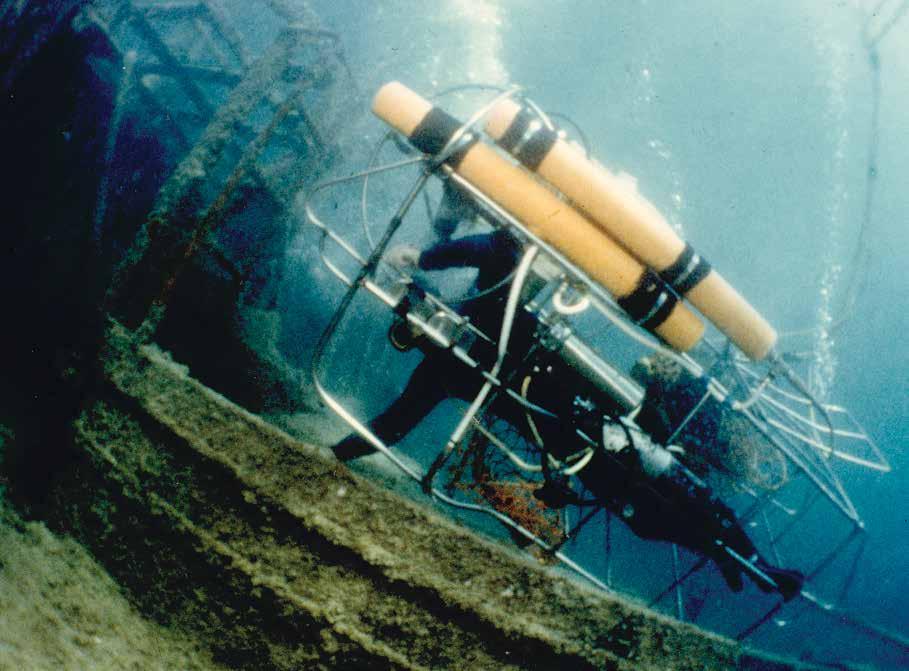
01
Jim Ellis with his prototype self-propelling shark-proof cage, March 1975. He used the cage for seven years and never encountered any great white sharks. When the cage was eventually retired from duty, his kids added wheels and used it as a go-kart. Image Newspix
02
Using the cage to collect abalone from the wreck of the Degei, c 1977.
IN JANUARY 1974, James Ellis began constructing a selfpropelled shark-proof cage for use in the abalone diving industry. The aim was for the diver inside the cage to work safely close to the seabed:
Many [abalone] divers, including me, thought we were relatively safe when diving on compressed air as no diver had been attacked by a shark until Terry Manual was taken by a great white at Streaky Bay in January 1974. In January 1975 surfer David Barrowman was lost at Almonta Beach, presumably taken by a shark, and the following month Wade Shippard was attacked while swimming to a cray boat at Point Sinclair. Abalone diver Robert Slack was taken in Tasmania in July 1975. This had a huge impact on the abalone industry and the number of working divers went from 45 to 20.
I had been thinking about making a powered vehicle to collect abalone for some time, but I was now motivated to build something for protection as well. The obvious problems were powering a vehicle with 100 metres umbilical hose, manoeuvring it to collect abalone and being able to do so for up to seven hours a day. I received a lot of ragging when I announced I was going to build a self-propelled shark-proof cage to collect abalone.
The frame was built from half-inch (12-millimetre) steel tube with 100-millimetre PVC tubing to give it neutral buoyancy. A sealed compressed-air motor was mounted on rotatable gimbals at the front of the cage, making the vehicle highly manoeuvrable. It could change direction instantly, both vertically and horizontally. Direction was achieved by pointing the motor where required, and speed by rotating the same ‘joy stick’. The propeller was pitched so as to pull the machine through the water. A wing-shaped tank was mounted on top of the vehicle from which excess air could be vented to compensate for increase in weight as abalone was collected and placed into a net slung below the vehicle.
The cage enabled the driver to travel underwater effortlessly and at greater speeds without fear of predators, to carry a greater range of equipment, and to collect and transport abalone more easily. It proved to be successful and the diving cages were quickly embraced by the local abalone diving industry.
In June 1975, four months after beginning the project, I installed it into a 16-foot Clark [aluminium boat] and collected a ton of abalone for the month at Fisheries Bay. This made the ‘knockers’ eat their words and show great interest in the device.
However, research and development are never without their setbacks:
In the early days I had an incident when my ‘sheller’ was following me with the boat and dozed off, towing me backwards, cutting off my air supply and forcing me against the end of the cage so that I could not escape. After this I connected the air supply to the buoyancy tank with a non-return valve. I fitted two tilt valves and connected the diver’s regulator to the buoyancy tank and installed a mini lung bottle. This gave me three separate air supplies.
The next challenge to overcome was the cold:
The wash from the propeller over my head and body along with the lack of exertion caused me to become very cold. I decided to try a dry suit. I was diving between Golden and Price islands in about 70 feet of water, enjoying the warmth of my new dry suit, when I came across a reef and began to rise. The air in the suit expanded because of my ascent and as I was in the horizontal position, I was unable to purge the expanding air, which rushed to my feet, and blew me up like the Michelin man. This rocketed me to the surface upside down with the motor flat out trying to slow my ascent. I decided to scrap the dry suit and try something else.
After hearing about oil-rig divers working off a fixed platform with piped hot water, Ellis contacted the Engineering and Water Supply Department. After experimenting with various pumps, pressures and hose sizes, he fitted a 5/16-inch air hose for the hot water and a beer hose for air to provide extra buoyancy.
The original vehicle had a forward-mounted rudder with an attached propeller powered by compressed air. Newer vehicles were modified to support hydraulic power.
In the late 1970s I sold cages and gimbals to West Australian divers Frank Payne, Glen Fry and Gordon Rose. With the help of shark fisherman Bob Madgen, they successfully fitted the hydraulic motor to their machines, despite the hydraulic experts predicting it would not be practical over 100 metres.
In the early ’80s I contracted John Rush of Lincoln Sheet Metal to manufacture the cages, motor chassis and oil reservoir and Robert Chambers of Port Lincoln Brake Service to assemble the hydraulics.
Lincoln Sheet Metal built many diving cages for James Ellis and for the Port Lincoln abalone diving industry. The Australian National Maritime Museum holds in its collection a selfpropelled shark-proof cage built by Lincoln Sheet Metal for diver Ray Edwards.
New supporters’ group helps extend and preserve our collection
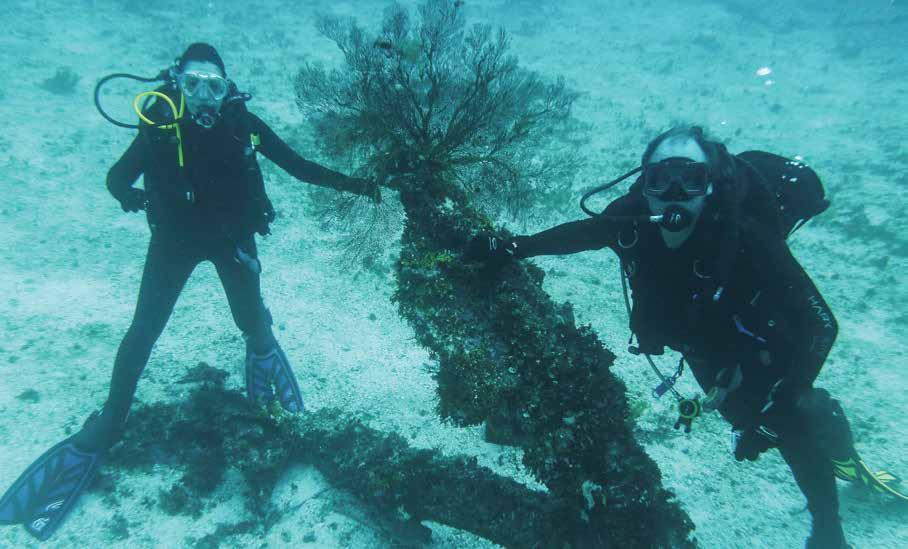
The Captain’s Circle is the museum’s new supporters’ group, established earlier this year to raise funds to acquire and preserve collection items and assist with museum projects. Members receive unique benefits, including invitations to exclusive VIP events, harbour cruises on heritage vessels and behind-the-scenes access to our collections. We are also seeking donations to our Migration Heritage Fund, writes Marisa Chilcott , Foundation Manager.
THE INAUGURAL EVENT for the prestigious Captain’s Circle was an evening on board MY Silentworld, the private vessel belonging to John Mullen, chairman of the Silentworld Foundation and a generous long-term supporter of the museum. Captain’s Circle members and other guests enjoyed exploring the 40-metre super-yacht before being treated to an overview of John’s adventures and discoveries in the field of maritime archaeology.
For many years the Silentworld Foundation and the museum have collaborated to search for and investigate historic shipwrecks. John explained how the Silentworld Foundation provides the boat and logistics, and museum staff are responsible for research. It has been a successful partnership –together they have found some famous and important wrecks, including Phillip Parker King’s ship Mermaid and the combat ship Royal Charlotte.
‘We start with a list of unknown shipwrecks or missing shipwrecks that we think are of significance to Australian history,’ said John. ‘There are at least 7,000 undiscovered wrecks in Australia. About 1,200 have been found, so it’s fertile ground.’
‘It was a privilege to attend the Captain’s Circle event on board Silentworld,’ said Dr Jeff Hughes, a new Captain’s Circle member, who attended the event with his wife Dennise: ‘It was inspiring to listen to someone who is so passionate about Australia’s early maritime archaeology.’
With the museum’s next exhibition Bligh – Hero or Villain? soon to open, guests were particularly interested in John and his wife Jacqui’s adventures exploring the wreck of HMS Pandora, the vessel sent in 1790 to search for the HMS Bounty mutineers.
Guest were enthralled to hear about the Mullens’ recent trip on Silentworld to Pitcairn Island. Also aboard was young Trent Christian, a direct descendant of Bounty mutineer Fletcher Christian, whom the Mullens took home to Pitcairn to visit family and friends.
Captain’s Circle members invest $3,000 or pay an annual instalment of $1,000 over three years. For more information, or to join, please go to sea.museum/support/donate/captainscircle or contact Marisa Chilcott, Foundation Manager, on 02 9298 3619 or 0422 345 426. A list of current Captain’s Circle members is on page 78.
01 John and Jacqui Mullen have been long-term supporters of the Maritime Museum, including through their Silentworld Foundation. The inaugural event for the Captain’s Circle was held aboard their ship MV Silentworld Image Xanthe Rivett/Silentworld Foundation
02
SY Ena in Darling Harbour. Image Andrew Frolows/ANMM
If a member of your family is featured on the Welcome Wall, we hope to be in touch soon to keep you informed of exciting new developments and opportunities.
To celebrate Australia’s rich migration heritage, the museum plans to build and develop an exciting array of new resources and to expand its programs. By supporting the Migration Heritage Fund, you will be helping to build our migration focus, which will promote a cohesive and harmonious multicultural society.
Of course, the best-known example of the museum’s commitment to honour and share our migration history is the Welcome Wall. On 24 January 2019, we celebrated the 20th anniversary of its founding. Since it began, more than 29,000 families have registered their family’s migration journey on the wall, providing an important tribute that celebrates the diversity of Australian migrants and their journey.
If you would like to include your family’s heritage on one of the beautiful bronze panels, please register your interest on our website at sea.museum/discover/welcome-wall.
We invite all members to contribute $100 towards the Migration Heritage fund:
• by donating on our website at sea.museum/support/donate
• by direct deposit to Account Name:
Australian National Maritime Museum Foundation
BSB: 062000
Account: 1616 9309
• by contacting Marisa Chilcott, Foundation Manager, on 02 9298 3619 and donating over the phone. All donations are tax deductible.
SY Ena was the glamour yacht of its time
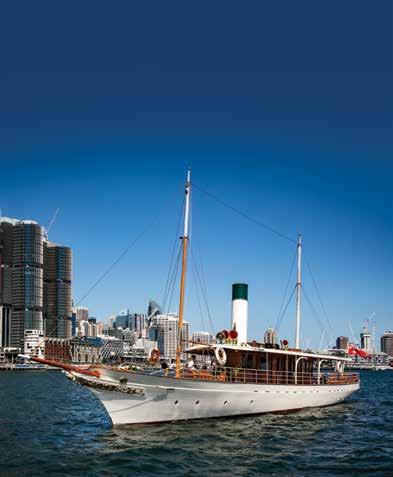
SY Ena returns to the museum
Captain’s Circle members will be among the first groups to enjoy a cruise on the museum’s magnificent Edwardian steam yacht SY Ena after its recent extensive overhaul. Curator of Historic Vessels David Payne once described Ena as ‘much more than a vessel – SY Ena is an artwork, a piece of craftsmanship, a fashion statement and an experience, with its pulsating steam engine setting a steady beat by which Ena can tell its long and engaging story.’
Ena, now 118 years old, was named after Thomas Dibbs’ wife, Tryphena. Dibbs commissioned the yacht’s construction, and upon completion SY Ena was the glamour yacht of its time. Lady Primrose Potter, a direct descendent of Dibbs, reported watching Dibbs and the governor regularly enjoying leisurely Sunday afternoon trips on the harbour. The museum became the custodian of Ena in July 2017 through the extremely generous donation of John and Jacqui Mullen. Ena is exceptionally significant as one of the nation’s most important late colonial and early Federation vessels.
SY Ena is now back in action and ready to resume its role in the museum’s fleet. Captain’s Circle members will be invited to a special event in the coming months to welcome the grand old yacht home.
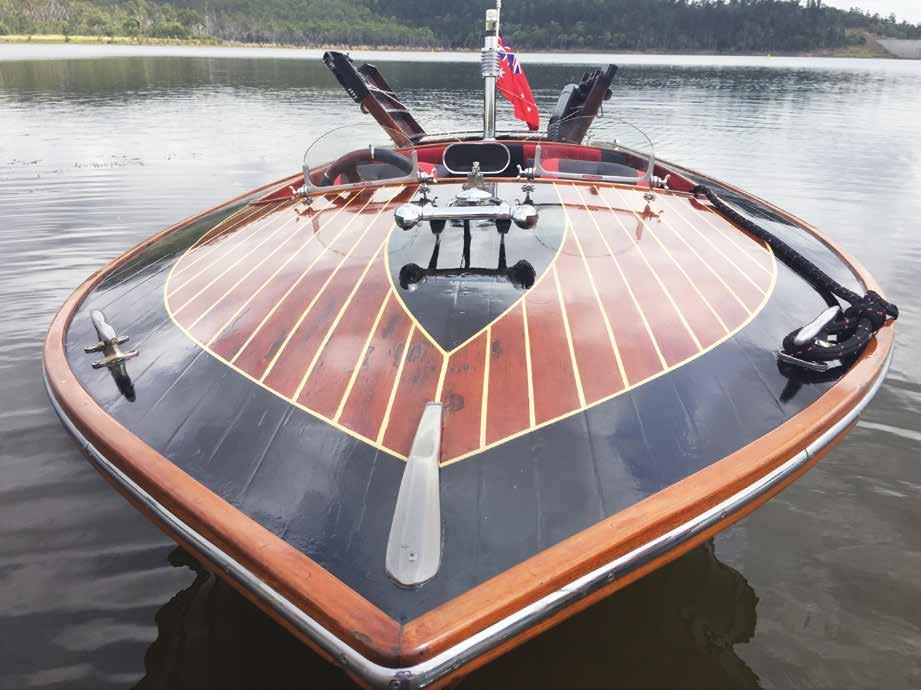
The diverse nature of the ARHV collection of nominated craft is highlighted again in the latest group of vessels to be included on the register. A Tasmanian dinghy from 1872, another of the Torres Strait luggers, motor launches and yachts – all these craft represent different types, periods and styles. Curator of Historic Vessels David Payne profiles two of them.
AMONG THE LATEST ROUND of craft to be nominated to the ARHV are two that provide a very distinct contrast in style and use: the ski-boat Riviera II and floodboat Water Baby. Built just over 80 years apart, they both represent their respective builders’ backgrounds and abilities to produce the craft they wanted, but for quite different reasons. Thanks to decisions made when they were built, both have survived events that have destroyed other craft.
Riviera II was built in 1959 by shipwright Harry Hammond in Sydney. Like many powerboat and ski-boat enthusiasts, he had admired the varnished wooden craft built by the Italian company Riva, so he set about building his own interpretation based around the classic Australian timber clinker speedboat, a style that had been developed after World War II.
Harry Hammond had been a shipwright at Garden Island in Sydney during the war. After the war he set up a boatbuilding business with his brother, but later ran the business himself. For as long as people can remember it was in Ada Avenue, Brookvale, on Sydney’s northern beaches, and Harry only built his craft to order. Each one was custom-built to the highest standard – in many ways these became the Rivas of Australia.
Harry Hammond’s craft, such as Riviera II, were an Australian interpretation of the varnished wooden craft built by the Italian company Riva
Riviera II, built from mahogany plywood, is thought to have been a prototype for Hammond, showing several innovations from which present-day ski-boat technology evolved. It had a 327-cubic-inch V8 engine and a new Haynes V Drive watercooled gearbox; a 125-litre fuel tank; a specially made ski pole with six independent free-wheeling turnbuckles; and an inflatable prototype rubber bladder in the bow to make the boat unsinkable.
Now restored, it still has many original features: the water-cooled gearbox – the only one known to exist; the rear special exhaust manifold with rubber flap to prevent water from entering the manifold (invented by Harry Hammond); and its Ford Prefect steering box under the bow with full-length brass steering rods front to back to operate the rudder and steering. It also retains the Jaguar Racing split windscreen as used in early-model race cars such as those of Jack Brabham; the original dashboard, dials and steering wheel; and the all-important rubber bladder.
Riviera II is now powered by a fully reconditioned crate motor from the USA, a 350 Chevy 5.7-litre V8 that can drive the vessel at up to 50 knots (90 km/h). Riviera II is privately owned and featured at the museum’s Classic & Wooden Boat Festival in 2018.
In contrast, Water Baby is an iron-plated steam launch with a probable top speed of under 10 knots (18 km/h). It was built near Millmerran, some 50 kilometres south-west of Toowoomba, Queensland, in 1878. Water Baby was designed by Francis Gore and then built by his blacksmith, John Patrick Purcell, at the Gore family’s Yandilla station. Like Hammond with Riviera II, Gore and Purcell knew what they wanted for Water Baby, but being well inland they had to rely on their self-sufficiency to make it happen.
Water Baby was used as a flood boat on the Condamine River and associated waterways until the family sold their holdings in 1911. It is believed to have been used by later owners of the station until at least the 1920s, but for many years after it seems it was not used, but still kept at the station. It was retrieved and put on display at a local show in 1955, and then left for 30 years out in the open before being found in poor condition. It was then restored for the 1988 Bicentenary. Water Baby is a rare surviving example of the many simple, successful craft designed and built inland by people with little or no background in boats.
Flooding was the major problem facing the Gore family, who had settled at Yandilla Station in 1841. Over the decades they undertook a series of drainage and channel works to alleviate the flood problems that beset the area from time to time. The first documented case of the Gore family using boats during floods was in 1873. Water Baby was built during 1876 to 1878, one of the longest drought periods on record at Yandilla, ready for the next flood. It was launched during the drought, but the drainage work already completed gave ample depth of water at the property for Water Baby to float.
The Darling Downs Gazette reported on the vessel soon after its launch on Monday 4 March 1878 at Yandilla. Its correspondent described seeing a fine little iron steamer 28 feet (8.53 metres) long, weighing 5 tons (5.09 tonnes) and powered by a 1.5 horsepower (1.12 kW) single-cylinder double-acting reversible steam engine of unknown origin. Water Baby could carry 12 passengers and was ‘as docile in her movements as a child’.
With the exception of the engine and boiler, everything else connected with the steamer was manufactured at Francis Gore’s blacksmith’s shop at Yandilla, only metres away from the edge of Grasstree Creek. Francis Gore designed the vessel and the engine, while blacksmith John Patrick Purcell was the ‘shipwright’. Water Baby ’s sheet-metal panels were lapped and tank-riveted together and the laps then soldered to make the wrought-iron hull watertight.
Versatility was important, too. During the longer periods between floods, the steam engine from Water Baby was used on a machine for boring post holes for stock fences.
During the next few years Water Baby, along with three additional 22-foot (seven-metre) boats they had built and which Water Baby towed, was used in flood time to rescue stock trapped by the rising waters. Legend has it that Water Baby went direct over the flooded plains from Yandilla homestead to Cecil Plains homestead, a distance of about 51 kilometres. Water Baby ’s flat bottom and shallow draft would have enabled it to navigate this route during the 1890 or 1893 floods – the highest recorded at Yandilla in the 19th century.
Francis Gore could not speak highly enough of Water Baby in its work. He wrote:
… the steam launch saved an immense amount of labour, towing the boats full of sheep and bedding etc. when required. No men could have pulled the load of sheep she towed for over half-amile dead against the current ... our three boats and steam launch were invaluable. Had we not had such a good fleet or had they been out of repair, we would have lost nearly all our stud rams and a lot of the sheep ... No station on the Condamine should be without them.
After the 1893 floods there appears to be no more documented evidence of Water Baby being used as a craft to rescue marooned sheep during floods. This probably came about when a flood warning system was developed along the Upper Condamine River Valley after 1890. Telegraphic communications were developed and eventually gave advanced warning so stock could be moved away from the flood waters before becoming trapped.
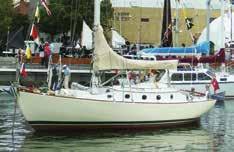

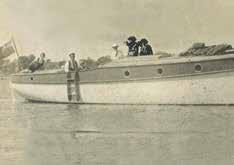


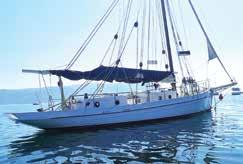
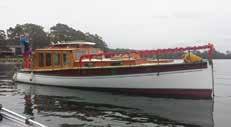
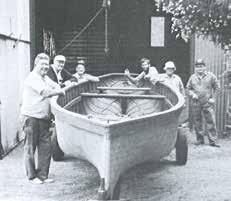
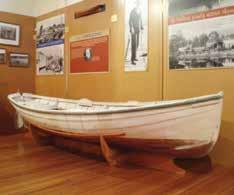
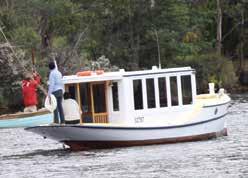


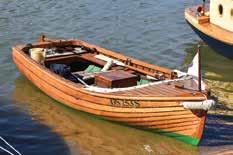

Water Baby was also briefly used as a postal boat. John Jacob Reichle (1875–1931) of Tummaville remembered how the steamer used to take the mails and mailman across the flooded Condamine River at Yandilla, where the mailman received a fresh horse to continue his journey to Back Creek (Millmerran). During the floods of March and April 1890, Gore & Co made a public offer to put anyone across the Condamine via their steamer and swim their horses if necessary.
Water Baby was then used sporadically by the Gores and later owners before being stored onshore. At one point the hull was used to store gravel outside the Yandilla homestead garden. In 1955 it was retrieved and put on show, but then put back and left for almost 30 years. In June and July 1983, when Back Creek was in flood, two Millmerran canoeists sighted the hull of Water Baby lying on the banks of the creek where it had been laid to rest in 1955.
Members of the Millmerran & District Historical Society investigated the find and considered its retrieval and restoration. In August of 1983 the society began planning to submit an application to the Queensland Council of the Australian Bicentennial Authority for the restoration of the hull as the society’s Bicentenary project for 1988. In 1986 the Bicentennial Authority approved a grant of $1,700 and this, together with further private funding, enabled the restoration to be completed, and the completed vessel now remains on display at the Millmerran Museum.
Water Baby probably owes its long-term survival to Gore and Purcell’s decision to use metal construction. Their choice was logical for an inland area; a metal boat would retain its shape and integrity through extended dry periods much better than a wooden craft, which would open up in the heat and low humidity. In addition, blacksmiths were always on hand for any repairs, and metal was the material that Gore and Purcell were familiar with.
Although corroded when finally taken in for restoration, enough had survived for the project to proceed so that a rebuilt Water Baby could tell its story.
Riviera II was wooden, but also owes it survival to its builder’s ideas. It moved on through different owners, but sadly was abandoned on the Murray River where one day it sank. However, due to Hammond’s buoyancy tube in the bow, the stem remained visible and it was rescued from the riverside. Eventually, under new owners, it was restored to its original condition. The tube is still there and may still contain air from 1959 – what could science learn from that?
Riviera II and its wooden cousins were eventually outdated in the marketplace by fibreglass production craft, while Water Baby was simply put out of a job by the telegraph and then the telephone – yet both survive today, restored to tell their own stories, and recognised by the ARHV.
This online, national heritage project, devised and coordinated by the Australian National Maritime Museum in association with Sydney Heritage Fleet, reaches across Australia to collect stories about the nation’s existing historic vessels and their designers and builders. Search the complete Australian Register of Historic Vessels at sea.museum/arhv
The 1848 Revolution in France led to the exodus of a unique group of refugee artisans now known as the lacemakers of Calais. Curator Kim Tao profiles the story of Edward Lander, chairman of a committee representing nearly 650 English laceworkers and their families, who sought a fresh start in the Australian colonies.
In the early 19th century, Nottingham, in the East Midlands, was an important centre for the production of machine-made lace. It was also a densely populated town of crowded tenements, deprivation and disease. In the early 1830s an outbreak of cholera and smallpox resulted in the deaths of 300 residents. The average age at death among the inhabitants of several Nottingham districts was just 14 or 15 years – the lowest of any city or town within the British Empire. In 1835 Edward and Mary Ann’s second eldest daughter, two-year-old Harriett, died from a childhood disease, most likely measles. With such conditions prevailing in Nottingham, it is little wonder that they decided to try their luck on the Continent.
IN MAY 1848, AS THE THREE-MASTED HARPLEY set sail from London down the River Thames, passenger Mary Ann Lander (née Simpson) went into labour with her eighth child. Perhaps it was due to anxiety about the long sea voyage to South Australia, or the thought of bidding a final farewell to Mother England. Regardless, the birth of baby Adelaide at sea was fortunate timing. Had she arrived any earlier, Mary Ann and her husband, English lacemaker Edward Lander, may have been ineligible to emigrate owing to the government’s restrictions on large families with young children. It would be the Lander family’s second migration in less than a decade.
Edward Little Lander (1811–1895) was the youngest of three children born to Captain John Hudden Lander and Mary Ann Little. Captain Lander was a leading English trader, primarily in grains, and his work took him across the Mediterranean, the Levant and the Black Sea. He led a peripatetic existence and was known to have resided at Odessa in southern Russia, Prussia, northern Russia, as well as Valletta in Malta, where Edward was born in 1811. Although Edward Lander was descended from a long line of seafarers who had made their living on the world’s oceans, he would establish his name in the machine-lace trade in Nottingham, in England’s industrial northern interior.
In 1816, at the end of the Napoleonic Wars (1803–1815), the Englishmen James Clarke, Robert Webster and Richard Bonnington dismantled a Leavers loom (lace machine) and smuggled the parts from Nottingham to Calais in northern France, where it was reassembled in a house on Quai du Commerce. More lace machines and laceworkers followed, despite the British government enforcing strict sanctions on both the exportation of its complex machinery and the migration of skilled artisans abroad. By the early 1840s there were some 1,500 English laceworkers in France, the majority in Calais, and the French city surpassed Nottingham as the centre of European lace manufacturing.
In 1842 Edward, Mary Ann and their four surviving children, Mary Ann, Edward, John and Emma, undertook their first migration, sailing across the English Channel to the port of Calais. They lived at Rue Vauban in the suburb of Saint-Pierrelès-Calais, where Edward was employed as an ouvrier en tulle (worker in tulle) for the English lacemaker Mr W Press. Sadly the move to Calais would not shield Edward and Mary Ann from further tragedy. In 1843 their eldest son, eight-yearold Edward, drowned while attempting to recover a gold coin he had dropped into one of Saint-Pierre’s many canals. The coin is thought to have been given to the young Edward by his grandfather, Captain Lander. Later the same year, Mary Ann gave birth to a daughter, Rosina. Another daughter, Clara, was born in 1845.


By the early 1840s there were some 1,500 English laceworkers in France, the majority in Calais
01
Edward Little Lander, c 1880. Reproduced courtesy Richard Lander
02
Mary Ann Lander (née Simpson), c 1880. Reproduced courtesy Richard Lander
03
Map showing lace factories in Calais, France, late 1800s. The Lander family lived at Rue Vauban in Saint-Pierre-lès-Calais, the area in the centre of the map, just south of the hôtel de ville (city hall). Reproduced courtesy Les archives départementales du Pas-de-Calais and Musée des Beaux-Arts et de la Dentelle
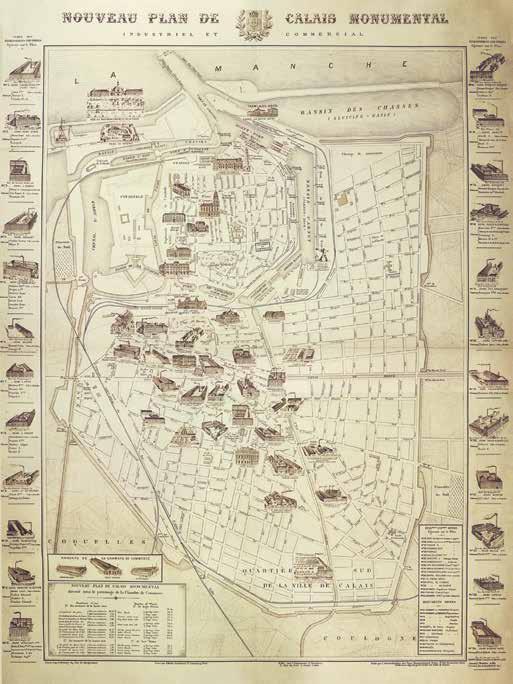
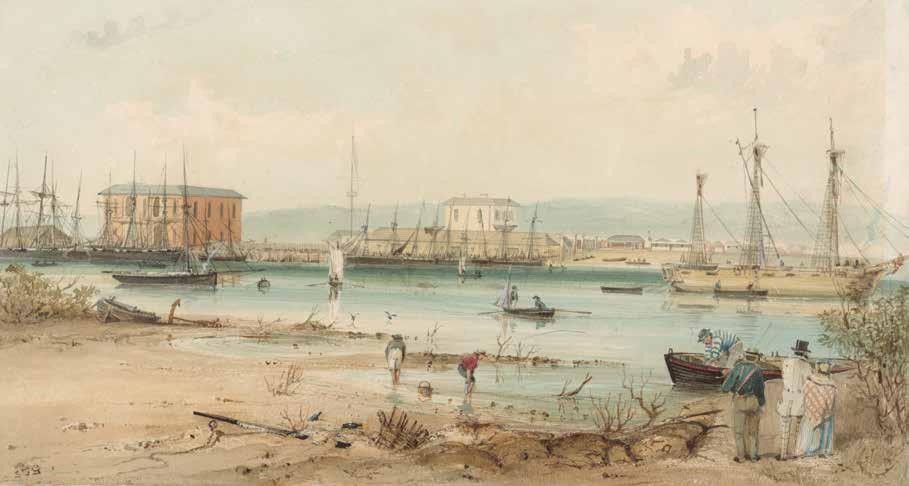
Both Rosina and Clara were born and raised against a background of industrial, economic and political turmoil in Europe, culminating in the French Revolution of February 1848. This resulted in the abdication of the ageing King Louis Philippe I and the establishment of the French Second Republic.
For English laceworkers such as Edward Lander, the prospects in France were bleak. The market for lace had collapsed, the Calais factories were closed and their masters returned to England. However, return was not feasible for workers like Edward, because of the already high levels of unemployment and destitution in Nottingham.
On 21 March 1848, as the plight of the lacemakers of Calais became increasingly desperate, a meeting was held at the English Church in Saint-Pierre-lès-Calais, at which Edward Lander was elected as the chairman of a small committee to represent the distressed laceworkers. The committee prepared a petition proposing their ‘emigration to one of the British colonies, South Australia preferred, where workmen are scarce and labour wanted, our experience having shown us the great advantage they possess who live under the protection of the British Government.’1 The petition was accepted by Edward Bonham, the British Consul in Calais, who forwarded it to the British government with a list of 642 men, women and children wishing to resettle in the Australian colonies.
The British authorities expressed some initial reservations about their suitability as emigrants. There was a large number of families with young children – indeed, more than half of the prospective emigrants were children, and a third were under the age of 10. Furthermore, the men practised a trade that was deemed of little value to the colonies, where the immigrants most in demand were agricultural labourers, shepherds and domestic servants.
But the government was ultimately persuaded by the support of the British Consul in Calais, and the understanding that the laceworkers would place a significant burden on their own parishes if they went back to England. Nottingham’s workhouses were overflowing with people who were unable to provide for themselves.
An agreement was reached and appeals were launched in London and Nottingham to raise part of the funds required to assist their emigration. Eventually 575 laceworkers and their families were approved for emigration. 2 They were transported from Calais to London and Plymouth to prepare for embarkation on one of three vessels: Fairlie departing in April, Harpley in May and Agincourt in June. Edward, Mary Ann and their five surviving children, Mary Ann (17), John (10), Emma (eight), Rosina (four) and Clara (three), embarked from Deptford, in south-east London, on the square-rigged Harpley on 12 May 1848.
The lacemakers of Calais had made a timely departure from France, just before the second phase of the 1848 Revolution.
On 23 June 1848, in a brief but bloody rebellion known as the June Days uprising, French workers staged a massive demonstration at Place de la Bastille in Paris. Over the next three days, more than 10,000 demonstrators and troops were killed or injured. The Revolution was over, and in December 1848, a new parliament was elected with Louis Napoléon Bonaparte as President of the Second Republic.
By this time, the Landers had settled in South Australia, having arrived at Port Adelaide on 2 September 1848 after 113 days at sea. In Adelaide it is believed that Edward was employed as a school teacher in the suburbs of Birkenhead and Thebarton, before joining the South Australian metropolitan police force in March 1849.
The lacemakers practised a trade that was deemed of little value to the colonies, where the immigrants most in demand were agricultural labourers, shepherds and domestic servants
Watercolour of Port Adelaide, South Australia, by Samuel Thomas Gill, 1840s. Rex Nan Kivell Collection, National Library of Australia nla.obj-134655619. Reproduced with permission
In May 1849, tragedy struck the Lander family once again when one-year-old Adelaide, born on the day that Harpley sailed from England, died from exhaustion related to whooping cough and diarrhoea. In October 1851, Mary Ann gave birth to her ninth child, Herbert, in Thebarton.
In February 1852, Edward resigned from the South Australian police force and spent a few years farming at Thebarton and Riverton, before moving the family to rich farming land in the Western District of Victoria. By then Edward and Mary Ann had lost three of their nine children: Harriett in Nottingham in 1835, Edward in Calais in 1843, and baby Adelaide in Adelaide in 1849. Their eldest daughter, Mary Ann, married John Ottaway in 1850 and the couple had 13 children. Edward and Mary Ann’s eldest surviving son, John, worked as a bricklayer in the Riverton area and later accompanied his brother-in-law, John Ottaway, to the goldfields in Victoria. John Lander married Eliza Kook and they had 14 children. Eliza was the daughter of German immigrant Hermann Kook, who surveyed and set out the township of Hahndorf in the Adelaide Hills in 1839.
Edward and Mary Ann’s second-eldest surviving daughter, Emma, married Benjamin Boothey in 1861 and they had 13 children. Rosina married Thomas Templeton and had 12 children; Clara married Robert Chapman and had seven children; and Herbert, Edward and Mary Ann’s youngest son, married Christina McIntyre and had one child.
For 20 years, the Welcome Wall at Pyrmont Bay Wharf has celebrated and recorded the stories of those who left their native shores to make Australia home. The museum is planning a renewal of this project, with a new launch in 2020. If you wish to be informed when registrations re-open, please leave your contacts through our website: sea.museum/welcomewall
After the passage of the Crown Lands Alienation Act 1861 (allowing free selection of crown land), the Lander family made their final move from Victoria to New South Wales, taking all their personal belongings, livestock and farming equipment. The family probably followed a route from Coleraine through the towns of Hamilton and Dunkeld, around the eastern foothills of the Grampians to Ararat, Maryborough, Castlemaine, Bendigo and Echuca, before crossing the Murray River into New South Wales. By 1876, the extended Lander family was settled on land at Darlington Point in the Riverina district of south-western New South Wales, where they would make their living over the next century as graziers raising Merino sheep.
Edward Little Lander, lacemaker and grazier, died in 1895. His name was registered on the Welcome Wall by his greatgreat-grandson Richard Lander, who is a foundation member of the Australian Society of the Lacemakers of Calais. Richard is forever grateful that his great-great-grandfather, Edward, had the courage and foresight to emigrate with his family to Australia. His name on the Welcome Wall is a small recognition of that courage.
1 House of Commons, Papers Relative to Emigration to the Australian Colonies , 1848, vol 47, pp 97–98.
2 Authorities made the decision to reject families with three children under the age of seven, or five or more children aged 10 or younger. Edward and Mary Ann Lander had two children under seven and four children aged 10 or under, and thus satisfied the rule.
The author wishes to thank Richard Lander for his assistance with this article.
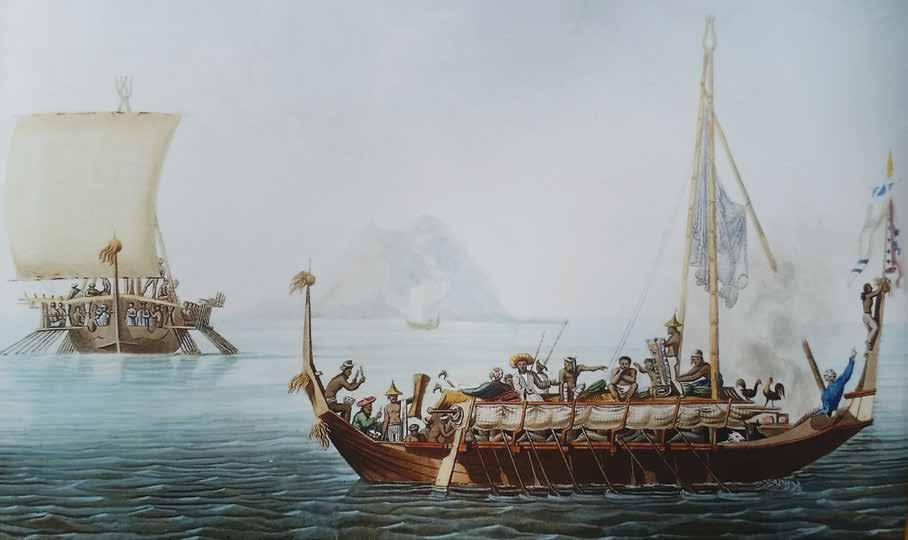
IMMEDIATELY TO THE NORTH-WEST OF AUSTRALIA, occupying an area somewhat larger than our island continent, are the homelands of the pre-modern world’s most accomplished and farthest-ranging oceanic explorers, migrant settlers and traders. They occupy much of South-East Asia, while their outlying settlements stretch from Madagascar to Easter Island and Hawaii. Active and afloat across the Asian–Indian region for millennia, with maritime mercantile ventures that reached northern Australia in pre-colonial centuries, these seafaring people are collectively, culturally and linguistically called ‘Austronesians’.
They are, it’s safe to say, little recognised as a distinct grouping among most Australians or the wider world, except by specialist historians, archaeologists, ethnographers and linguists. Philip Bowring wants to change that with this book, which is an intensely researched and detailed account of these quintessential seafaring and trading societies, from their prehistoric origins until now.
In particular Bowring wants the ‘general reader and public’ to appreciate their dynamic role in the networks of oceanic trading that stretched from Asia across the Indian Ocean to the Mediterranean for thousands of years, and that led directly to the last half millennium of European expansion and to today’s globalised economy.
Austronesians comprise most of the populations of modern Indonesia, Malaysia and the Philippines, speaking hundreds of different but related languages. The ethnic Thais, Cambodians, Laos, Vietnamese and Burmese of mainland South-East Asia are not Austronesians, nor are they primarily seafaring societies – the thing that most defines Austronesian heritage. So, to avoid confusion, Bowring has coined a new term, Nusantarians, to describe Austronesians living, sailing and trading within the wider region of South-East Asia. The term comes from the Sanskrit/Malay/Indonesian nusantara, referring to the archipelagos that stretch between mainland China and South-East Asia towards Australasia.

Philip Bowring, published by I B Taurus, London, 2019.
Hardcover, 317 pages, photographs, maps, footnotes, bibliography and index.
ISBN 9781788314666
RRP $45 Members $40.50
A major defining feature of Nusantarian societies was their mastery of navigation and ingenious vessel technologies, which included outriggers, unique fore-and-aft sails and hull construction techniques that distinguished them from the Arab, Persian, Indian, Chinese and (much later) European ships that also plied these seas. Other original features of Nusantarian societies included ancestral cults and shamanism, headhunting, and the independence and high standing of their women.
From ancient times their islands supplied key trade commodities, including the rarest and most costly spices, exported in their own ocean-going ships. Their home waters were the crossroads of sea trade between the Far East and the Indian Ocean. Controlling these sea lanes led to the rise of diverse Nusantarian trading centres, kingdoms and empires in Sumatra, Java, Malaya and elsewhere in their region. Bowring depicts a cosmopolitan trading world exchanging ceramics, metals, gems, silks and other textiles, spices, forest products and slaves – the vast majority by sea.
‘A Persian writing in Arabic in the tenth century,’ he tells us, ‘noted that parrots in Palembang [the Sumatran centre of the Srivijaya empire] could speak many languages including Arabic, Persian and Greek.’
The major religions of Hinduism, Buddhism and Islam came peaceably, by trade and influence. They were transformed by, as much as transforming, Nusantarian societies. Rare seaborne invasions by the Tamil–Indian Cholas in 1025, and later Mongol and Ming ‘interventions’, made no lasting impacts due to the dispersal of the islands and the skills of their sailors and traders. European (and with them, Christian) incursions began more forcibly five centuries ago, lured by the fabulous wealth of the ‘Spice Islands’. This would eventually lead to a huge downturn of Nusantarian fortunes and a loss of common identity as they were fragmented into the post-colonial states we know today. Bowring makes the valuable point that it’s easy to exaggerate the effect of the first few centuries of European activity, as disruptive as it was. It was not until ‘a final land-grabbing spasm around the turn of the 20th century that European imperialism reached its final apogee’, drawing Nusantaria’s modern borders.
Journalist, author and yachtsman Philip Bowring has lived in Asia for decades as a correspondent for leading financial and international newspapers, and was editor of the prestigious Far Eastern Economic Review. An earlier book was about a distant ancestor, Sir John Bowring, who as Plenipotentiary in China in 1856 precipitated the Second Opium War, and who negotiated a key trade treaty between Britain and King Mongkut (of Anna and the King of Siam fame).
Having read history at Cambridge and, during his working life, absorbed himself in the history and economy of maritime Asia, Philip Bowring is well placed to attempt this ambitious synthesis of vast amounts of scholarship. Its magnitude is attested by a nine-page bibliography. Given the wide-ranging breadth and depth of scholarship consulted, errors (in this reviewer’s fields of expertise, at least) were few and minor.
At times the work suffers from the formidable weight of historical detail, unfamiliar to most readers, that it encompasses. There are occasions where condensing complex events and multiple players creates sentences that are too enigmatic to fathom, unless you’re already well-versed in that history. Places, people or processes can sometimes flash by, for the first and last time, unexplained.
A reader finding themselves a bit lost in the detail might return to the contents list, which has been well constructed with snappy chapter titles, each given a clear and indeed inviting 30-word synopsis. This can be read both as a foreword and summary.
The attractive illustrations in both colour and mono have been very well selected for variety and quality, with many outstanding works of art, artefacts and historical sources. They are only rarely referenced in the text, however, so their relevance may not always be clear to readers unfamiliar with the subject. Maps are detailed and informative but some might have been reproduced larger-scale for easier scrutiny.
This hardcover book is handsomely produced with a beautiful dust jacket showing fine Nusantarian galleys in the Moluccas, recorded by the Louis de Freycinet expedition of 1817–20. It’s a volume for readers who would like a deeper understanding of the vibrant maritime peoples and events that unfolded literally on Australia’s tropical northern doorstep, to better appreciate the complex development of the human, political and economic region that we inhabit.
Reviewer Jeffrey Mellefont is an Honorary Research Associate of the museum and the former editor of Signals
THE MUSEUM WAS SADDENED TO HEAR of the death in October last year of one its major collection supporters.
John Hooke CBE – businessman, philanthropist and science advocate – made a significant gift to the National Maritime Collection in the field of Antarctic exploration and adventure. After his death, his legacy has continued with the gift of more historic material in his memory from his wife Maria Teresa Hooke OAM and sons John Max and Paolo.
The material includes personal papers, photographs, records and memorabilia associated with one of the greatest Antarctic adventures of all time – the ambitious Imperial Trans-Antarctic Expedition (ITAE) of 1914–17, led by Sir Ernest Shackleton. These items illuminate the part played in the expedition by an 18-year-old wireless operator, Lionel (later Sir Lionel) Hooke, aboard the supply vessel SY Aurora. Lionel Hooke was John Hooke’s father, a man whose resourcefulness and inventiveness carried him from the Antarctic to chairman of Amalgamated Wireless Australasia (AWA), a role that his son John was to assume on Lionel’s death in 1974.
Lionel Hooke (1895–1974) was appointed to the expedition on the recommendation of his employer Marconi, later AWA (Amalgamated Wireless Australasia). He sailed from Hobart in late December 1914 with the Ross Sea party, tasked by Shackleton to sail to McMurdo Sound to sledge inland and lay deposits of food and fuel for him and his crossing party, who would approach from the Weddell Sea.
Shackleton hoped to be the first to cross Antarctica, but famously it was not to be. Both the expedition’s ships, Endurance and Aurora, became trapped in the ice. Endurance was crushed. Aurora survived, but broke its moorings during a blizzard in May 1915, abandoning ten men at McMurdo Sound, including expedition leader Aeneas Mackintosh. Hooke was one of 18 men trapped on the ship, which drifted in ice for nine months.
01 Items donated by the Hooke family, including original wireless transmissions, Sir Lionel’s polar medal and photographs of Aurora in Port Chalmers, New Zealand, in 1916. ANMM Collection Gift from Maria Teresa Hooke OAM and her sons John Max and Paolo in memory of John Hooke CBE and Sir Lionel Hooke
02 John Hooke CBE , with Maria Teresa Hooke OAM and son John Max with the Aurora lifebuoy at the launch of the Plucky Little Ship Aurora exhibition in June 2017. The lifebuoy, a gift from John Hooke in memory of his father Sir Lionel, features the initials of the ship’s two expeditions in Australia – AAE (Sir Douglas Mawson’s Australasian Antarctic Expedition, 1911–14) and ITAE (Sir Ernest Shackleton’s Imperial Trans-Antarctic Expedition, 1914–17).
Images Andrew Frolows/ANMM
After repeated attempts, Hooke finally established wireless contact with the Naval Radio Station at Williamstown, Victoria, as the vessel was freed from the ice in March 1916 and made its way towards New Zealand under jury rig. At the time, the ship was at least five times beyond the normal range of its transmitting equipment. The New York Times reported on 14 May 1916 that young Lionel Hooke was widely applauded for his persistence and resourcefulness in continually overhauling his limited equipment, especially when jury-rigging an aerial to ice hummocks after a blizzard carried away the masthead aerial on 5 September 1915.
Aurora arrived in Port Chalmers on 2 April 1916. While it was under repair, plans were made for a relief voyage to the Ross Sea. Under the command of John King Davis, Aurora sailed south and rescued the marooned men at Cape Evans in January 1917.
Hooke did not join the rescue party. He had left the ship in Hobart and sailed to the UK to enlist in the Royal Naval Volunteer Reserve and, following this, the Royal Naval Air Service.
Returning to Australia and AWA in 1919, Hooke’s interest in research and development saw him transmit the first live radio broadcast in 1920, from his home in Brighton, Victoria, to the state’s Parliament 19 kilometres away.
During World War II, Sir Lionel channelled AWA’s resources to enabling communications for Australian and American forces in the Pacific. In 1945 he became managing director of AWA, and in 1962 its chairman. He was awarded a knighthood in 1957 for his services to industry and coronation medals in 1937 and 1953.
The donations relate to the ambitious Imperial Trans-Antarctic Expedition of 1914–17, led by Sir Ernest Shackleton
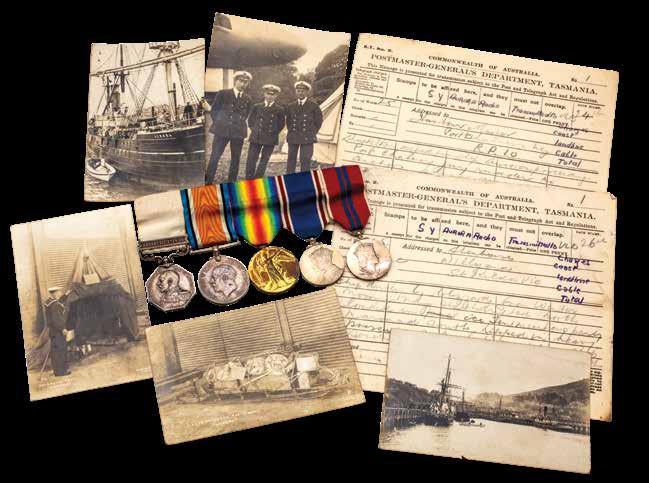
In 1918 Hooke was awarded a silver polar medal with clasp for services on the ITAE. His ship Aurora, the former Arctic sealer and whaler that had, before Shackleton, carried Sir Douglas Mawson’s Australasian Antarctic Expedition, was sold as a coal tramp. The 41-year-old vessel disappeared in June 1917 en route from Newcastle to Chile.
The only remnant of the wreck was a lifebuoy plucked from the seas six months later, off the New South Wales north coast. It was presented to Sir Lionel Hooke and given in 2017 to the National Maritime Collection by his son John.
John Hooke CBE shared his father’s spirit of resourcefulness and intellectual adventure, but now in television, not wireless. In 1954 he screened the first experimental television broadcast in Australia, from an Arnott’s van. Later he provided the signal that relayed the first moon landing. His career included executive roles at AWA, BHP, AMP General Insurance and Channel Ten. In later years he provided a substantial donation to his alma mater to help establish the University of Sydney Nano Institute. Flagship programs include the development of nanoscience robots to diagnose and treat disease on a molecular level. The significant support that John Hooke CBE offered the museum, alongside that of his family, has added depth and excitement to our Antarctic collections – original primary material from the experience of the Ross Sea Party, and the lifebuoy from its famous ship, SY Aurora. This, with Sir Lionel’s polar and civic awards, the ITAE photograph album and the tranche of urgent wireless transmissions from a vessel and its 18 men lost to the world, are among its gems. Vale John Hooke CBE

THE SYDNEY MODEL SHIPBUILDERS CLUB is hosting its seventh annual exhibition of ship models on Saturday 24 and Sunday 25 August.
Six model shipbuilding clubs are participating, each with a different focus, ensuring a great variety of models on display. These range from 16th- and 17th-century warships, clipper ships and contemporary warships.
Some models are built for display only, while others are radiocontrolled and regularly sailed. This year we hope to have a display of working models of Sydney ferries as a special treat.
Modellers use a variety of materials, including wood and plastic. Many models are scratch built, while others have been constructed from kits. Last year more than 100 models were exhibited, and even more are expected this year.
The 2019 Expo will be held at the Georges River 16-Foot Sailing Club, Sanomi Avenue, Sandringham, from 10 am to 5 pm on Saturday 24 August and 10 am to 3 pm on Sunday 24 August.
Admission is free and all ages are welcome. The expo makes a great day out for all the family.
If you would like more information on the expo or the club, please contact Michael Bennett on 0411 545 770 or mjbennett@ozemail.com.au.

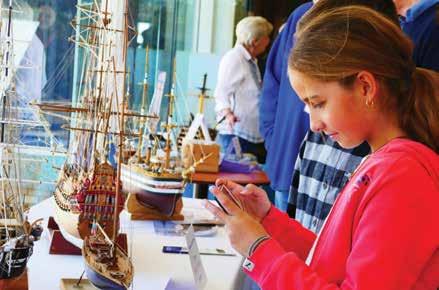
01, 02
and
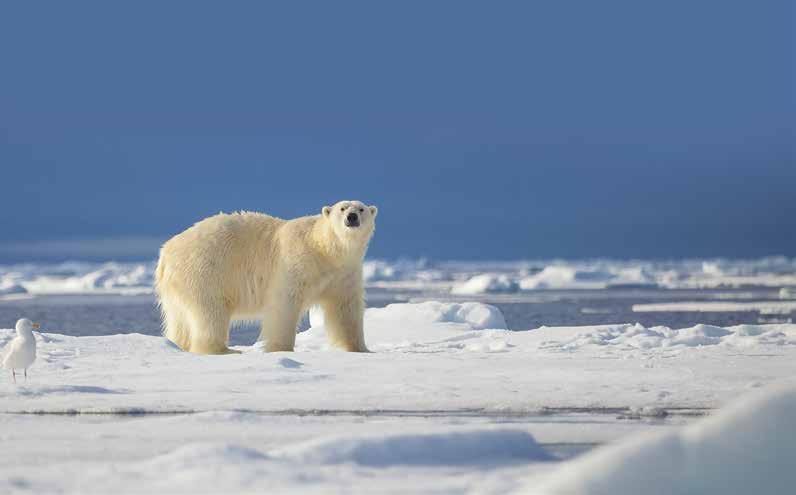
For more information 1800 637 688 (Freecall), visit auroraexpeditions.com.au or contact your local travel agent









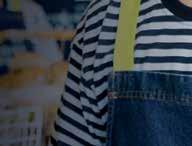


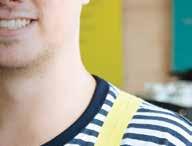


The Australian National Maritime Museum acknowledges the support provided to the museum by all our volunteers, members, sponsors, donors and friends.
The museum particularly acknowledges the following people who have made a significant contribution to the museum in an enduring way or who have made or facilitated significant benefaction to it.
Honorary Fellows
RADM Andrew Robertson
AO DSC RAN (Rtd)
John Mullen
Ambassador Christine Sadler
Dr Kathy Abbass
Robert Albert AO RFD RD
Bob Allan
Vivian Balmer
Vice Admiral Tim Barrett
AO CSC
Maria Bentley
Mark Bethwaite AM
Paul Binsted
Marcus Blackmore AM
John Blanchfield
Alex Books
Ian Bowie
Ron Brown OAM
Paul Bruce
Anthony Buckley
Richard Bunting
Capt Richard Burgess AM
Kevin Byrne
Cecilia Caffrey
Sue Calwell
RADM David Campbell AM
Marion Carter
Victor Chiang
Robert Clifford AO
Helen Clift
Hon Peter Collins AM QC
John Coombs
Kay Cottee AO
Helen Coulson OAM
Vice Admiral Russell Crane
AO CSM
John Cunneen
Laurie Dilks
Anthony Duignan
Leonard Ely
Dr Nigel Erskine
Dr Kevin Fewster AM
Bernard Flack
Daina Fletcher
Sally Fletcher
CDR Geoff Geraghty AM
Tony Gibbs
RADM Stephen Gilmore
AM CSC RAN
Paul Gorrick
Lee Graham
Macklan Gridley
Sir James Hardy KBE OBE
RADM Simon Harrington AM
Gaye Hart AM
Peter Harvie
Janita Hercus
Robyn Holt
William Hopkins
Julia Horne
RADM Tony Hunt AO
Marilyn Jenner
John Jeremy AM
Vice Admiral Peter Jones
AO DSC
Hon Dr Tricia Kavanagh
John Keelty
Ian Kiernan AO
Kris Klugman OAM
Jean Lane
Judy Lee
Keith Leleu OAM
Andrew Lishmund
James Litten
Tim Lloyd
Ian Mackinder
Casimiro Mattea
Jack McBurney
Bruce McDonald AM
Lyn McHale
Arthur Moss
Patrick Moss
Rob Mundle OAM

Alwyn Murray
Martin Nakata
David O’Connor
Gary Paquet
Prof John Penrose AM
Neville Perry
Hon Justice Anthe
Philippides
Peter Pigott AM
Len Price
RADM Neil Ralph AO DSC
Eda Ritchie AM
RADM Andrew Robertson
AO DSC RAN (Ret)
John Rothwell AO
Kay Saunders AM
Kevin Scarce AC CSC RAN
David Scott-Smith
Sergio Sergi
Mervyn Sheehan
Ann Sherry AO
John Simpson
Shane Simpson AM
Peter R Sinclair AC KStJ (RADM)
Peter John Sinclair AM CSC
John Singleton AM
Brian Skingsley
Eva Skira
Bruce Stannard AM
J J Stephens OAM
Michael Stevens
Neville Stevens AO
Dr Andrew Sutherland AM
Hiroshi Tachibana
Frank Talbot AM
Mitchell Turner
Adam Watson
Jeanette Wheildon
Mary-Louise Williams AM
Nerolie Withnall
Captain’s Circle Members
Dan Janes
Jonathon Casson
Mark Bethwaite AM
John Jeremy AM
Dawn Bradner
William Hopkins OAM JP
Louise Taggart
David Mathlin
Hon Margaret White
Arlene Tansey
Jeff Hughes
Judy Lee
Jaz Stephens OAM
David N Blackley
Peter Poland
Campbell Edmondson
Honorary Research
Associates
Lindsey Shaw
Jeffrey Mellefont
Paul Hundley
Rear Admiral Peter Briggs
Ian MacLeod
Signals 126 – Errata In Signals 126 (Autumn 2019), page 61, we published an incorrect and misattributed image. The image was of the launching of HMAS Vampire, not HMAS Voyager, and was taken by a Sydney Morning Herald photographer on 27 October 1956. It was not provided by the Australian War Memorial. The correct image is shown at left: the launching of HMAS Voyager on 1 March 1952, image courtesy Royal Australian Navy.
On page 26 of Signals 126 another image was wrongly captioned; the submarine shown is HMAS AE2 arriving at Portsmouth, UK, to prepare for its voyage to Australia, not HMAS AE1 as stated.
On page 34 of Signals 126, the image of the Norfolk replica under sail was taken by Peter Hodgson.
We apologise for these errors and thank John Jeremy, Peter Briggs and Tony Hodgson for pointing them out to us and for providing the correct details.

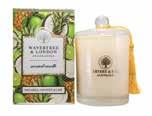


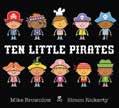

Plantain leaf scarf
Beautiful printed polyester scarf featuring a design of plantain leaves. Length 186 cm, length 90 cm (including tassels).
$29.95 / Members $26.95
Wavertree & London candles
Natural soy wax candles, triple-scented for a long-lasting fragrance. Hand poured in Australia; 60 hour burn time. Lemongrass and lemon myrtle or pineapple, coconut and lime.
$35.00 / Members $31.50
Picturing the Pacific
Features oil paintings, watercolours, drawings, prints and other documents from Joseph Banks’s voyages. A unique glimpse into an age in which science and art became irrevocably entwined.
$49.95 / Members $44.95
Native flower candle holder
Hand-made from glass and inspired by our nation’s favourite native flowers. Choose from kangaroo paw, waratah, flowering gum and banksia. Diameter 11 cm.
$35.00 / Members $31.50
Ten Little Pirates
Ten little pirates go to sea in search of adventure. But what will they do when they meet a hurricane, a giant squid and a hungry shark? For ages 3 and up.
$16.95 / Members $15.25
Ten Little Mermaids
A rhyming counting story with cute characters that disappear one by one each time a page is turned! Where did they go? For ages 3 and up.
$18.00 / Members $16.20


Or shop online at
Wildlife Photographer of the Year: Portfolio 28
Displays the full collection of 100 images awarded in the 2018 competition. Each is accompanied by the story of how it was taken and what it reveals.
$55.00 / Members $49.50
Museum logo cup
Artisan blown glass, anti-splash ergonomic design, thermal silicone sleeve, 240 ml. Width (base) 60 mm, height (with lid) 108 mm. Choose from black, aqua or purple.
$29.95 / Members $26.95
Signals
ISSN 1033-4688
Editor Janine Flew
Staff photographer Andrew Frolows
Design & production Austen Kaupe
Printed in Australia by Pegasus Print Group
Material from Signals may be reproduced, but only with the editor’s permission.
Editorial and advertising enquiries
signals@sea.museum
Deadline mid-January, April, July, October for issues March, June, September, December
Signals is online
Search all issues at sea.museum/signals
Signals back issues
Back issues $4 each or 10 for $30
Extra copies of current issue $4.95
Call The Store 02 9298 3698
Australian National Maritime Museum
Open daily except Christmas Day 9.30 am to 5 pm (6 pm in January)
2 Murray Street Sydney NSW 2000 Australia. Phone 02 9298 3777
The Australian National Maritime Museum is a statutory authority of the Australian Government
Become a museum Member
Benefits include four issues of Signals per year; free museum entry; discounts on events and purchases; and more.
Visit sea.museum or phone 02 9298 3646. Corporate memberships also available.
@seamuseum_
/anmmuseum
#seamuseum
sea.museum/blog
ANMM Council
Chairman Mr Peter Dexter AM FAICD
Director and CEO Mr Kevin Sumption PSM
Councillors
Mr David Blackley
The Hon Ian Campbell
Hon Justice S C Derrington
Mr John Longley AM
Rear Admiral Jonathan Mead AM RAN
Mr John Mullen
Ms Alison Page
Ms Arlene Tansey
Dr Ian Watt AC
The Hon Margaret White AO
American Friends of the Australian National Maritime Museum
Chair Peter Collins AM QC
Director Robert Moore
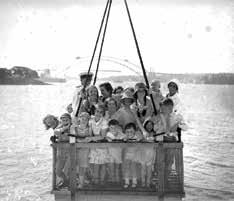
Congratulations to Greg Wane, who won the Signals 126 caption competition with this entry: ‘We are looking forward to our first shark-cage adventure!’

Foundation partner
ANZ
Major partners
Nine Entertainment
NSW Ports
Partners
ACFS Port Logistics
AMSA
Aurora Expeditions
Colin Biggers & Paisley
Commonwealth Superannuation
Corporation
Confucius Institute
Cultural Foundation Ekaterina
Destination NSW
Douglas Fabian Productions
DP World
Gordon Darling Foundation
Hong Kong Maritime Museum
Laissez-Faire Catering
Maritime Container Services
Musée Océanographique de Monaco
National Museum of China
Ovolo
Parkview Museum
Royal Wolf Holdings Ltd
Shipping Australia Limited
Smit Lamnalco
Sydney by Sail Pty Ltd
Sydney Morning Herald
Torch Media
Transport for NSW
White Umbrella
Wildaid
Signals is printed in Australia on Hannoart Plus Silk 250 gsm (cover) and Hannoart Plus Silk 115gsm (text) using vegetable-based inks.


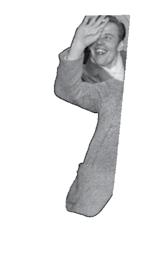
Support the Migration Heritage Fund

More than 10 million people have travelled to Australia seeking a better life. Today more than half of us have at least one parent who was born overseas!
The Australian National Maritime Museum is right beside the docks where many immigrants disembarked to start new lives, so is uniquely placed to tell the story of our migration history. By supporting the museum’s new Migration Heritage Fund, you will ensure that our migration stories are showcased, gaining the focus they deserve.
Your tax-deductible gift will help redevelop the migration heritage precinct, upgrade permanent galleries and improve facilities to provide new insights into who we are as Australians today.
Thank you for helping us promote a cohesive and harmonious multicultural community.
Make a direct deposit to: ANMM Foundation BSB: 062000 Account: 16169309
Phone (02) 9298 3619 (during business hours)
Or donate on line: sea.museum/support/donate/themigration-heritage-fund
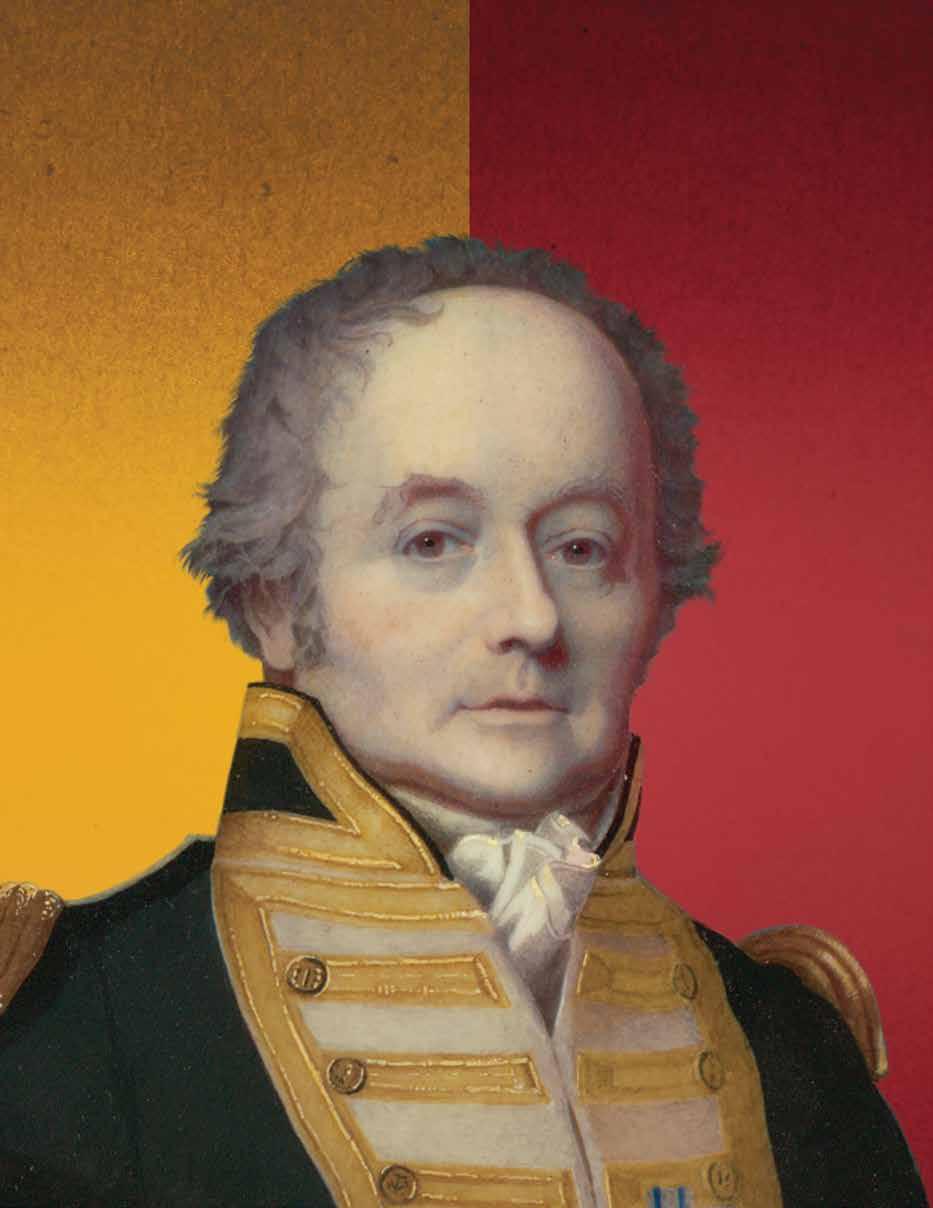
Celebrated, vilified, cast adrift.
Make up your own mind.
Opens 26 July
sea.museum/bligh
Manipulated Portrait of Rear-Admiral William Bligh. Courtesy National Library of Australia.